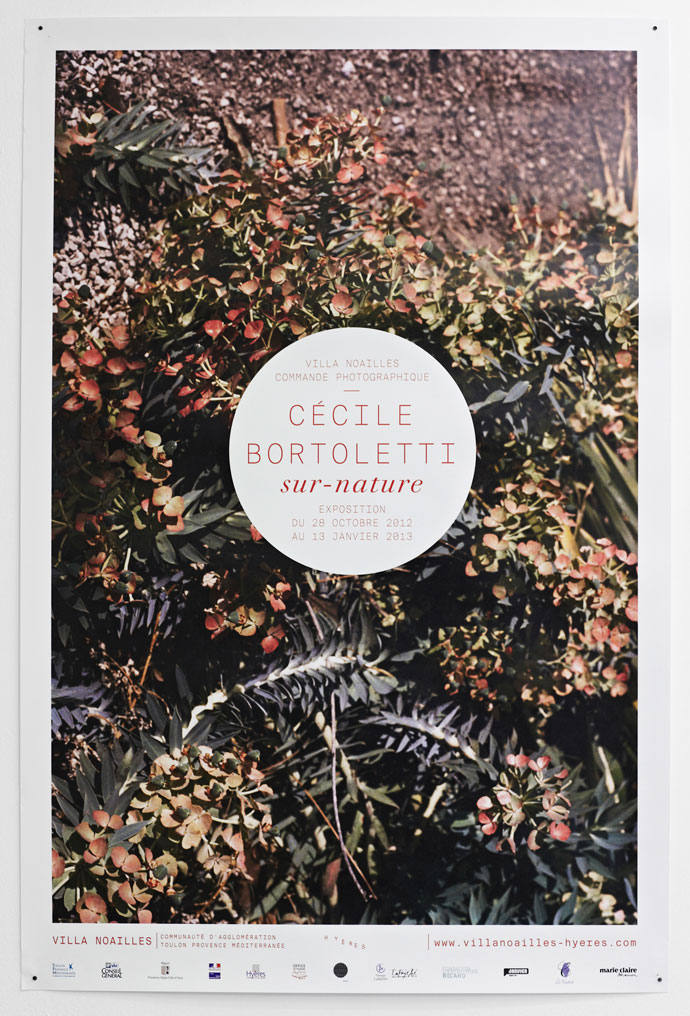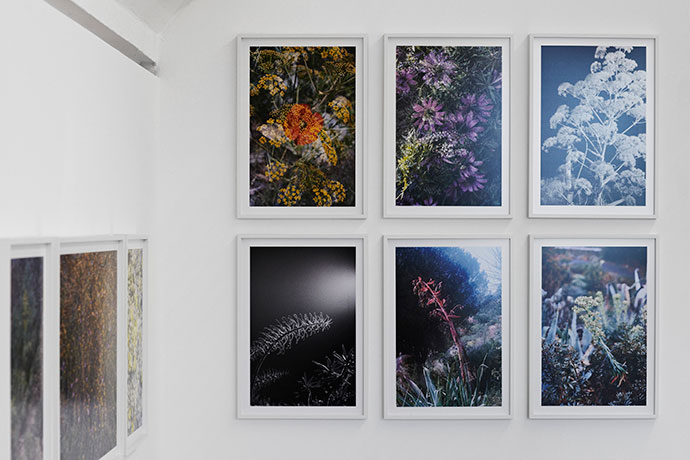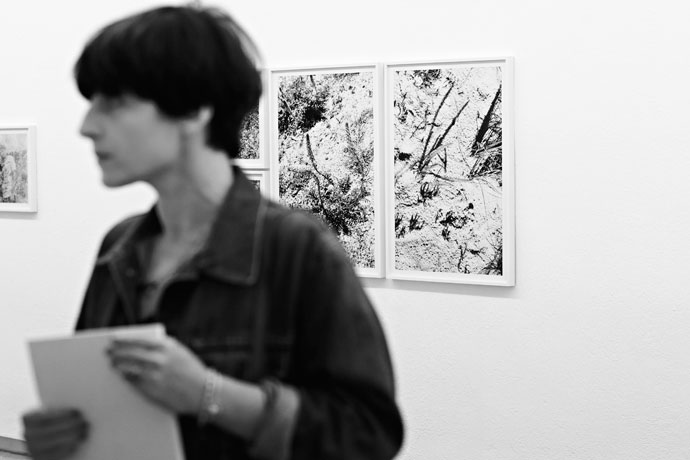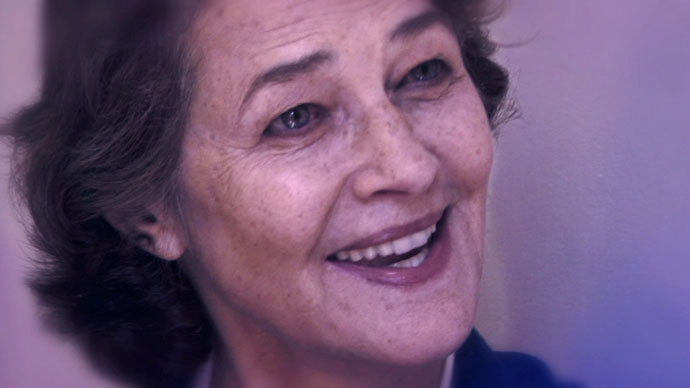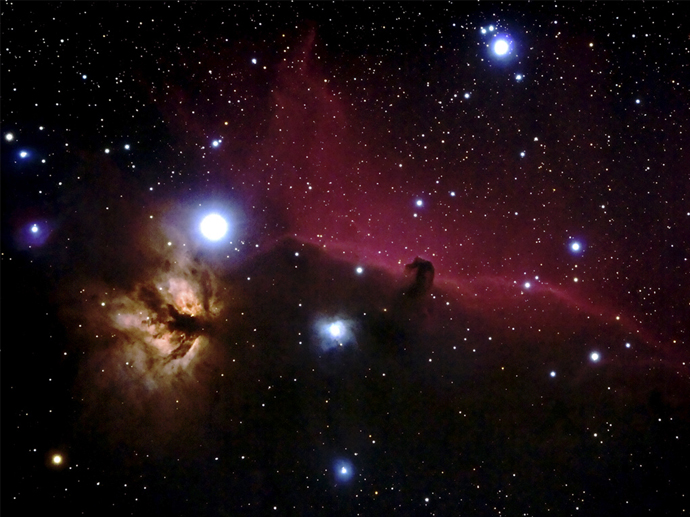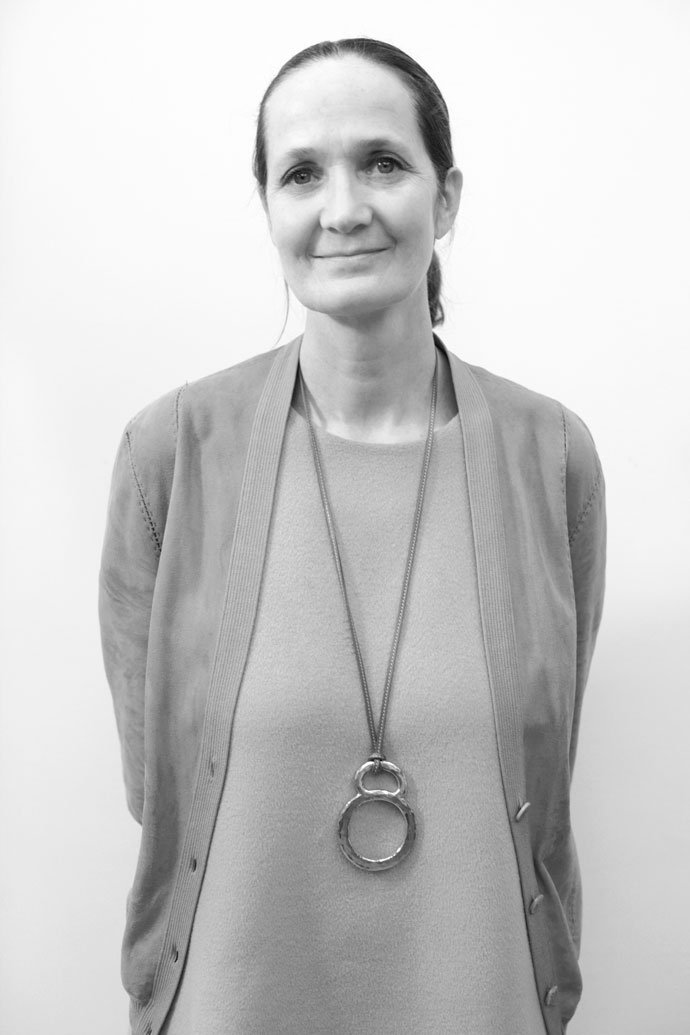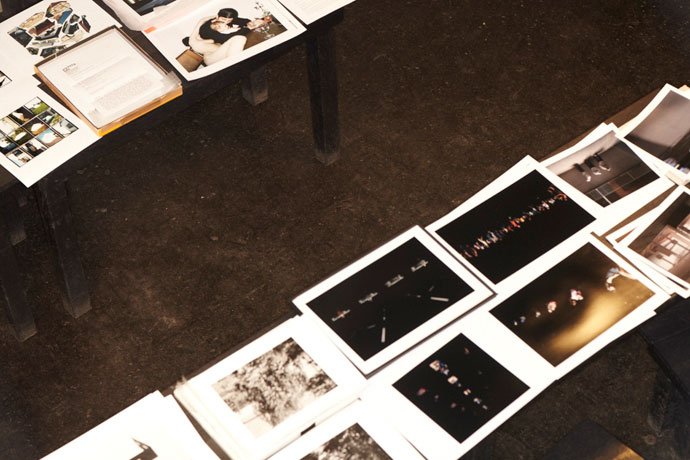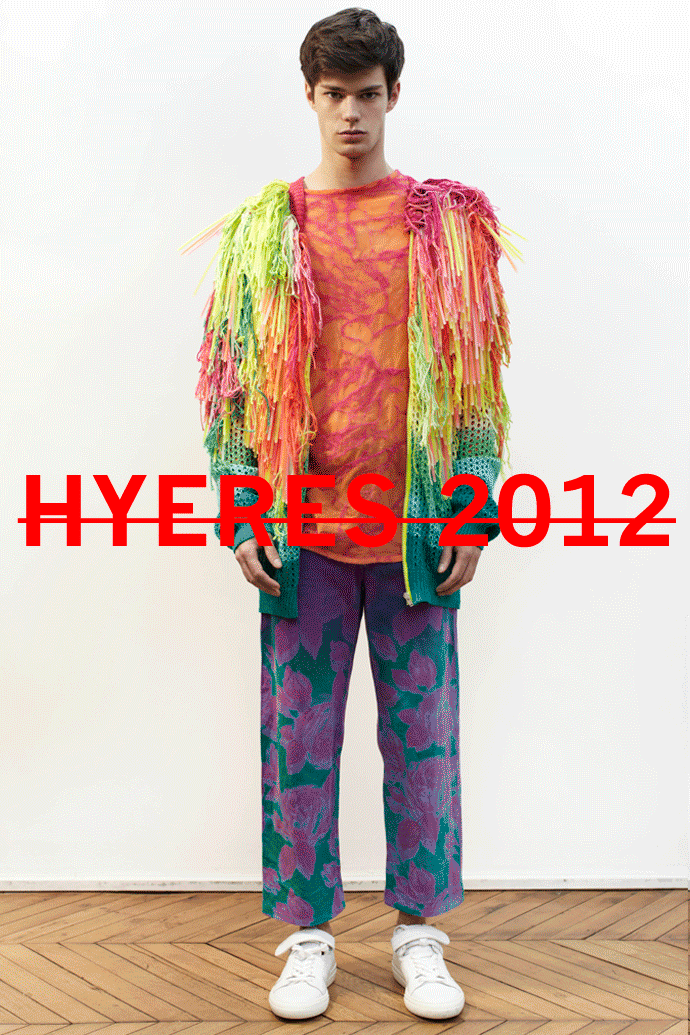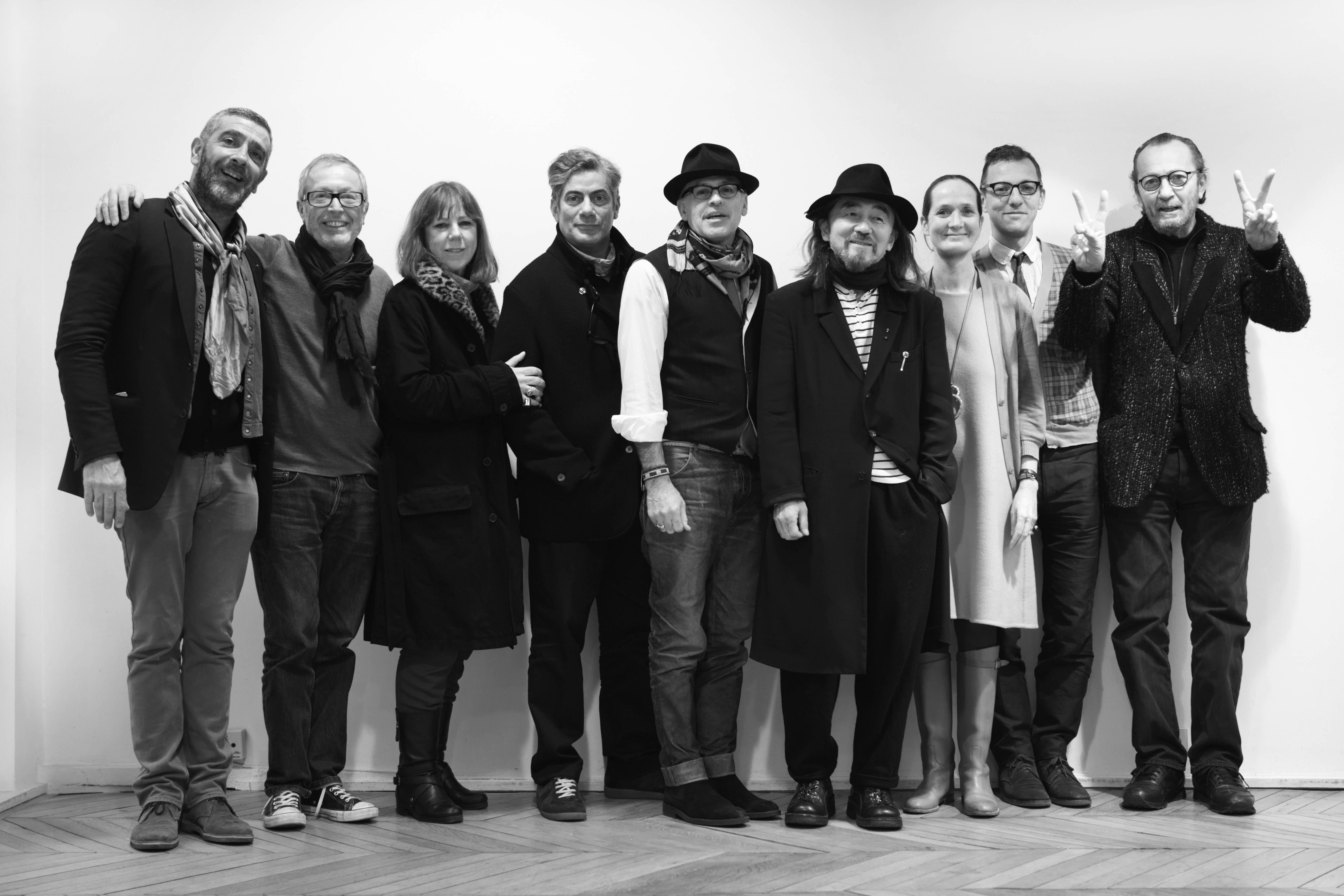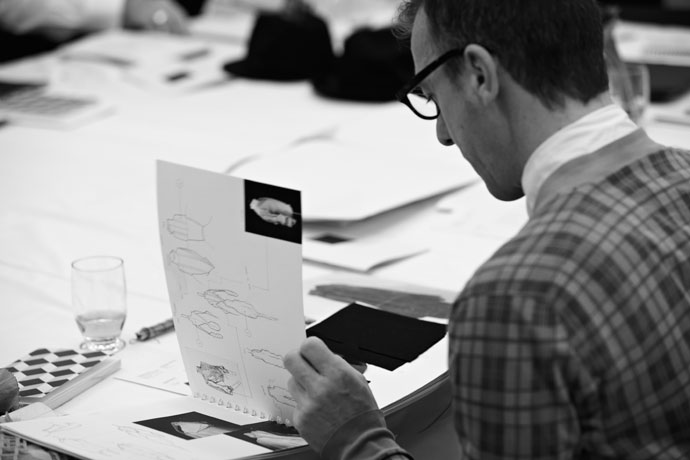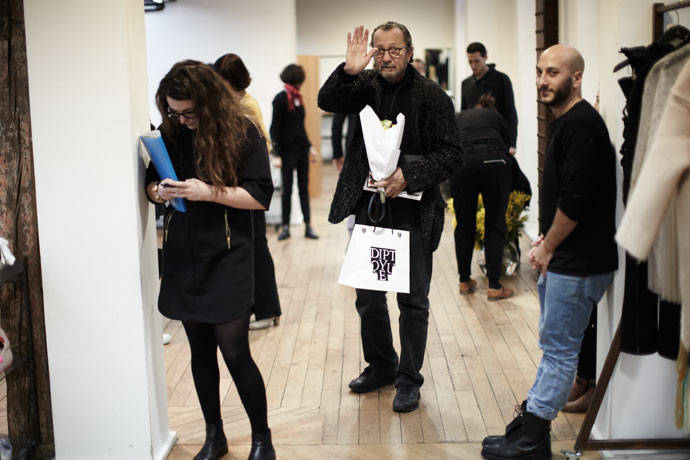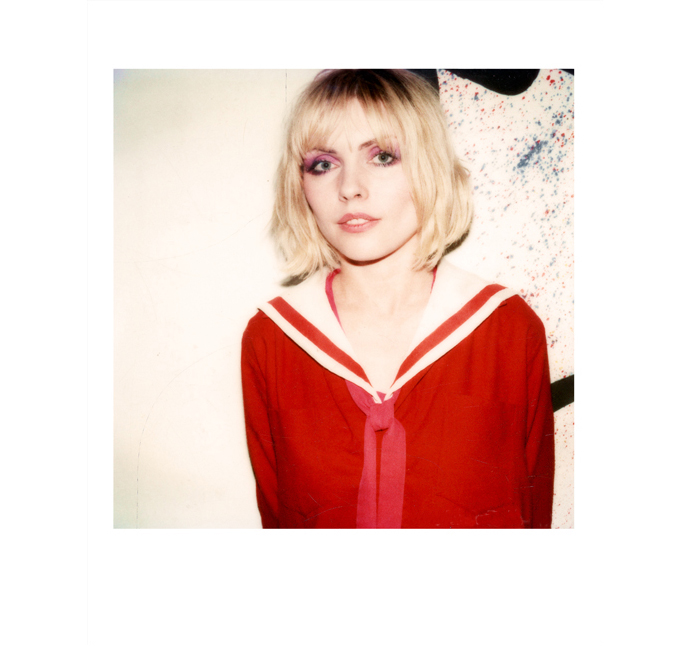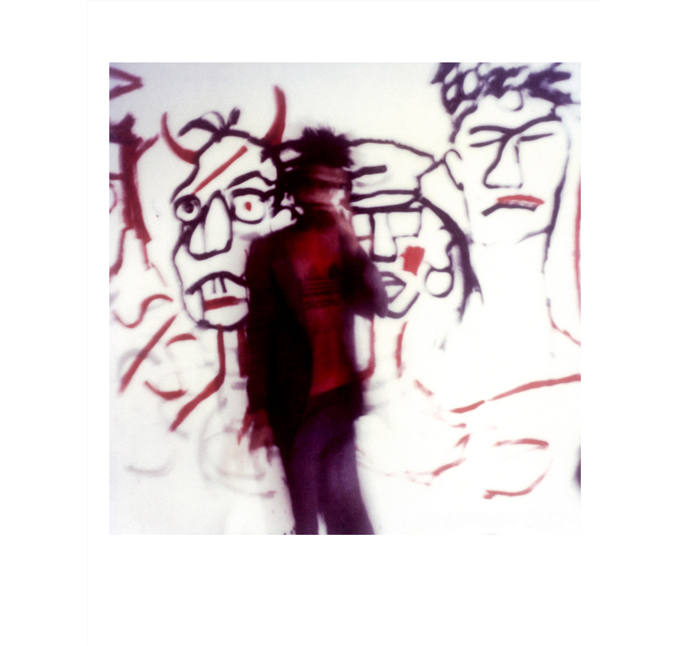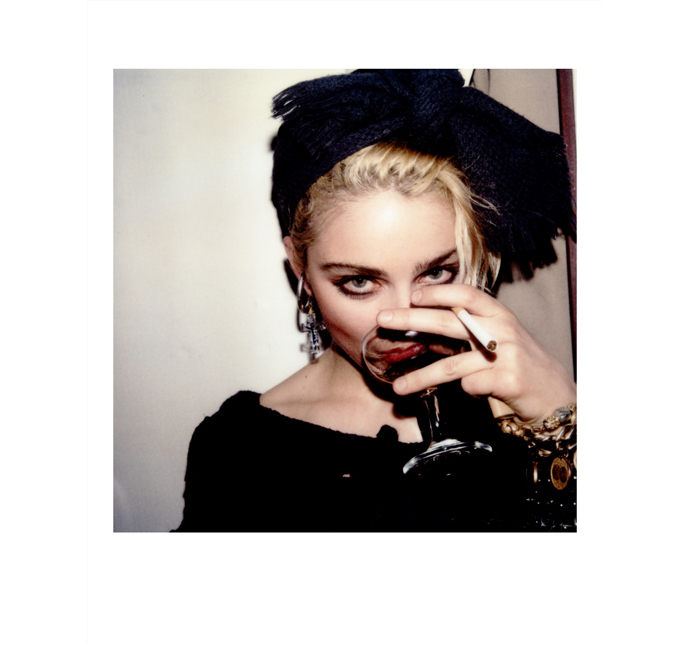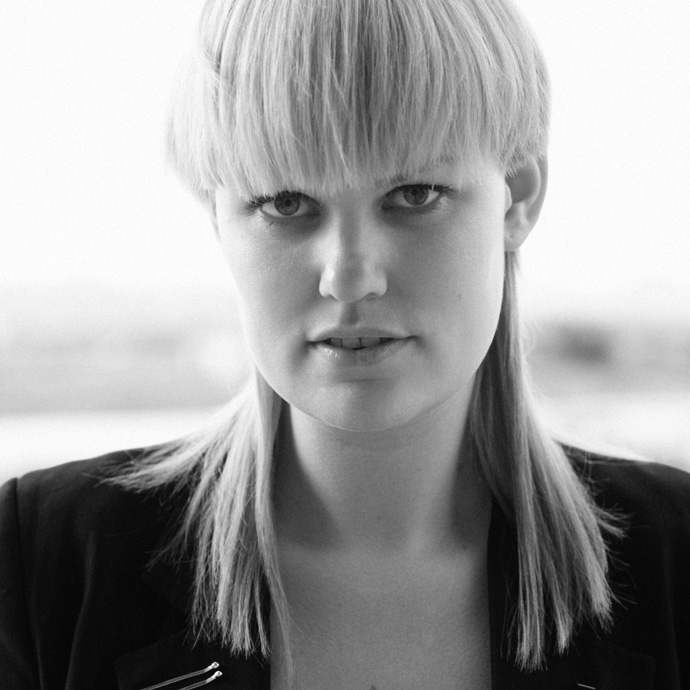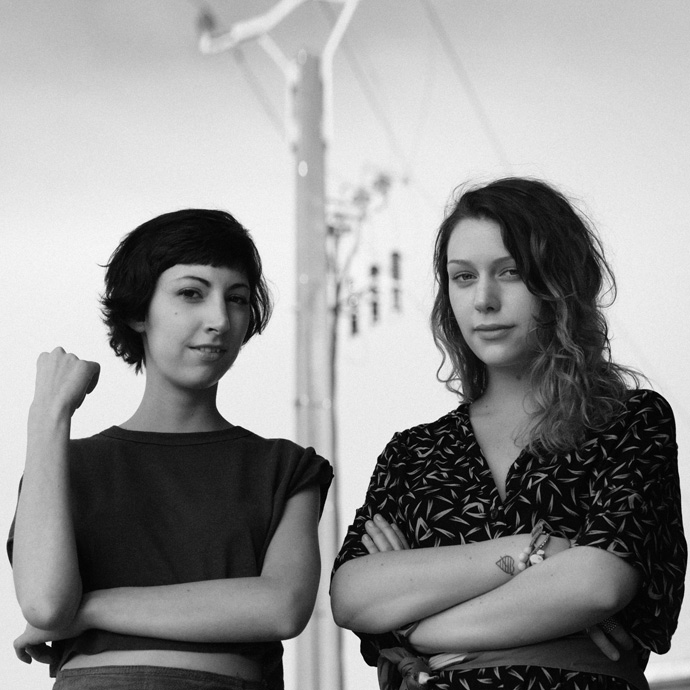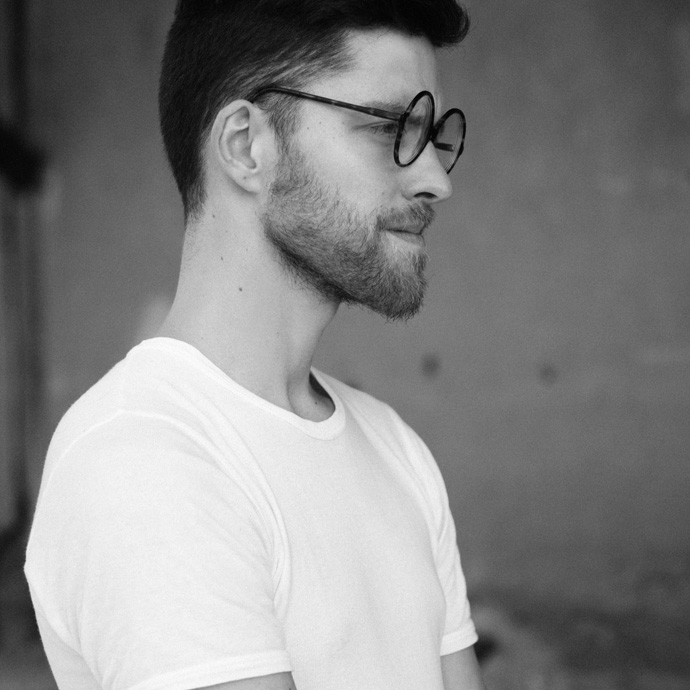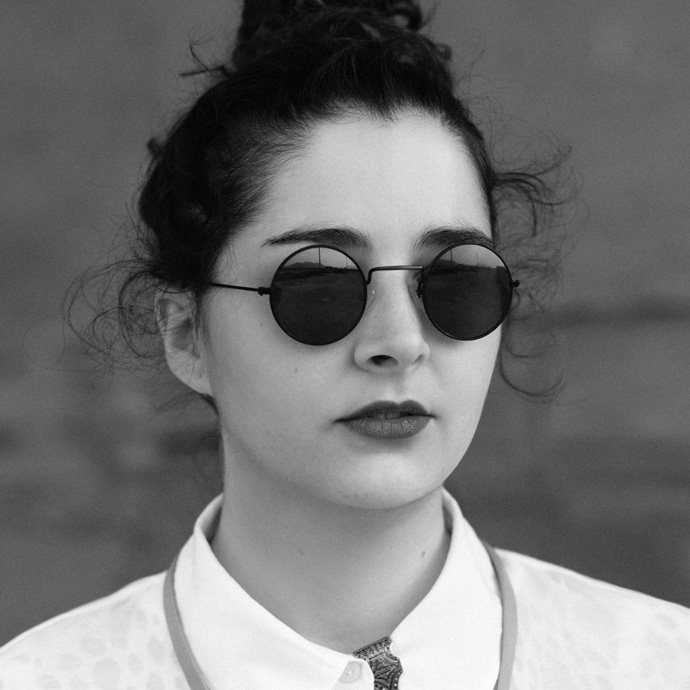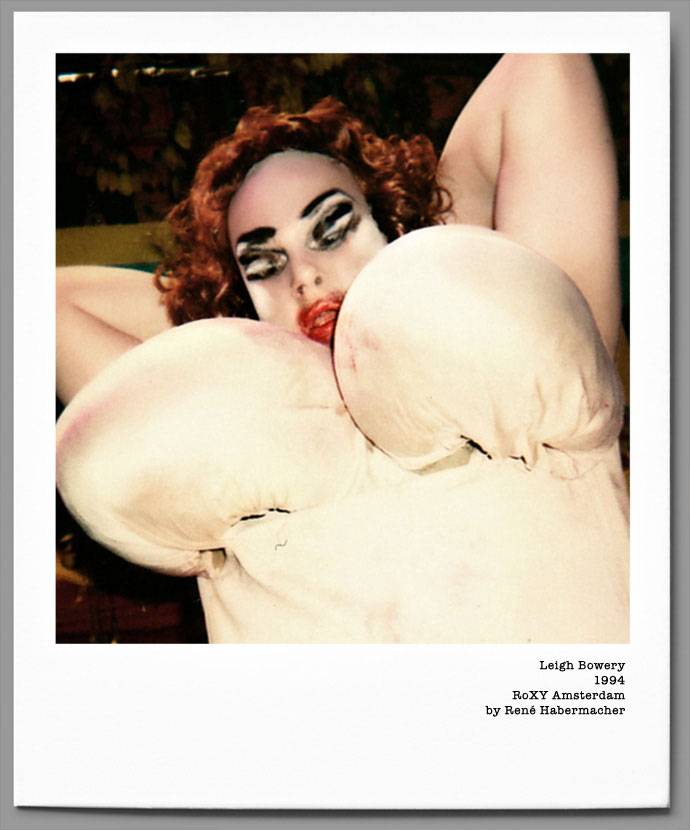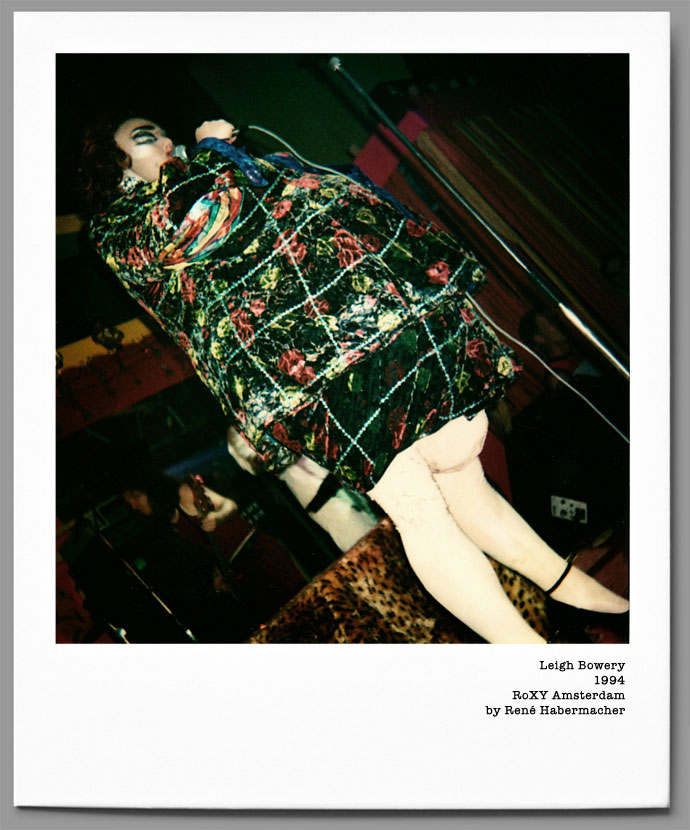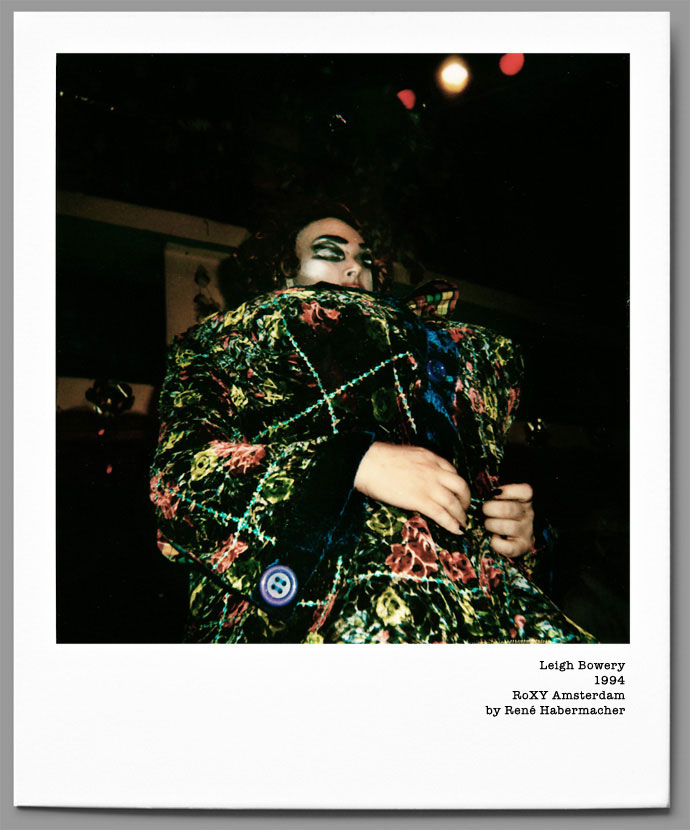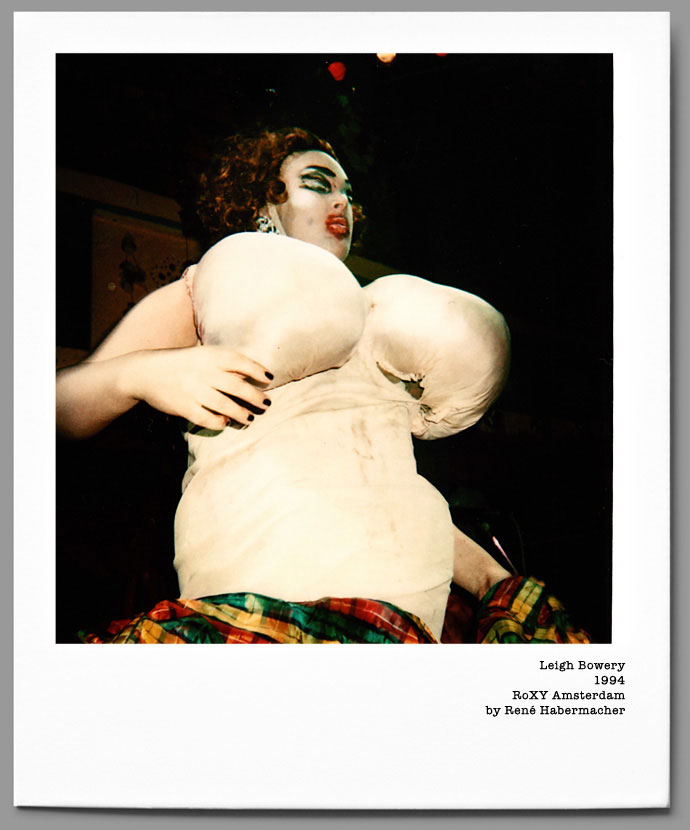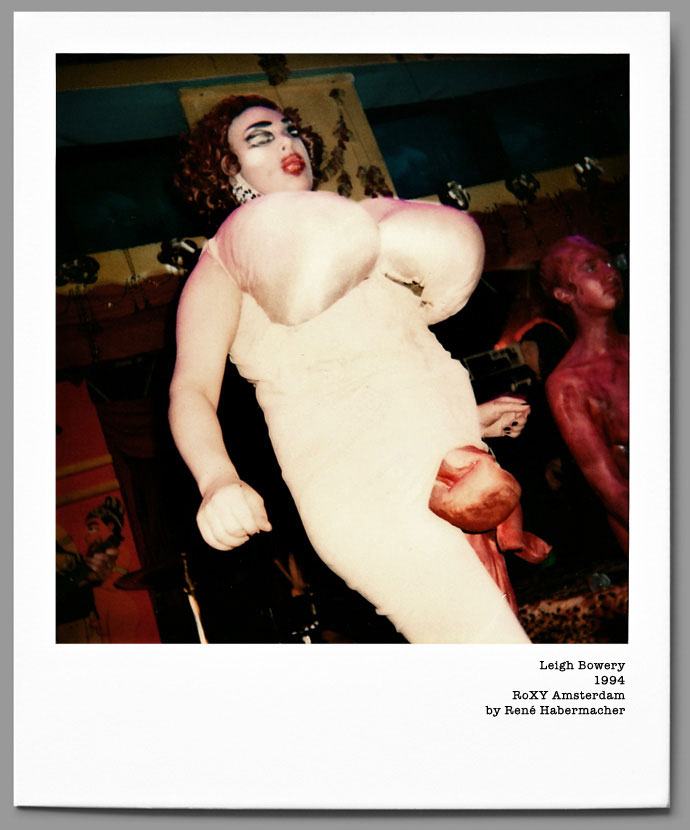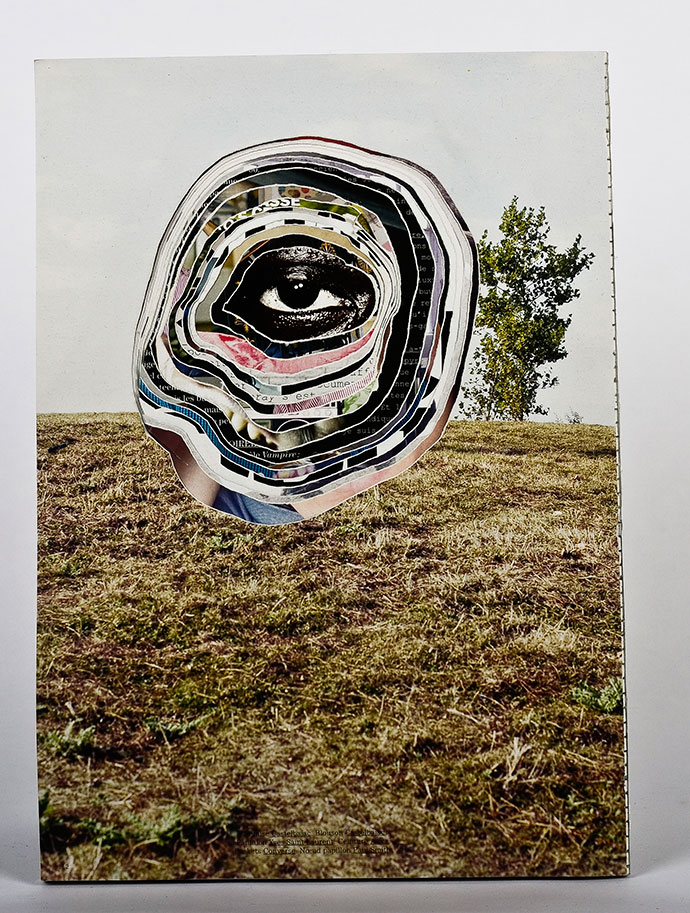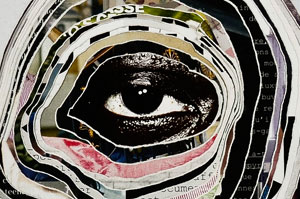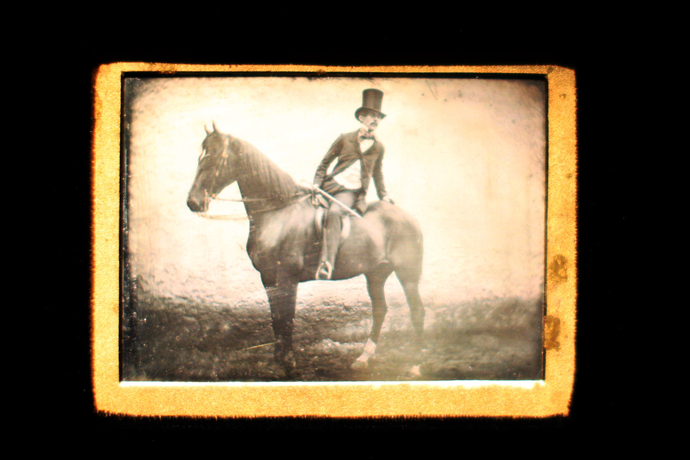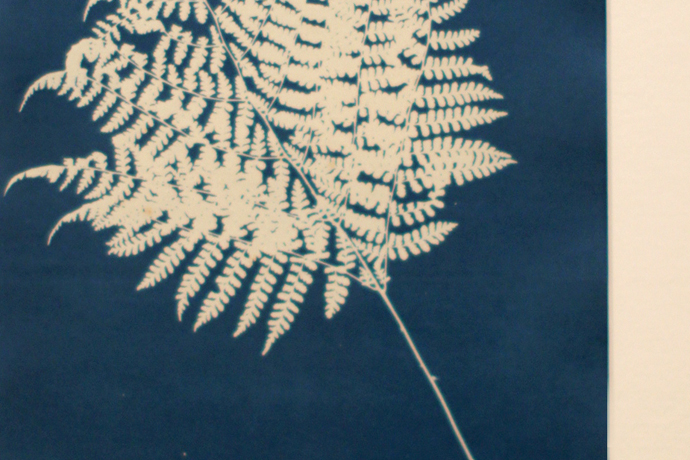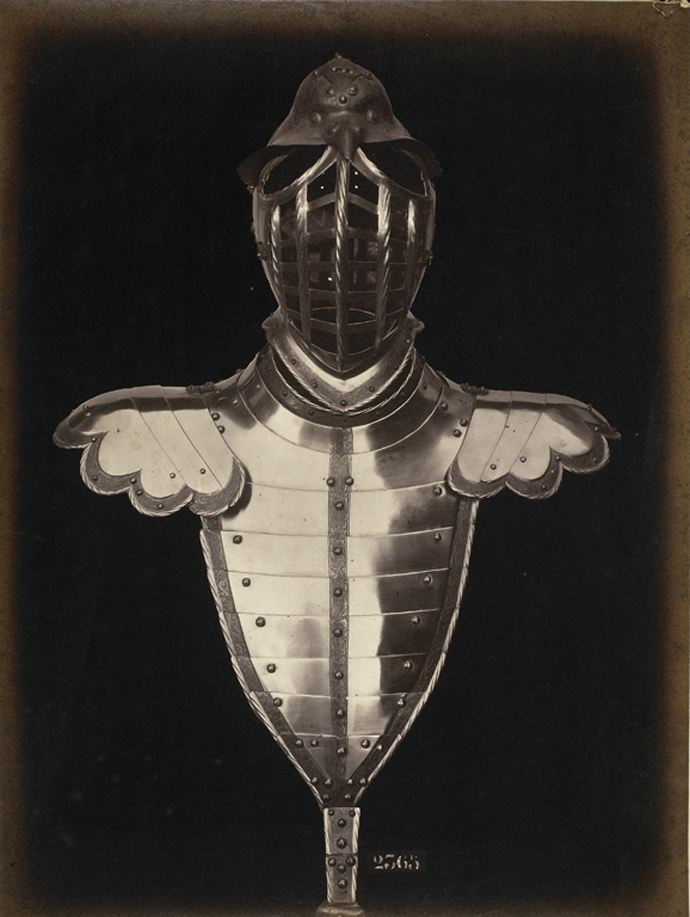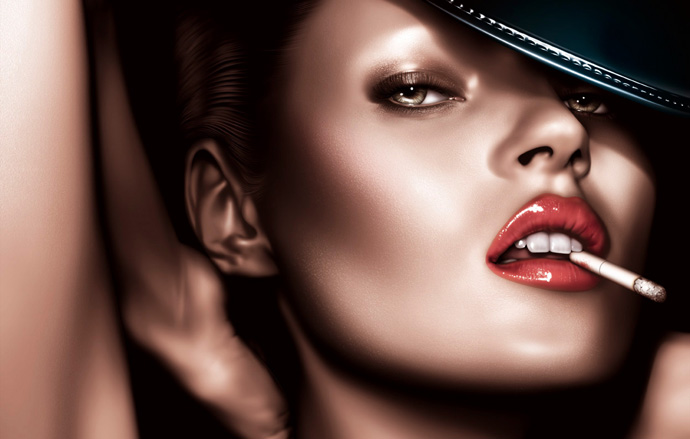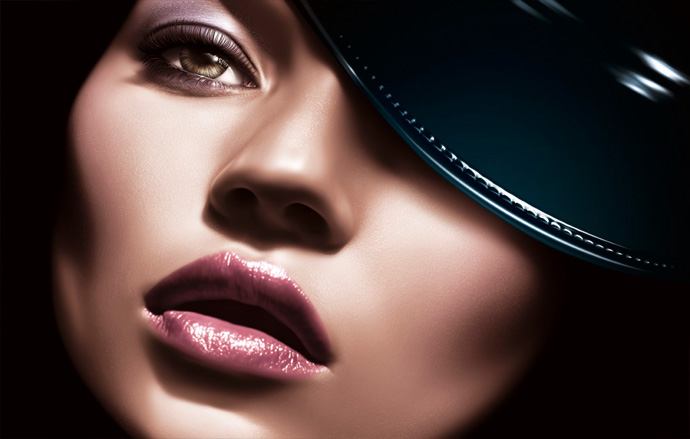-

cécile bortoletti: homodiegetic serendipity
-Beyond its famous fashion & photography festival, Hyères’ Villa Noailles hosts throughout the year a number of photography, fashion, design, architecture and film-related events.
For the annual photography commission, fashion photographer Cécile Bortoletti captured the Mediterranean flora of Hyères over the course of one year, her visions now revealed to us in a new exhibition, “sur-nature”…
Sur-Nature exhibition poster. Picture by René Habermacher.
Antoine Asseraf: The title of the exhibition is “sur-nature” [“over-nature”]…
Cecile Bortoletti: It’s a contraction of “super-nature.”AA: But there’s also a reference to the super-imposition which takes place in some of the pictures…
CB: It was rather complex to get a complete vision of nature around Hyères, very bountiful, luxurious…I live in the countryside, i take pictures of special moments, but to do something like this, like a one year long walk, I had never done. I had done a series of trees at night for a UNESCO/CNRS exhibit about black matter, with a more scientific aspect, but it wasn’t so scattered in time, with all the seasons, like this project.
RH: What was the challenge compared to your editorial work ?
CB: Managing time… I’ve never worked one year on a project. Even if you know the end date, the exhibition date, it’s difficult to manage it. When you work in fashion, you’re on an addict schedule, everything is last minute, very fast.And here i was working alone, with a lot of time, many kilometers to explore, time to think, changing weather and moods, and each time I came I thought it was better than the previous time.
It’s a matter of stimuli. I learned many things but I was happy that it ended, it was very intense.
Sur-Nature exhibition view. Photo by René Habermacher.
AA: You’ve come to Hyères for a long time… did some things still surprise you ?
CB: Now I know it much better, I can find my way, and I’ve discovered the salt marshes and its flora, with impressive survival strategies. I didn’t know about that at all, it was a bit like desert flowers…They’re emotional because they look fragile but in fact they’re tough.As a whole the exhibit shows the fragility of nature, because many times one week later flowers I had shot would no longer be there.
Cécile Bortoletti and the salt marsh flowers. Photo by René Habermacher.
00 -

charlotte rampling
- -

Astronomy compels the soul to look upward and leads us from this world to another – Plato
-Planet Earth is at the center of an observable universe with a 13.7 billion light year radius. Just so you get an idea of what that means, the Moon is only 0.0000000406 light years away (about 357,000km, if that makes it any easier). Paul Klauninger is an astrophotographer who captures some of the beauties of our galaxy, and has been doing so for over 20 years.
Astrophotography remains one of the most complicated forms of photography, but with today’s technology we get images not even Galileo or Newton would have even dreamt of. The Stimuleye catches up with Paul to get a better understanding on this ancient fascination for the Cosmos.
M45 - Pleiades Star Cluster. Photography by Paul Klauninger.
Miguel Batel: You must be happy winter is over. Last time we went out to the field must have been one of the coldest experiences I’ve ever had.
Paul Klauninger: I have mixed feelings about the winter really. While it can be very challenging to operate your equipment (and your fingers, for that matter) when it is –20o C, there are also a number of benefits. In the winter, the nights are much longer than the summer, so you can do much longer observing and imaging sessions. Also, the air tends to be cleaner, containing less dust and water vapour. That makes it better for imaging. And in the winter, you see a different part of the sky than in the summer, so you can see a completely different collection of celestial wonders. Finally, there are no mosquitoes or black flies in the winter, and that’s always a good thing.
MB: Being mostly subjects you can’t appreciate with your naked eye, or directly interact with, I’m curious to know what kind of emotional attachments you develop with your photographs?
PK: I guess my images are like a photo album of travel pictures, in that they remind me of places that I have visited. While it is true that most of the imaging subjects cannot be seen with the naked eye, my telescopes do in fact, allow me to see these without a camera.
When I look through a telescope at a nebula or galaxy that is thousands or millions of light-years away, I can’t help but wonder about other Earth-like planets in those places, and the potential for other advanced civilizations like our own. And when I see the images I’ve taken of those same places, they remind me of just how much more is out there that our limited vision cannot detect directly.
MB: Which have been some of your most significant or revealing photographs?
PK: One of my most favorite “revealing” images is one I took of the Pleiades star cluster. This is an object that you actually can see with the naked eye. It appears as a small dipper-like formation of seven very bright stars, just to the right of Orion. Not only does the image show these seven stars as brilliant blue beacons in the night, it shows hundreds of surrounding, lesser stars that are also part of that cluster. And the entire collection is wrapped in an ethereal, misty blue nebula. Photographically, it’s just a strikingly beautiful object.
Another favorite is actually a series of images that I took over a span of a few months of a very odd object in our solar system named Comet Holmes. Back in 2007, this dim, obscure little comet suddenly and explosively erupted. In a matter of 24 hours, its brightness increased by a million-fold and it easily became a naked-eye object. Before that, you would have needed a large telescope and sensitive camera to even capture it as dim speck of light. In the weeks after its eruption, it continued to expand and grow until it appeared larger than the full Moon, although nowhere near as bright. However, you could easily see this object as large round fuzzy patch in the sky. It wandered around the sky like that for months, until it gradually faded. I captured a series of images over that time period that nicely shows its growth and evolution. To this day, no one knows what caused this comet to erupt as it did.
Horsehead and Flame Nebulae. Photography by Paul Klauninger.
-

The perfect muse: François Sagat
-In Carlo Collodi’s 1883 children’s novel “The Adventures of Pinocchio” it is the wooden puppet that possesses sentience prior to its transformation; it is the puppet and not its creator, the woodcarver who triggers the miracle of the doll coming alive.
With François one never knows who pulls the strings. It is him who invokes the sentiment for a story to become alive. Yet he hands himself over unconditionally to his collaborators, like an “instrument to be played”, as he likes to call it.
Film director Christopher Honoré once expressed that François Sagat “redefines the notion of masculinity”. François, the humble boy from Cognac has moulded himself to unattainable iconic status. Gilded with his blue inked crane, he is to conquer his righteous spot in the pantheon of pop culture…
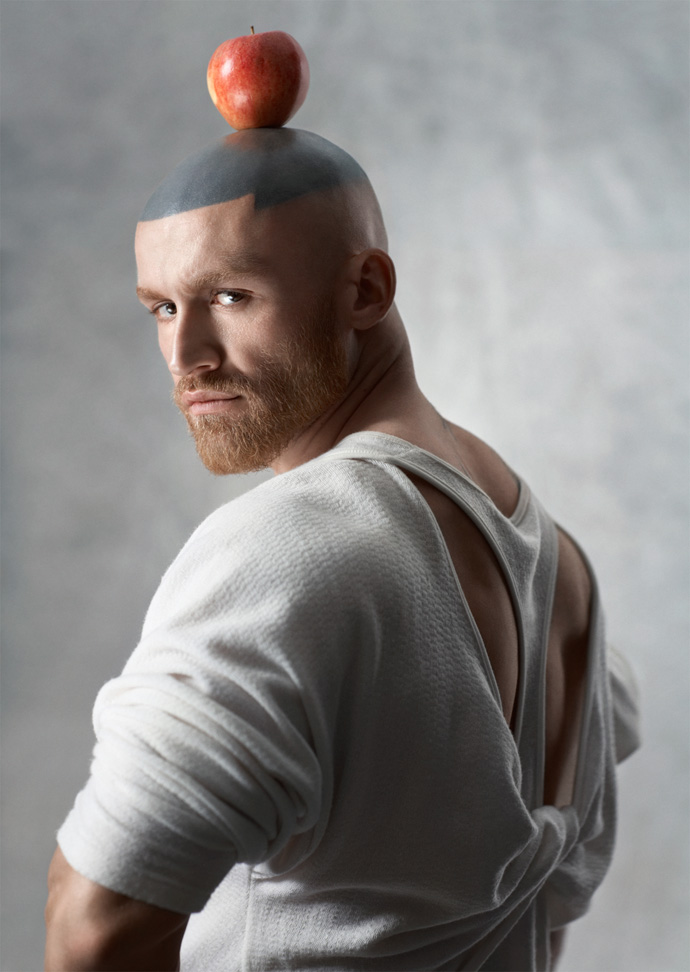 "François Sagat with Apple" Exhibition SPECTRE, Hyères 2010. Photography by René Habermacher
"François Sagat with Apple" Exhibition SPECTRE, Hyères 2010. Photography by René HabermacherRené Habermacher : you recently played alongside Chiara Mastroianni in HOMME AU BAIN by Christophe Honoré, and as well the lead in Bruce LaBruce L.A. ZOMBIE – how were your experiences?
François Sagat: L.A ZOMBIE was an experience which had very little to do with HOMME AU BAIN… The shoot for LA ZOMBIE was like a real porno shoot, scene by scene, it was mostly fucking, except that of course the porno version was censored for festivals…Beyond the sex scenes, LA ZOMBIE was a chaotic shoot, without a script, hasardous… but I’m still to this day satisfied with this participation and collaboration with Bruce LaBruce, from whom I still have much to learn, and who possesses a huge cinema and litterary culture… Despite what his critics say, I think Bruce has a real style.
During the shoot I really tested my capacity to resist “obstacles”, it was at times very difficult, I didn’t know where I was going, no direction, it was like being thrown in the lion’s den.
There was no script, the storytelling was weak and the whole plan was turned on its head by last minute changes and many cancelations, but that can be said about a lot of “cinema” projects.L'HOMME AU BAIN by Christophe Honoré, starring Chiara Mastroianni and François Sagat.
Regarding HOMME AU BAIN, the shooting was a lot more structured, but energetic nevertheless. It’s on this project that I realized that my abilities as an actor were limited, weak even, and felt like I was a big challenge for Christophe Honoré because of my “heavy” image, of the luggage I was carrying.
There were moments when I thought I terrified him, being everything except malleable. The project was constantly evolving due to the fact that we had planned it as a short, and that a lot of questions arose towards the end of shooting. It was finally released as a full feature film, and I have the feeling it wasn’t the right place for the film.It was an intimate project which to me, with hindsight, would have had a strong impact as a short. But I am neither director nor the creator of my own character. Rather than control the situation, I felt the blowback. But surely the imperfection of the final result makes it a real film, that can be remarked and criticized. I chose to shoot it and live the collaboration for the moment rather than think of the finished product.
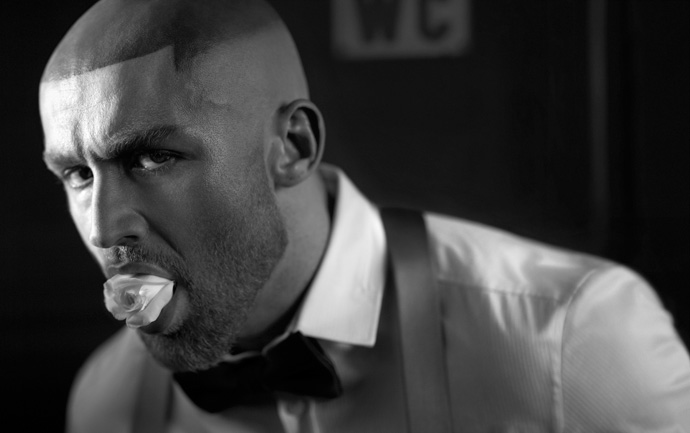 François Sagat for QVEST magazine. Photography by René Habermacher.
François Sagat for QVEST magazine. Photography by René Habermacher.What is the difference to you between acting in a porn movie or a feature film?
The difference ? Of course there are differences.
When you’re a porno actor, you’re in constant control of your carnal envelope and your physical aspect, whether you learn it or you have it from the start.
I didn’t know it as first but I am someone who has that ability. Porn is often an activity for people who are shy orally.
As a performer, you never really have to carry the more or less artistic responsabilities of a porn film, because there is no artistic issue to start with. You just have to be a good soldier fitting what the consumer desires to watch and what the production has decided, and that’s it.
I think also that I am someone who’s very sexual and exhibitiionist, but that’s not really giving you a scoop. Porn is like military service, it’s “my way or the highway”, and in my case, I’ve been and continue to be a good soldier.
The main difference is that you need a capacity to adapt and to lose who you really are, physically as well as morally. I created for myself a character in porn as in life, it’s difficult to let it go.
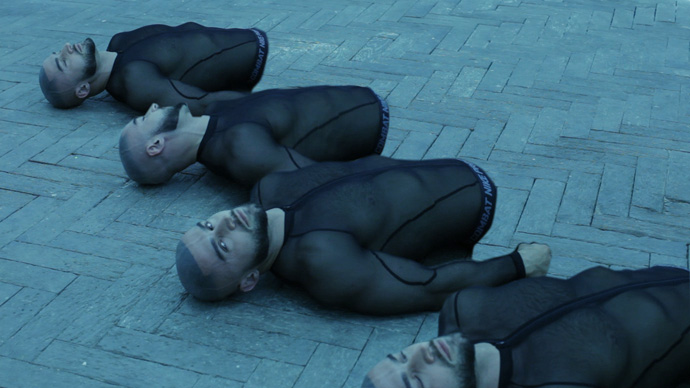 Video still from PILORI installation by Lynsey Peisinger & The Stimuleye. Villa Noailles, Hyères 2012.
Video still from PILORI installation by Lynsey Peisinger & The Stimuleye. Villa Noailles, Hyères 2012. -

télé hyères
-The Stimuleye presents Télé-Hyères…
Télé-Hyères
A The Stimuleye Production
Directed by Antoine Asseraf
Filmed by Thibault Della Gaspera & Jason Last
Postproduction by Clément Roncier
Interviews by Filep Motwary
Music by Ça Va Chéri -

hyères just a taste… pascale mussard
-“Ready to fight like a lionness.”
It’s hard to imagine those words coming from the mouth of Pascale Mussard.
But as art director in a very special company, the “petit h” division of Hermès, she knows how to wait for the right moment before springing into action, while in the meantime keeping an eye for that special quality — talent.Which makes her the perfect Hyères 2012 jury member.
Pascale Mussard, photography Rene Habermacher © Hyeres 2012
How should luxury be interpreted within a young creator’s work?
At Hermes, an object, a creation, must “speak”. It is nourished by the soul and hand of craftsman. It is designed, created, pampered, shaped, dreamed, ennobled, sublimated. It is made with respect, love, passion. Young creators work must inscribe beauty in use, and use in beauty. Nothing superfluous, only honesty every step of the way: from design to production. As heirs of a noble tradition of craftsmanship, our initiatives must be loyal and the innovative expression of this tradition. It must show our optimism and wonderful ingenuity, that last long and leave all horizons open.
What would you say is key to sustaining a fashion brand in a world like ours which is ever changing?
Innovation?
“L’obligation ardente de toute culture” Hélène Ahrweiller [the impassioned obligation of any culture]
Integrity : Never forget our values, from where you come from and invent objects that will last long, be transmitted and bring joy.
Continue to give testament to the relationship between man and the wisdom flowing from acceptance of nature and the unchangeable beauty of usefulness, by reflecting through craftmanship on the meaning of objects and the importance of the ties within mankind.
New petit h film, produced by Partizan.
The art at Petit h is so colourful, fun, happy. Do you feel that ‘happy’ is a keyword for our fashion era now? For our Hyeres contest, would you look for ‘happiness’ to be an aspect in choosing the winner?
My uncle Jean Louis Dumas was saying “où que vous soyez , refusez de vous embêter, dans un milieu de qualité , ce serait du gâchis.» [wherever you may be, refuse to be bored, in a place of quality it would be a waste.]
Petit h : May be not happy as « youthful» Petit h is indeed linked to childhood, particularly in the way to perceive objects and materials, in a new way without preconceptions or prejudice. It is a light, constant, free creation process which makes this petit “h” the legitimate child of Hermès: though sometimes impertinent, a child that does not cease to grow while learning on the materials, the hands that create, and the values of Hermès. For Hyères, it is a “team” judgment under a very innovative President: Mr Y Yamamoto.
Happiness is always a positive value for me, but innovation, fantasy and talent are more important.
Working for a house as historic and of great heritage as Hermès, how do you encounter the challenge to align new ideas with the skills of traditional craftsmanship?
“During a long time I worked on a one-on-one basis with artists and designers. Then, in 2009, the project truly took off and we started working with a cabinet of accumulated materials and craftsmen who worked closely with the artists (at the time Gilles Joneman, Christian Astuguevielle and Godefroy de Vireu) in the recreation process. The pieces created were then submitted to the family and the artistic direction, and the project was approved for a first sale which went very well, allowing us to keep growing.”
“An artist, designer, “geotrouvetout” [inventor] is invited by me to come to the atelier and to dive into the cabinet of materials – the materials are the source of inspiration for all creations, They must work with what is available. These materials will spark the creative process and discussion between the craftsmen and designers to find a solution that is concrete, realizable and esthetic according to Hermes values and procedures. The creation at Petit h comes primarily from a dialogue between the hands of the craftsmen, the materials and the ideas of the designer.”
Craftsmen and designers do not necessarily have the same priorities. What is the collaboration like?
Si vous écoutez vous finissez par entendre. Et un bon entendeur est plus facilement entendu…
[if you listen you will hear. and a good hearer is more easily heard…]
They have to be able to work together well, be able to respond to their partner. I frequently act as a middle person or a kind of midwife. I encourage the team members and say: “We have never done anything like this before, but why don’t we try it out?” If the designer knows exactly what he wants, then the craftsman has to use all his memory, skill and bring out all the techniques that he knows. Currently, we are working on a life-sized bear which is intended for the exhibition in Berlin (23 April – 12 May). The leather is folded using the origami technique – which is something that is for us completely without precedent. The designer Charles Kaisin calls up frequently to find out how we’re getting on. Last week, one of our craftsmen said he thought he would never be able to realize the idea. But eventually everyone in the studio found a method which works.
An inner connection must be forged between the designer and the craftsman. If this happens then I am prepared to defend their work within the company like a lioness.
What is the last thing that you experienced, saw or heard that stimulated you?
Recently I had the chance , the luck to visit really inspiring places, Naoshima (Japan), Inhotim (Brazil) two sites that offer a unique combination of major contemporary art collection and nature.
Two wonderful projects: A DREAM. Brazil and Japan, two countries very energetic and inspiring for me. A great encounter in Brazil: the architect Marcio Kogan ( Sao Paulo)
This summer a beautiful and peaceful trip: Ladakh.
-

hyères juste a taste…Alan Bilzerian
-Among the crew of fashion wisemen assembled by Yohji Yamamoto in the Hyères 2012 jury is Alan Bilzerian, owner of the eponym Boston boutique, who was kind enough to answer the questions of the Hyères partner blogs…
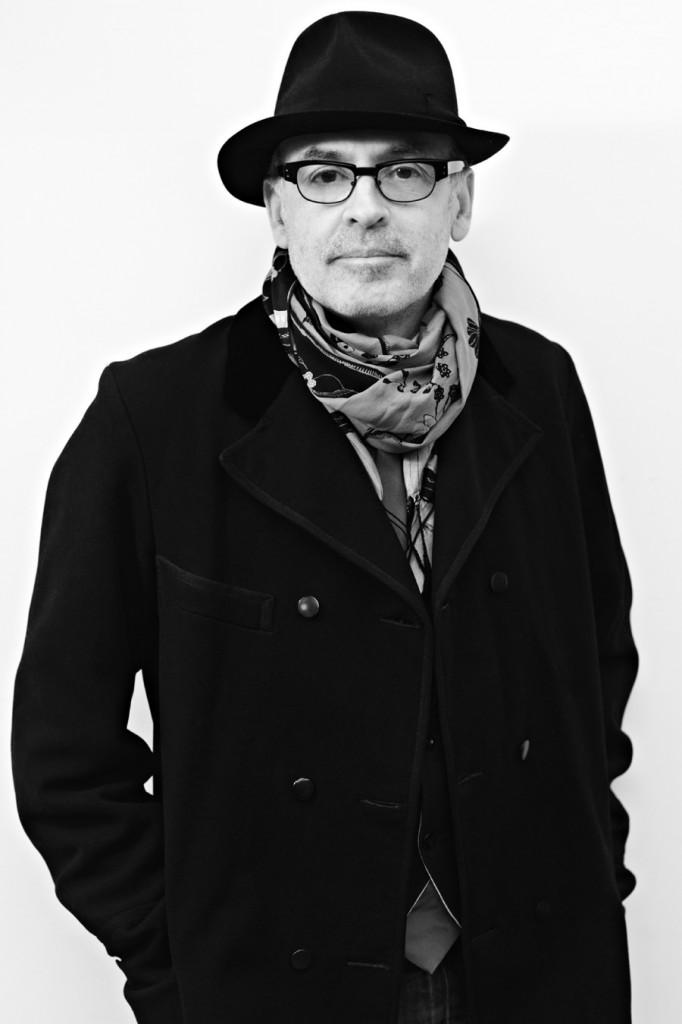 Alan Bilzerian by René Habermacher.
Alan Bilzerian by René Habermacher.How important is craftsmanship in a collection for you?
Actually, its one of the first points that bring me closer to the designer. It puts a skip in my step when young designers succeed in translating quality.
When looking at the Hyères ranges, what is more important to you, the designer’s ability to conceptualize a range and see it through to its most artistic and expressive, or do you focus strongly on the commercial viability of the ranges?
I feel very uncomfortable about looking at large ranges of any designer. I believe you can exhibit your emotion of design very clearly in short exhibitions. But I look at both the commercial side as well as artistic expression.
How supportive are your consumers to young designers? What is the most challenging aspect of trying to sell a young designer, and what can the designers do about it?
The consumer will listen to us about any new designer and will certainly give it a chance with a try on or touch. The competition is so strong because of the immense amount of product, we feel you need a little push from the editorial side and a strong support system with shops of high caliber.
The corporate fashion conglomerates are assembling more and more brands under their umbrella and control through advertising the exposure of fashion in the editorials.This makes it harder for young, independent designers to create visibility and establish their vision and brands. How do you see this affecting your work as a buyer?
Its always very challenging to move into new names because in my shops I like consistency to prove that I made the right decision for the customer. The fashion umbrella of the conglomerates are needed as well because of the visible progress shown to the consumer, it helps momentum.
What is the last thing that you experienced, saw or heard that stimulated you?
Nostalgia…
-

Everything You Need To Know About Hyères 2012 Fashion + Photo Festival
-Everything you need to know about the
Hyères International Fashion + Photography Festival 2012.
April 27-30 2012, Villa Noailles, Hyères, FRANCE.Fashion + photo juries, fashion shows, exhibitions by Yohji Yamamoto, Inez Van Lamsweerde & Vinoodh Matadin, Jason Evans, Chronique Curiosités, Maison Rondini, Matthew Cunnington & John Sanderson, Fabrics Interseason, Lynsey Peisinger & The Stimuleye, Lea Peckre, Celine Meteil, Internationales Fashion + Textile Conferences, The Shoes/TEED/Citizens…
a film by The Stimuleye,
with Lynsey Peisinger and François Sagat. -

HYERES 2012, the photo selection
-How do you reduce 782 applications into a curated selection of 10 photographers ?
Where is photography going today ?
Can the promise of future creation outweigh present output ?I wouldn’t want to have to answer those questions, but the Hyères photo jury had to.
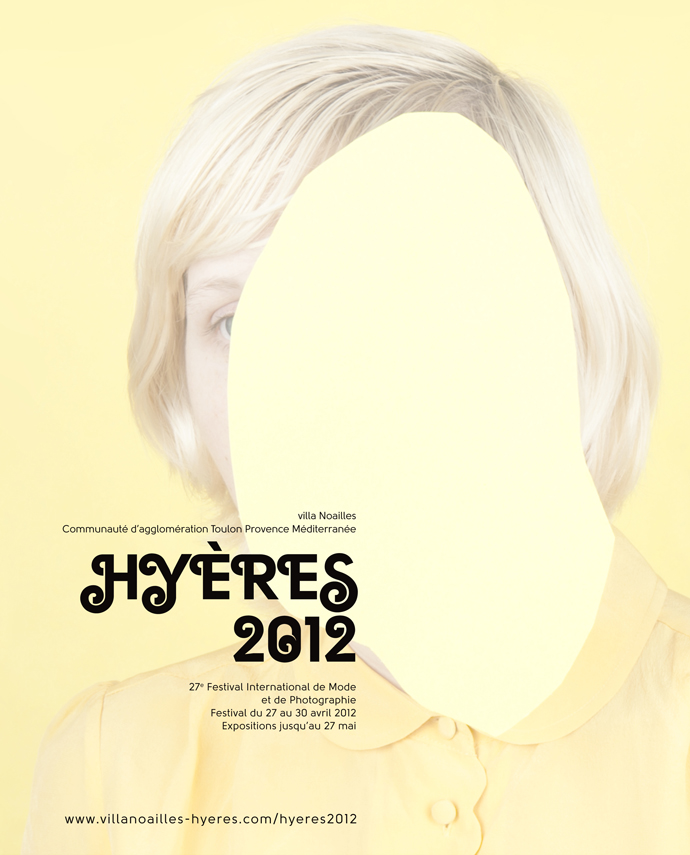 Hyères 2012 visual, featuring the work of 2011 contestant Ina Jang.
Hyères 2012 visual, featuring the work of 2011 contestant Ina Jang.Photographers, curators and critics met under the guidance of photography director Michel Mallard and his team on January 31st to chose 10 photographers whose work would be featured at the 27th edition of the Hyères Fashion + Photo Festival, a festival which revealed in the past talents such as Sølve Sundsbø, Cédric Buchet, Robbie Rodriguez, Caroll Taveras, Linus Bill and 2011’s winner Anouk Kruithoff.
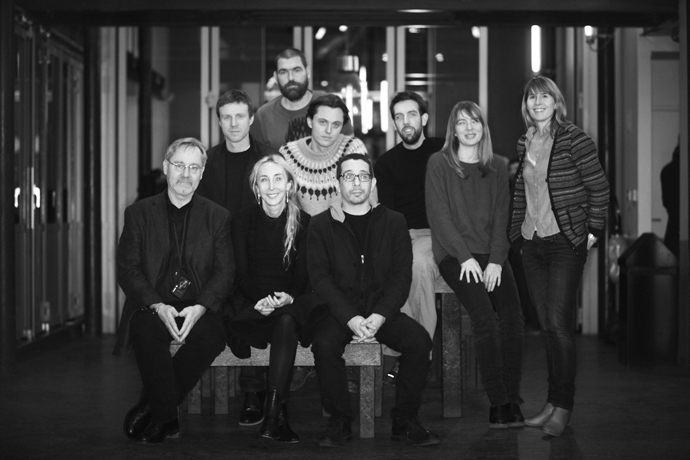 The 2012 photo jury, first row from left to right: Michael Wolf, Carla Sozzani, Michel Mallard,
Second row: James Reid, Aaron Schuman, Hans Gremmen, Raphaelle Stopin, Anne-Céline Jaeger,
Back: Jason Evans.
The 2012 photo jury, first row from left to right: Michael Wolf, Carla Sozzani, Michel Mallard,
Second row: James Reid, Aaron Schuman, Hans Gremmen, Raphaelle Stopin, Anne-Céline Jaeger,
Back: Jason Evans.So first they looked.
Then they talked.
And finally they argued.
And then they questioned their choice and started the process all over.
Until at last, they had 10 photographers, from 3 continents.Of course, come April 27th when the festival starts, these photographers will be competing for the jury’s attention, engaging in a series of one on one interviews and portfolio discussions in the Villa Noailles’ covered galleries, facing a cubist garden.
And yet the ability to spend quality time with high level professionals, to be exhibited next to the works of other 2012 exhibitions such as Inez van Laamswerde + Vinoodh Matadin and Jason Evans is a reward in itself…
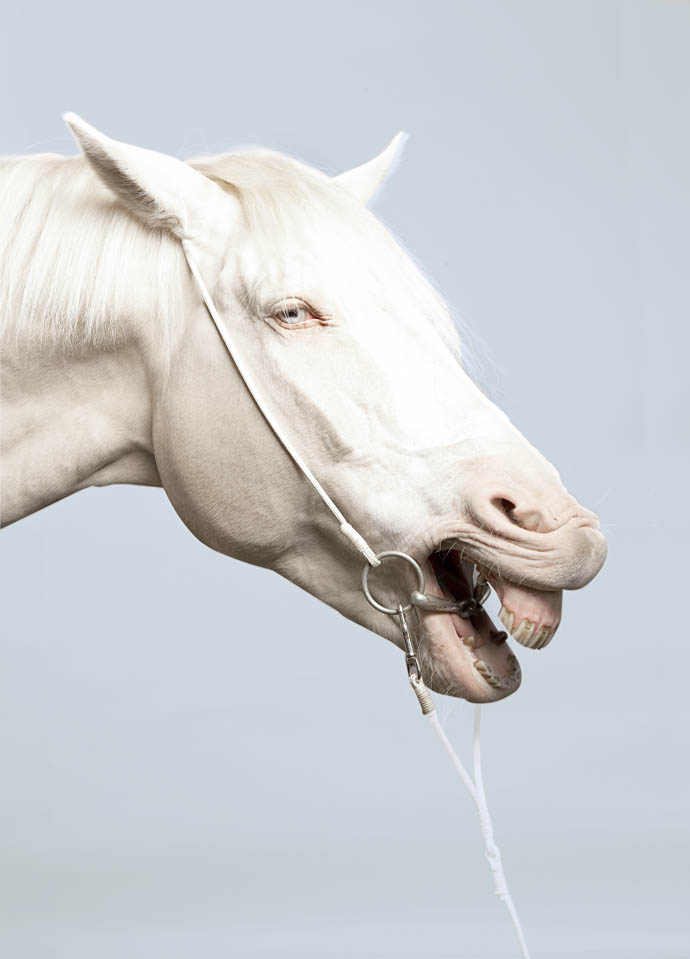 Photo by 2012 contestant Olga Cafiero.
Photo by 2012 contestant Olga Cafiero.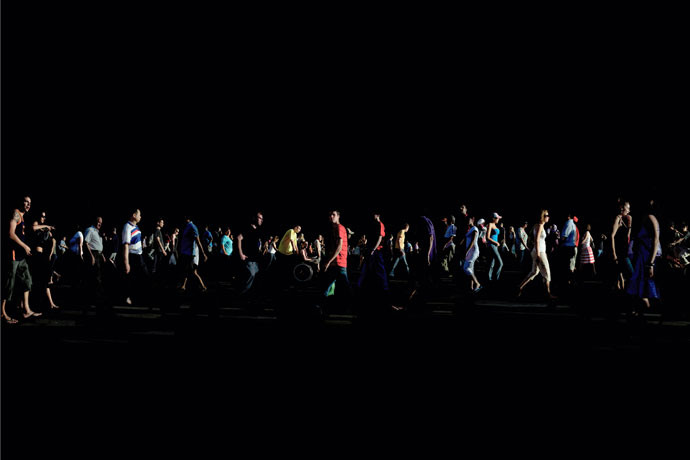 Photo by 2012 contestant Manuel Vazquez.
Photo by 2012 contestant Manuel Vazquez. Photo by 2012 contestant Brea Souders.
Photo by 2012 contestant Brea Souders. -

HYERES, IT BEGINS
-Can fashion still dazzle us ? To prove that the answer is “yes” for its 2012 edition, the legendary Hyères Fashion & Photography Festival has invited Yohji Yamamoto to preside its fashion jury…
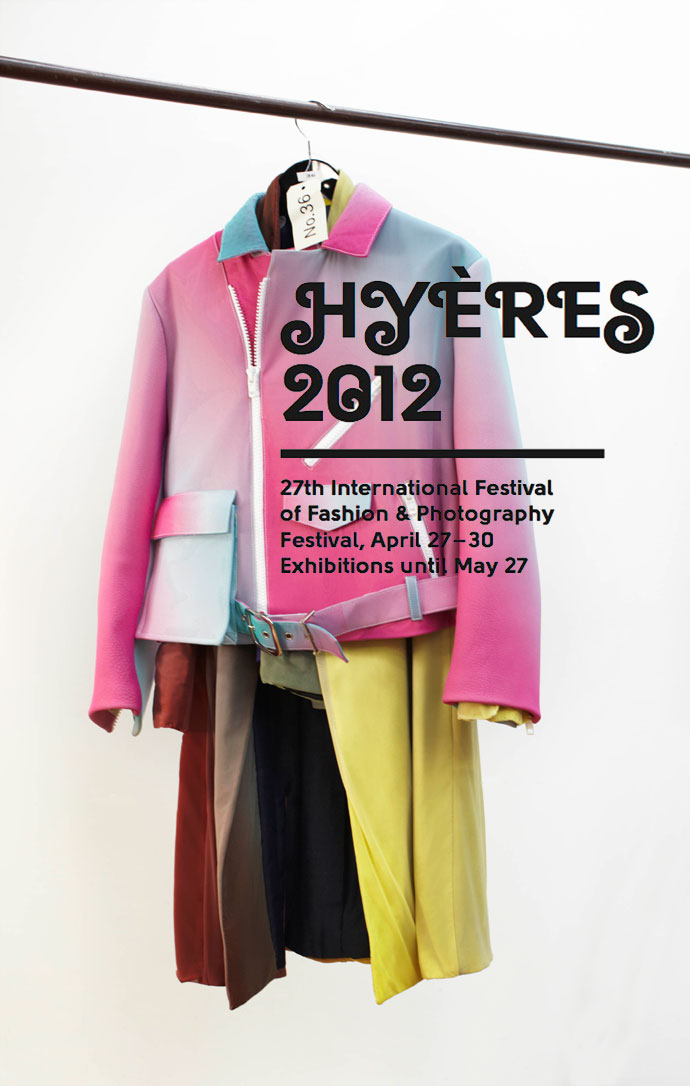
Leather Jacket by Daniel Hurlin, one of the contestants. Photo by René Habermacher.
There is problem in fashion today.
It’s a time of transition, adjusting to the internet, new markets, and the weight of conglomerates.
It’s a time of new opportunities for many.But it’s also a time where a house like Dior cannot find a replacing designer without causing a game of musical chairs – we are to understand that there are so few established designers out there, that Dior’s next womenswear designer must come from a competing house.
As if there were no young designers up to the job.
As if Galliano himself had had much experience when he started.
The problem is, today, that it’s become increasingly tough for young designers to develop their visual aesthetic independently, starting from scratch.
And if young designers can’t develop their style, be allowed to mature and establish themselves, well, there won’t be any mature designers around when Dior needs one.The submitted silhouettes of the 10 contestants. Photo by René Habermacher.
Luckily, there is Hyères.
Since 1985, the Hyères Fashion and Photography Festival, located on the Côte d’Azur in the South of France, has promoted the work of young designers by putting them in contact with the industry’s top professionals, organizing for them state-of-the-art fashion shows and drawing an audience of buyers and press from all over the world, giving them the chance to make a first impression.
Hyères has given us Viktor & Rolf, Felipe Oliveira Baptista (Lacoste), Gaspard Yurkievitch, and many others who now run the studios of the biggest houses.The Hyères 2012 Selection jury.
This Hyères (forgive the pun), Japanese designer Yohji Yamamoto has invited an all-star group to join him in the fashion jury: photographer Paolo Roversi, curator Jules Wright, Galliera fashion museum director Olivier Saillard, creative director Marc Ascoli, buyer Alan Bazarian, Hermès art director Pascale Mussard, and i-D magazine’s Terry Jones were all present to go through the dossiers of the applicants.
Jury member Olivier Saillard examining a dossier.
After hours of looking at dossiers and submitted looks, and additional hours of deliberation, the selection jury chose 4 men’s and 6 women’s looks from designers coming not only from traditional Western European countries but also from Australia, Canada, Argentina, Brazil, Finland and Estonia.
The designers now have 2 months to complete 6 more looks from their collection(and a special Chloé look) before flying in to Hyères in April and being prepped by fashion director Maïda Gregory for the jury and presentations, fashion shows and showrooms happening over the 3 days of the festival. In addition to a Grand Jury Prize (15 000 Euros by L’Oreal Professionel) and a Première Vision Prize (10 000 euros), they’ll also be competing for a new Chloé prize, with a specially designed look.
Photographer Paolo Roversi saluting us as he leaves the Yohji Yamamoto HQ. Photo by René Habermacher.
Check back with us soon for interviews of the jury members and news about the photo competition as well…
Hyères Fashion & Photography Festival
April 27-30th, 2012
Villa Noailles, Hyères, France -

Hyères We Go Again
-Ladies and gentlemen, place your bets. Every year, the Villa Noailles art center in Hyères, France offers fashion designers and photographers the opportunity to step into the spotlight…
Photo by 2010 photo winner Yann Gross, look by 2011 fashion winner Léa Peckre.
Design duo Viktor & Rolf ? Stills photographer and Ricard award finalist Erwan Frotin ? Mugler men’s designer Romain Kremer ? Fashion photographer Sølve Sundsbø ? ANDAM 2011 prize winner Anthony Vaccarello ? Lacoste designer Felipe Oliveira Baptista ? All these people have one thing in common – their work was all launched into the spotlight through the Hyères fashion and photography festival, which is now going into its 27th edition.
As a contestant, you must register by November 26th and send your application package by December 5, 2011. Your work will then be reviewed by a jury of fashion, art and photography professionals (including in the past Azzedine Alaia, Nan Goldin, Riccardo Tisci, Peter Knap, Karl Lagerfeld, Viviane Sassen, Dries Van Noten, Tim Walker, Christian Lacroix…).
If you make it past the first rounds of selection, you’ll be given production help for your collection, flown to the Hyères, given the chance to meet and talk with the 2012 juries, and have the famous Hyères team produce a gallery show of your pictures or a fashion show of your collection, in or around the unique setting of the avant-garde Villa Noailles, once vacation home to the likes of Dali and Cocteau…
And of course, the best part: my little finger tells me this year there will be even more prizes…
In case that wasn’t enough, here’s everything you need to know about Hyères in 2 minutes 6 seconds.
Villa Noailles
2012 Contest guidelines & registration
Registration deadline: November 26th, 2011
Submission deadline: December 5th, 2011 -

Guy Bérubé and his Petite Mort
-It has been one year now since I moved to Ottawa, Canada. During the past year I’ve come across a few people who are always trying to make the city exciting. Guy Bérubé, a good friend now, is one of them. He owns a gallery – La Petite Mort, a place where taxidermy meets with iconic furniture pieces and fundraising art sales for several charities (including Guy’s own).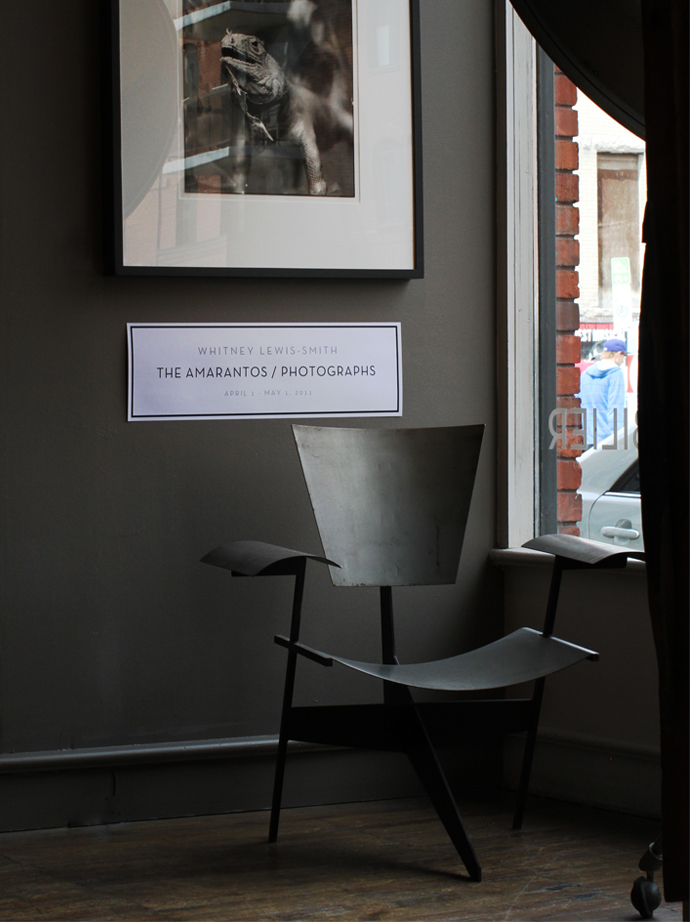 Lizard photo: Whitney Lewis-Smith.Far from presenting “Hockey art” or Canadian landscapes, in Guy’s gallery you will find work ranging from portraits of the city’s crack addicts by photographer Tony Fouhse, to poems on pieces of cardboard by Crazzy Dave of the Ottawa homeless community.With the look and fame of a bad boy, I can only say that Guy is doing a great job for the art community in Canada: making art available and affordable to whoever is interested.
Lizard photo: Whitney Lewis-Smith.Far from presenting “Hockey art” or Canadian landscapes, in Guy’s gallery you will find work ranging from portraits of the city’s crack addicts by photographer Tony Fouhse, to poems on pieces of cardboard by Crazzy Dave of the Ottawa homeless community.With the look and fame of a bad boy, I can only say that Guy is doing a great job for the art community in Canada: making art available and affordable to whoever is interested. Legs with severed head (Guy's head, btw) Peter Shmelzer.What was the last thing that stimulated you?It happened here in Ottawa, it happened to be a lesbian wedding performance by former American prostitute and porn star turned performance artist, Annie Sprinkle, and her partner, hosted by SAWGallery. It was very interesting for me to see. They are already married, but they do an annual wedding with a theme, and this time here in Ottawa it was marriage to nature, and marrying snow. They are eco-sexual; they have sexual feelings about nature (laughs). I hadn’t seen Annie Sprinkle in over 25 years, and I had met her before at a performance in NY where she had a live orgasm on stage.So, it happened next door to my gallery at St. Brigid’s (a deconsecrated Church), and a lot of people came, and they saw the look and the aesthetics of a wedding. Everybody wearing white, everything was beautifully decorated, the light was coming through the stained glass… but then the performance started. They rode a pile of snow, exposing themselves by lifting their wedding dresses, and then inserted icicles up their vaginas, as they recited their wedding vows.That seems a bit unusual for the city…I’m seeing change, slowly but surely, over the 10 years that I have been here. I know that I’ve had some credit for some of the change. I’m seeing a difference in the art that is featured in galleries, even the Municipal galleries are showing things from my artists. It is something positive; Ottawa is a city where there is a possibility of starting from scratch, even though you’ve seen it in other places. Ottawa is a funny little town, very voyeuristic; it’s like the dude at the orgy who complains about the bad drapes and doesn’t jump into the fun.What would be a good example of this change coming from your gallery and artists?
Legs with severed head (Guy's head, btw) Peter Shmelzer.What was the last thing that stimulated you?It happened here in Ottawa, it happened to be a lesbian wedding performance by former American prostitute and porn star turned performance artist, Annie Sprinkle, and her partner, hosted by SAWGallery. It was very interesting for me to see. They are already married, but they do an annual wedding with a theme, and this time here in Ottawa it was marriage to nature, and marrying snow. They are eco-sexual; they have sexual feelings about nature (laughs). I hadn’t seen Annie Sprinkle in over 25 years, and I had met her before at a performance in NY where she had a live orgasm on stage.So, it happened next door to my gallery at St. Brigid’s (a deconsecrated Church), and a lot of people came, and they saw the look and the aesthetics of a wedding. Everybody wearing white, everything was beautifully decorated, the light was coming through the stained glass… but then the performance started. They rode a pile of snow, exposing themselves by lifting their wedding dresses, and then inserted icicles up their vaginas, as they recited their wedding vows.That seems a bit unusual for the city…I’m seeing change, slowly but surely, over the 10 years that I have been here. I know that I’ve had some credit for some of the change. I’m seeing a difference in the art that is featured in galleries, even the Municipal galleries are showing things from my artists. It is something positive; Ottawa is a city where there is a possibility of starting from scratch, even though you’ve seen it in other places. Ottawa is a funny little town, very voyeuristic; it’s like the dude at the orgy who complains about the bad drapes and doesn’t jump into the fun.What would be a good example of this change coming from your gallery and artists?
The USER series by Tony Fouhse is a perfect example of what my gallery does, something of which I’m very proud. It was featured in New York Times, Japan Newsweek… people got it, but it was very difficult at the beginning; lots of people in the neighbourhood, politicians, people were very against the work. Men wrestling: Matthew Dayler / Photo of man laughing: Tony Fouhse.
Men wrestling: Matthew Dayler / Photo of man laughing: Tony Fouhse.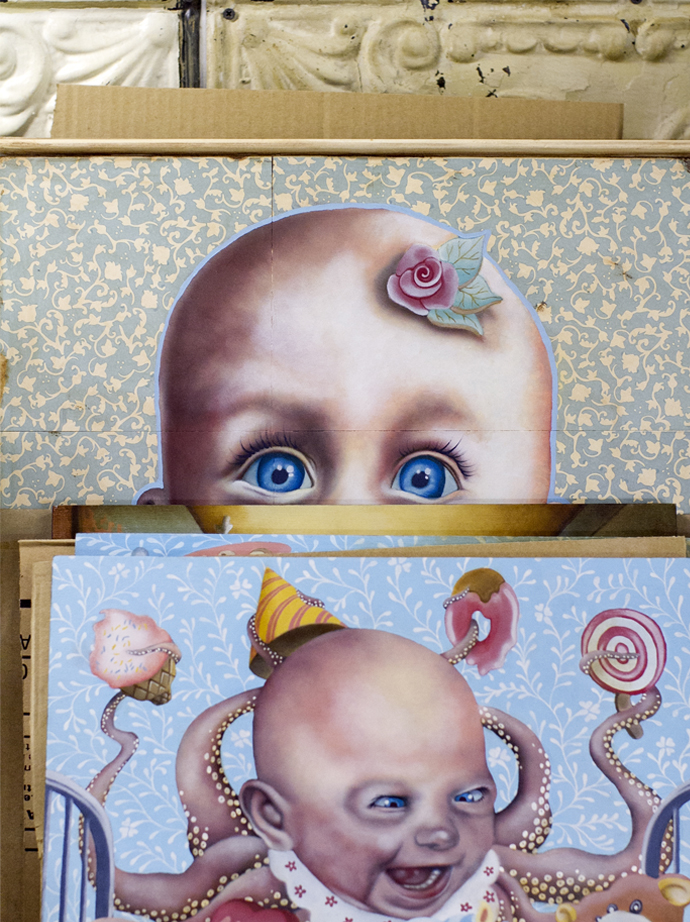 Creepy baby head: Robert Farmer.What’s the deal with the stuffed animals?Before I had the gallery I had the fake tortoiseshell lamp, which I bought in Paris, and then I bought, not knowing why, the baboon. I think I felt sorry for him, it was on the floor of a junk store and people were grossed out by it, so I paid $20. And so, when I got the gallery, a friend of mine asked me if I was going to bring the “creepy animals”. Then people just started bringing their stuffed animals to me, and it became a depository, kind of like an orphanage. You can bring your stuffed animal, but it needs to have a good valid story, like all the other animals there. I’m not online desperately looking for an owl! I don’t buy them.
Creepy baby head: Robert Farmer.What’s the deal with the stuffed animals?Before I had the gallery I had the fake tortoiseshell lamp, which I bought in Paris, and then I bought, not knowing why, the baboon. I think I felt sorry for him, it was on the floor of a junk store and people were grossed out by it, so I paid $20. And so, when I got the gallery, a friend of mine asked me if I was going to bring the “creepy animals”. Then people just started bringing their stuffed animals to me, and it became a depository, kind of like an orphanage. You can bring your stuffed animal, but it needs to have a good valid story, like all the other animals there. I’m not online desperately looking for an owl! I don’t buy them.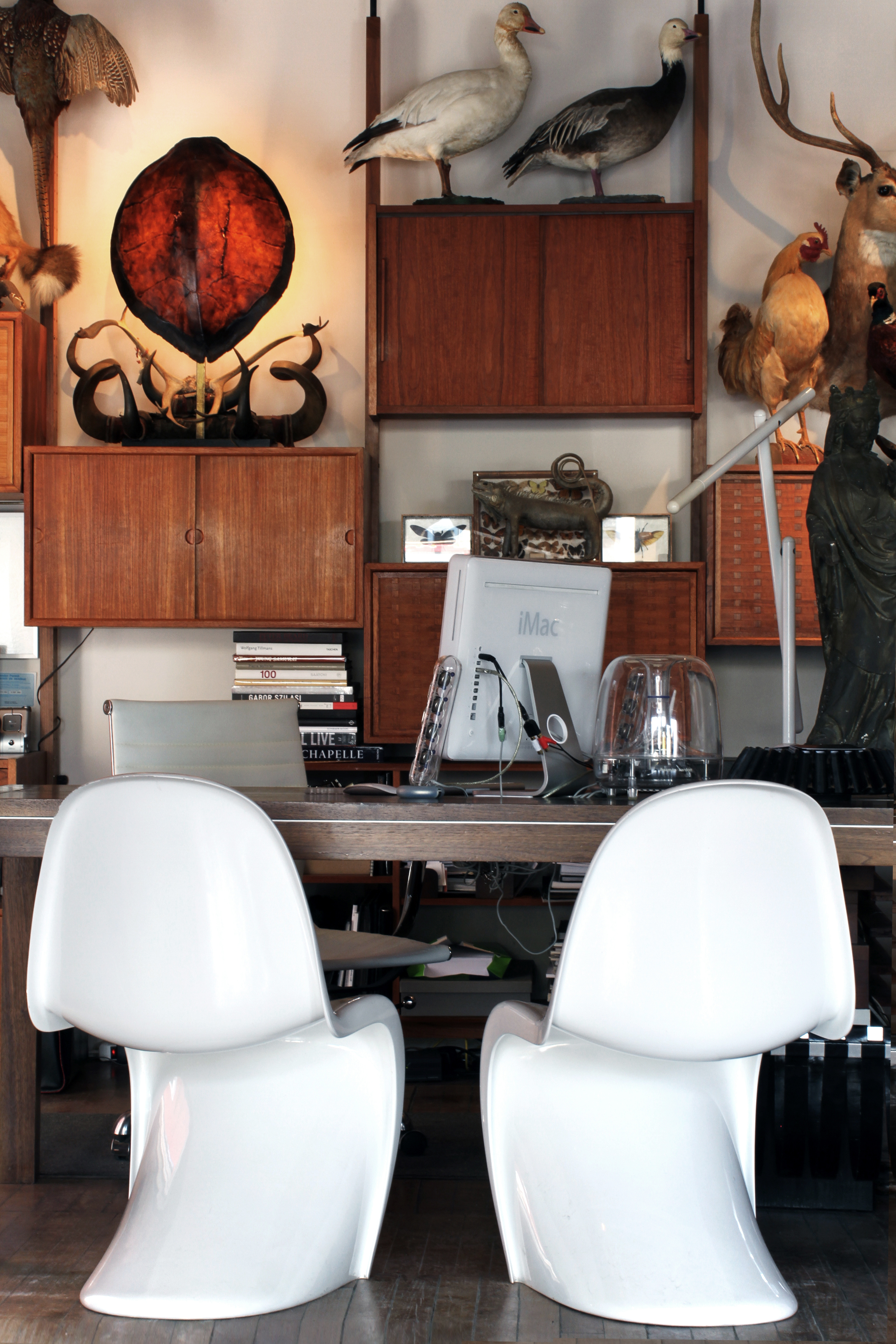
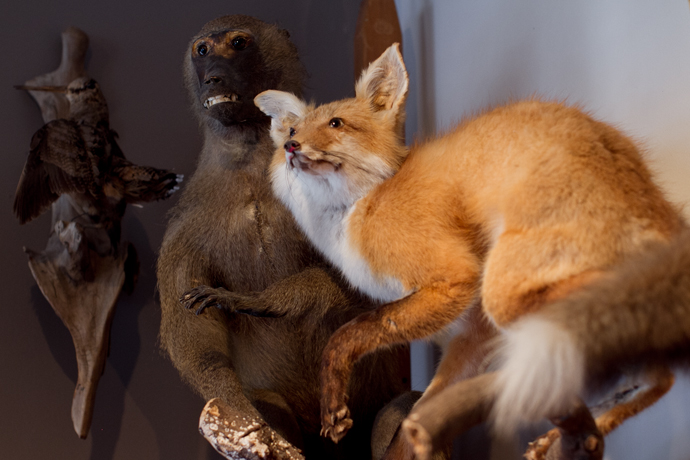 Guy's taxidermy collection.You must have some good stories…A woman once told me she wanted to give me a bison’s head, and I have always loved the look of them.So, we had a long conversation, and in the end she told me, “well, it hasn’t been taxidermied yet, it’s just the severed head” (laughs…) it was frozen!!!Make sure to check out La Petite MortSLAVA MOGUTIN & BRIAN KENNY
Guy's taxidermy collection.You must have some good stories…A woman once told me she wanted to give me a bison’s head, and I have always loved the look of them.So, we had a long conversation, and in the end she told me, “well, it hasn’t been taxidermied yet, it’s just the severed head” (laughs…) it was frozen!!!Make sure to check out La Petite MortSLAVA MOGUTIN & BRIAN KENNY
September 2 – October 2, 2011
INTERPENETRATION
Photographs & Drawings www.lapetitemortgallery.com -

editor MASANOBU SUGATSUKE : An edit of an edit
-Masanobu Sugatsuke is one of the most influential editors, publisher of magazines such as COMPOSITE, INVITATION or METRO MIN in his native Japan, and of books with Mark Borthwick, Elizabeth Peyton or Jeff Burton. Masa considers himself not exactly a trendy person, yet is always on a forward trail, much ahead of his time.
THE STIMULEYE talked with Masa on the outlook of publishing and the editors future role, but also his recent book EDITORIAL PARADISE in which he is looking on his past editorial work. A reflection in a radical manner, rarely dared by others of his guild.
An edit of an edit, a compilation of compilations?
He’d been advised by a fellow columnist that “When an editor enters the spotlight, he automatically announces that it is time for him to go” he was told, as well as “an expression reaches a deadlock the moment it becomes self-referential”.“But wait a minute,” he writes in his foreword, “Godard and Truffaut initiated the Nouvelle Vague with their filmic reflections on film; contemporary art has developed as a form of “Art reviewing art”, and Rei Kawakubo and Martin Margiela keep proposing dresses that inspire the wearers to think about dressing. Could it be that there exists a whole different level that self-expression can only reach after going through the painful stage of self-reference?”
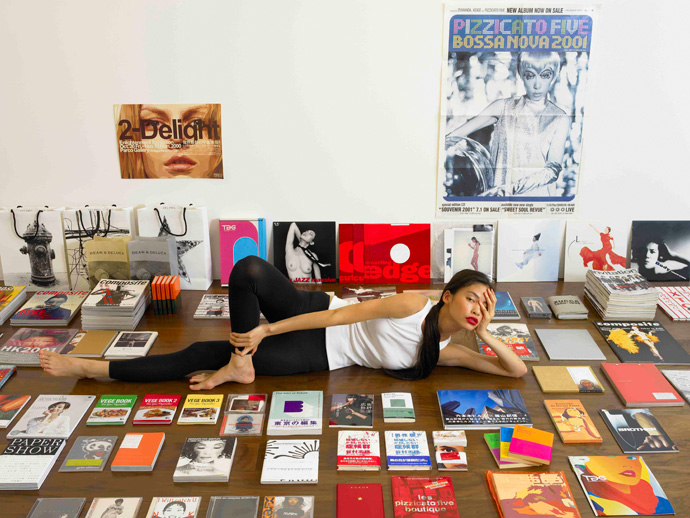 Works of Masanobu Sugatsuke laid out for EDITORIAL PARADISE.
Works of Masanobu Sugatsuke laid out for EDITORIAL PARADISE.When i visited you at you last time in Tokyo at your office – we had not seen each other for quite a long time.
Meanwhile you had halted “Composite” , and published your book “Editorial Paradise” revisiting your inventive editorial work of the last 25 years. Interestingly, this reflection coincided with a turning point, a time where the role of the editor is challenged through mechanics introduced by new media. To me it almost felt like a “katharsis” (精製) – in this context. Not only a personal one…
Talking about my book “Editorial Paradise”, I think that a retrospective book of a living editor sounds strange for everybody, even for me!
But to edit and launch it, it made me consider a lot about the role of editors and definition of editing nowadays.
I believe the role and definition of editors and editing has been drastically changing these days, because of the growing role of new media. But a few editors have been trying to define their new roles and public meaning.“katharsis” you mentioned is quite a suitable word to describe my time editing this title. Editing this retrospective is like confession for me. But confessing what?
I can tell you about it clearly now, I didn’t know the meaning of editing until that time.For this book you told me you’ve decided to include everything from the volumes that you’ve done, which is somehow “anti-editing” – was that part of making you realise the meaning of editing? What is your conclusion?
I’ve always aimed to expand the definition of editing. Through the editing process of this editorial retrospective, I recognized that the changing state of editing my thinking simple-minded.
So, what I came across through this process, – it was fun but hard for me to think deeply about editing all the time all day long and I felt like being ouroboros – is that editing is not about media.
I think editing is a way of thinking. It’s not like making film, designing a website. It’s a purely abstract idea to make something concrete.My definition of editing is quite simple.
1: Drawing up a project,
2: Recruiting a team of collaborators,
3: Creating something,They are the three basic conditions of editing, I think. If someone does something with these three conditions, whatever it is, I’d like to say “that’s editing”.
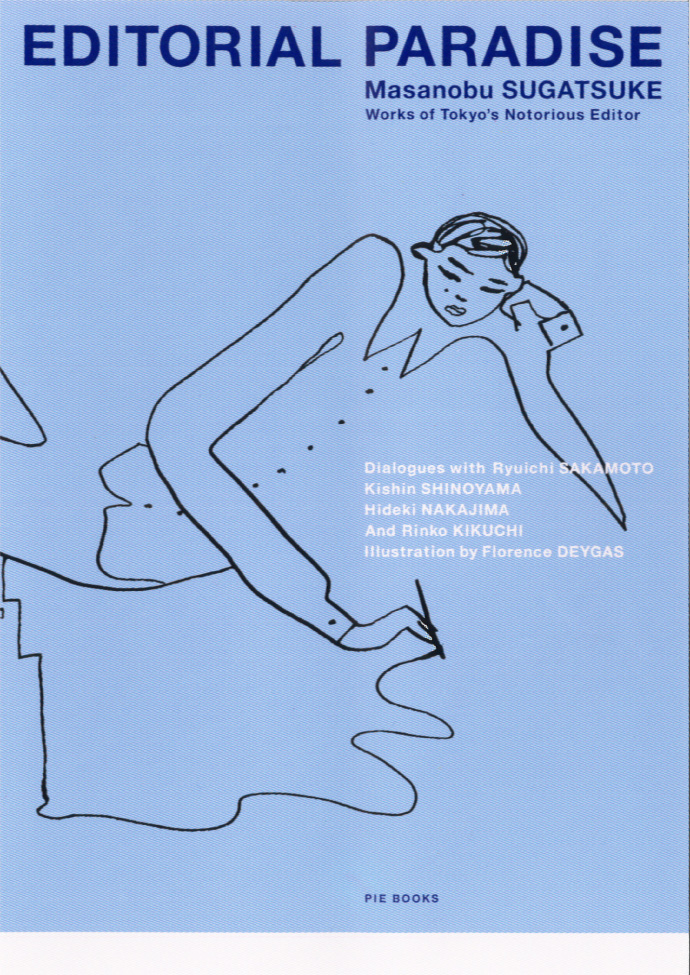
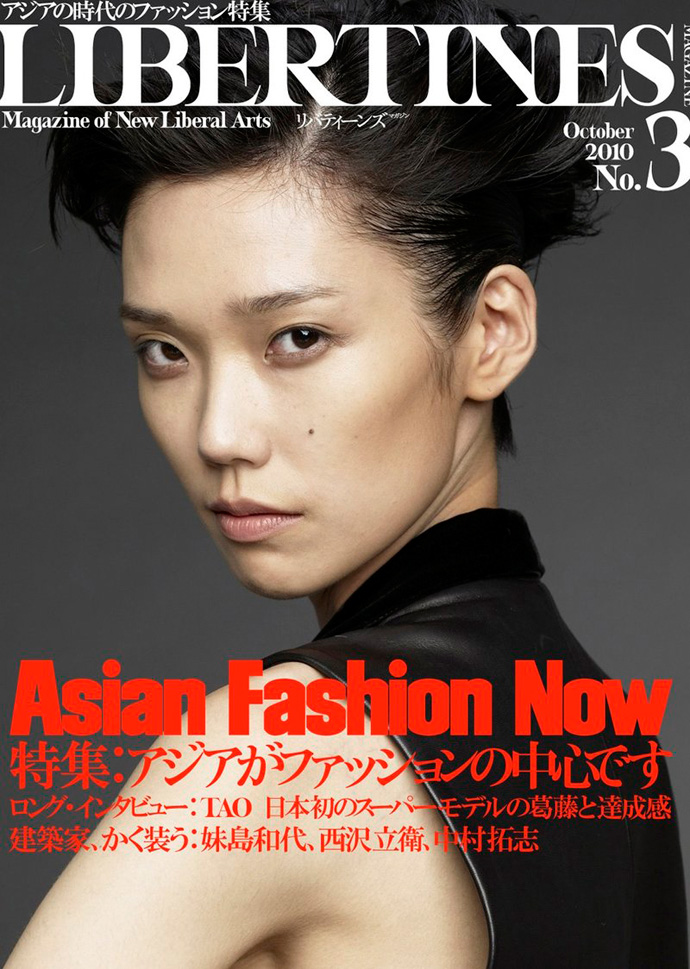 Sleeve of EDITORIAL PARADISE with an illustration of Masanobu Sugatsuke by Florence Deygas and a recent LIBERTINES cover
Sleeve of EDITORIAL PARADISE with an illustration of Masanobu Sugatsuke by Florence Deygas and a recent LIBERTINES coverIt’s something rare in this profession to put a focus on the act of editing itself, especially one’s own and in such a radical way as with your latest book.
As you can see, editors have been defined as interpreting someone to someone else, or something to something else. That means “Don’t express your own voice through your works. You are an in-between guy!”.
That’s 50% right. But there are so many high-profile advertising creative people all over the world. They are not behind the media at all nowadays.I believe editors are mainly present in-between and behind media, but sometimes they are beyond media, i.e, Anna Wintour, who is Cabinet Minister of the Ministry of Cool, Terry Jones, Everlasting Evangelist of Street Style and Olivier Zahm, the second Gainsbourg.
I believe we, creative people, have to label ourselves. In other words, we have to “transform life into creation”.
Because, in this 21st Century, our creative lives are almost viewed and leaked by web and twitter.
It’s been getting hard for creative people to avoid being watched or criticized by ordinary people now.Iconic editors from the past seem in this context like vanguards of another time to come:
Diane Vreeland (American Vogue) or, on another side of the spectrum, Hugh Heffner (Playboy), both transcended their editorial vision with their personal lives.Today’s ever more fragmented stream of information requests perhaps a stronger necessity of structure through the personal standpoint…
How do you think the element of today’s over-exposure is influencing the role of the editor?
Over-exposure is big phenomena in our world, not just for editors. Modern people are fame-addicted.
On the other hand, we can show our way of living as an art piece. Lady Gaga’s case is the most excessive one, and Haruki Murakami’s case is the most stoic.
But both are most successful presentations of life as art piece today.As I said, our creative lives are mostly viewed, watched by the media and each action are “timeline”d.
So if you can’t avoid it, you have to be determined to show your life as whole art piece, as if Andy Warhol presented us.
So, Warhol said “Everyone will be famous for 15 minutes” in the 60’s.
But now everybody became Andy Warhol, just like taking photo everyday, quoting somebody’s ideas and images and commenting as one phrase philosopher on twitter or blogs.Our creative works are slices of our creative lives. People nowadays have a tendency to prefer the real lives of creative people to their work.
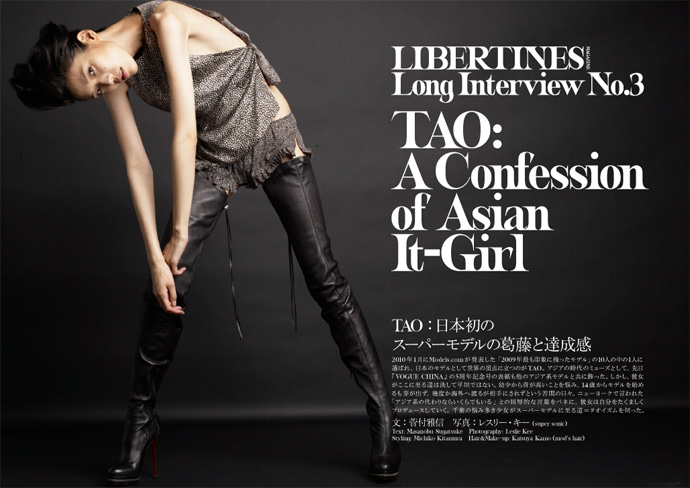 Spread of "AISIAN FASHION NOW" from a recent issue of LIBERTINES. Photo by Leslie Kee
Spread of "AISIAN FASHION NOW" from a recent issue of LIBERTINES. Photo by Leslie KeeIn these times, the stream of facebook statuses, tweets and re-tweets, tumblr and so on form a new way of consuming information.
You recently mentioned Paper.li to me – which seems like an attempt to “master” this stream almost a form of an “automatic generating editor”….Yes, “Paper.li” is a kind of semi-auto-updated personal web magazine. On the web, if you curate something, you can be an cool editor. Therefore “first hand” is getting more important for media and creative people. Audiences can’t get interviews of celebrities and take their photo first hand.
So, “first hand” sources and high profile people are the last sanctuary of professional media and creative people.
But if they are lazy to maintain “first hand” capability, audiences will rob it.The internet is certainly a big accelerator of this “theft”!
What we’re missing out besides “first hand” is the synthesis of information and its digestive analysis.
I am wondering how do you expect the print media to react to this and how you see its perspectives in the long run, in balance with the digital publishing?I expect that print media will live with digital media in symbiosis. I believe print media will survive, as opera and theatre play do.
But not mainstream in the media.
There are two kind of information, flow and stock.
Internet is a best media of flow information. Print media is a best of stock information.
For creative people, beautiful books must be great tangible assets.
In this 21st Century, tangibility and physical experience can be more important because internet cannot provide them.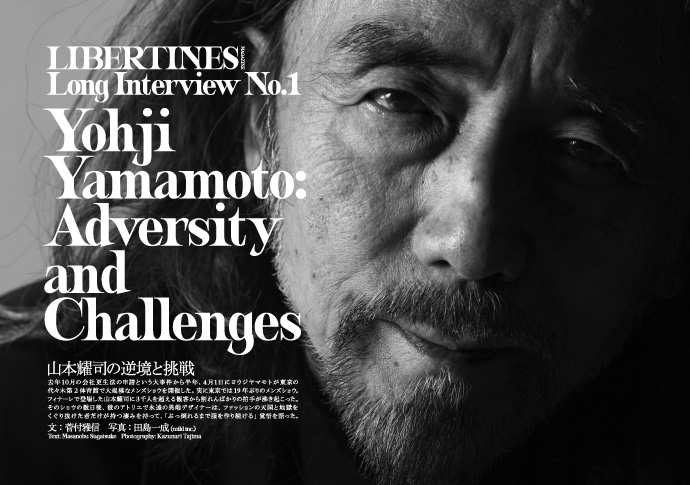 Opener of the Yohji Yamamoto Interview of LIBERTINES
Opener of the Yohji Yamamoto Interview of LIBERTINESYou have recently halted publishing your most recent print magazine “libertines”-
what was your experience with this? Were the reasons related to the shift in publishing that we’re talking about?Talking about the end of “Libertines” magazine, I think I was a little bit too optimistic about the advertising climate and today’s readers. It was my fault.
Advertising for magazine has been drastically decreasing. I knew it. But I had estimated that I could have get a certain amount of it when I started “Libertines”.
But I couldn’t. It was worst time to start a new magazine in Tokyo with a professional level of budget.Plus, I thought we could get a number of readers similar to what we had before. So, for the first issue of “Libertines”, we had a special feature about twitter culture.
We had exclusive report about twitter headquarters in San Francisco in it.
As you can imagine, we got big buzz on twitter and web when it came out.
BUT this buzz were not enough to sell magazine.It is a similar situation for musicians and the web. If some musicians get big buzz on twitter and facebook, but their record sales are not related with buzz unfortunately these days.
It happens in magazine world.I think “buying magazines” has become an old habit, or habit for people over 30’s.
If you aim to produce youth culture-medias and package contents, there are few actual youth consumers who buy them naturally.On the other hand, I’ve been directing another magazine “Metro Min.” for two years as creative director, it is quite successful because it’s a monthly free lifestyle magazine which is published by a major publisher.
So, it is hard to sell magazine to the FREE generation. I’ve been struggling with this issue.
I don’t have a clear solution for it. But I’m not pessimistic about the future of magazines. I think publishers and editors have to organize a new kind of structure to make profit not only to produce print medias.I believe there are great examples in the movie industry. The movie industry is not just about movie theatre nowadays as you know. It is an environment with movies.
I think that’s the hint for editors.

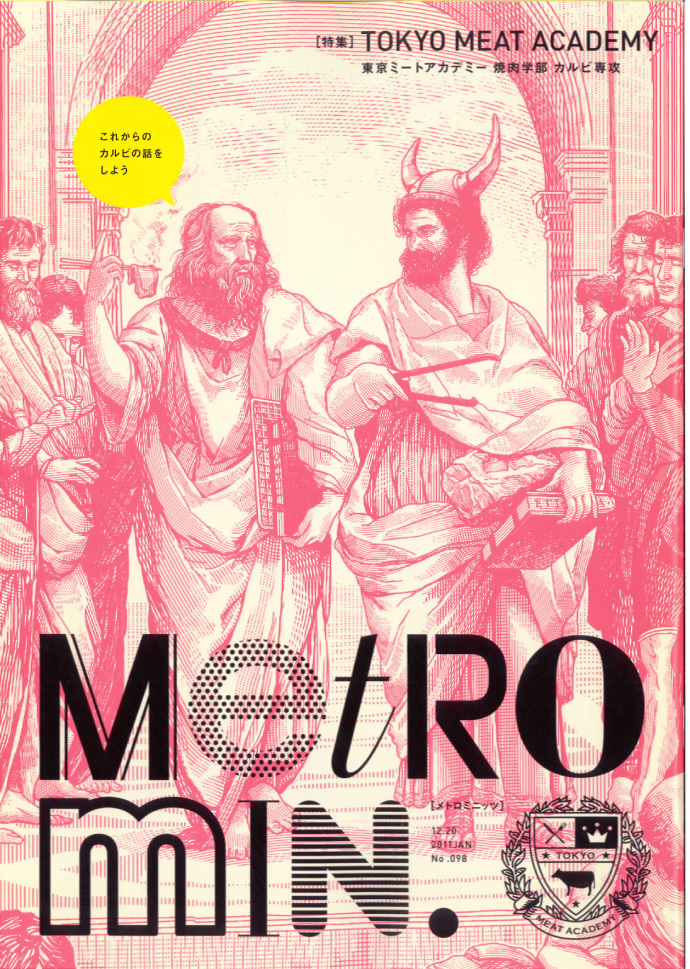 Covers of METRO MIN, the most recent publication of Masanobu Sugatsuke
Covers of METRO MIN, the most recent publication of Masanobu SugatsukeWhere do you see the future?
I’ve been thinking about the fate of both print media and new media all the time as I mentioned in our previous conversations.
And as you see, nobody knows. But there is one certain thing that I can say, that is if you love something, you’d like to own and touch it.
Same as your lover. That’s the human nature which will not change forever.People nowadays talk mainly figures and speed of modern media. But media are not only produced by them. Of course, these specs are important.
But images, sympathies, affections and favoritism are very important elements of media.
If these elements are all included in one media, then it will be a loved media no matter if it’s in the form of digital or print.I believe that creative people have to concentrate on how to produce a loved media to audiences. I think that’s the priority.
The last thing stimulated that stimulated you?
So many things and it is hard to answer to choose one particular thing.
Here is the list what I was stimulated after 3.11, the Great Earthquake in Japan.# Cindy Lauper concert in Tokyo on March 17th, just 6 days after Earthquake.
Cindy is a quite brave artist who did Japan tour in such a catastrophic situation and she commented during each break between songs to encourage audience in Japan.
She sang her masterpiece “True Colors” in encore with mix of John Lennon’s “Power to the people” and almost the whole audience, including me, wept.# Takashi Homma photo exhibition at Tokyo Opera City Gallery in April
Homma’s biggest exhibition in Tokyo which shows his conceptual landscape in Japan and Los Angels which was collaborated with Mike Mills.# Jane Birkin Charity live at Shibuya Club Quattro, April 6th
Jane Birkin is not just an actress or singer. She is a role model of modern women.# Anti-Nuclear Demonstration in Koenji, Tokyo, April 10th
Most biggest and joyful anti-nuke action in Japanese history. So many musicians joined it and I participated in it. People have the power!# Saburo Teshigawara dance performance at Kawasaki City art center, May 6th
It is a final answer to the question “How can movement of human body be radical and beautiful”. Teshigawara does European Tour this Autumn. Must-See!# Henry Darger exhibition at Laforet Museum Harajuku, Tokyo, May
Legendary outsider artist’s big retrospective. So innocent and scary.# Yohji Yamamoto’s 30th anniversary party of his brand at Y.Y boutique in Tokyo, June 1st
Yamamoto is a last samurai of cutting edgy couturier. Congratulation!
-

a screen within a screen – SUZIE Q & LEO SIBONI
-They’re not even close to turning 30.
And yet they are releasing their third fashion film superproduction, IS THIS REAL LIFE for designers Mastori and Motwary, on Vogue Italia; and doing the cover story for UNDER THE INFLUENCE, out on Friday.
They are… Suzie Q and Leo Siboni.
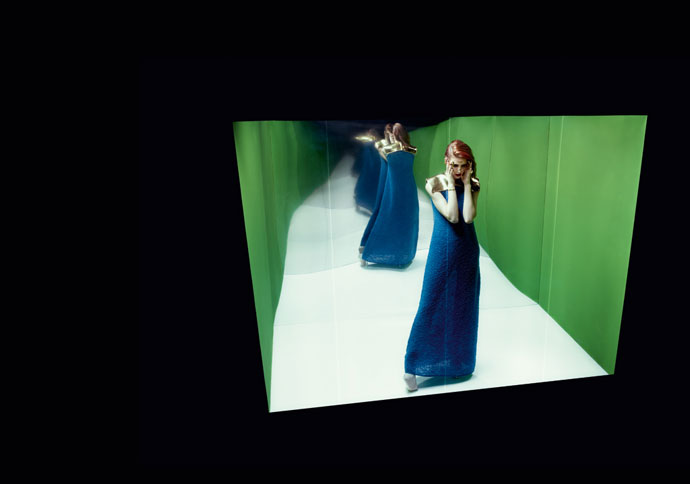 THE HEALING POWER OF ELECTRICITY, in UNDER THE INFLUENCE magazine, by Suzie Q & Leo Siboni.
THE HEALING POWER OF ELECTRICITY, in UNDER THE INFLUENCE magazine, by Suzie Q & Leo Siboni.Antoine Asseraf: how did the two of you meet ?
Suzie Q & Leo Siboni: We met while studying at Ecole des Gobelins, Paris, in 2005. At first we helped each other out for our personal projects, and then in 2007 we started working together.And what was your first project as a duo ?
It was a photo series for the fashion magazine DOUBLE, named SCREENPLAY. We used different films by John Ford, projected as a background.The idea was to establish a relationship between John Wayne and the model.
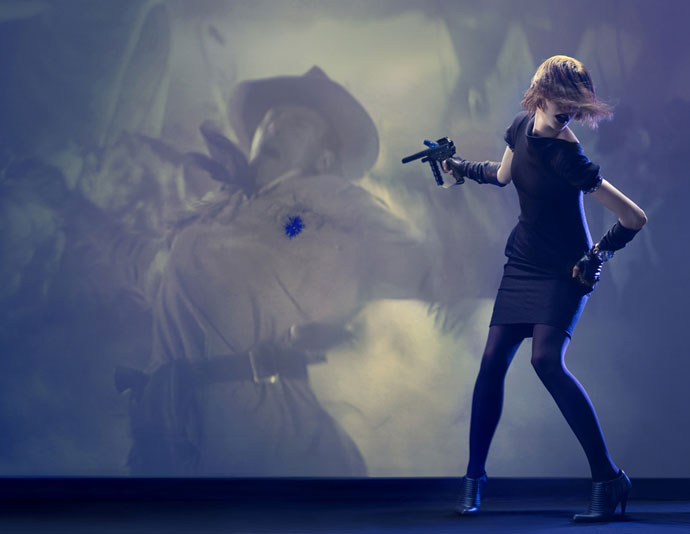 SCREENPLAY, by Suzie Q & Leo Siboni.
SCREENPLAY, by Suzie Q & Leo Siboni.At Gobelins, did you both study photography ? And why did you start with fashion photography ?
Yes, we both studied photography. For us fashion is a way to experiment, fashion imagery is about mise-en-scène, putting the clothes forward.Paradoxically, what we like the most are the constraints.
It helps you create, pressures you to act quickly. It’s rather intense.
Funny that your photo series should be about cinema…
Cinema inspires us a lot. We work more and more with the idea of an image within the image, of a certain depth, a frame within the frame. In the end I think we’re attached to the idea of the screen.
(more…) -

MAX SCHELER: from Konrad A. to Jackie O.
-The exhibition “From Konrad A. to Jackie O.” at the Willy-Brandt Haus in Berlin will show for the first time a cross section of the work of Magnum photographer Max Scheler. On display throughout June and July are 140 images that document the distinct view of this artist who preferred to stay in the background. From this intimate eye-level position, he witnessed his time and documented its events with impeccable framing and allure.
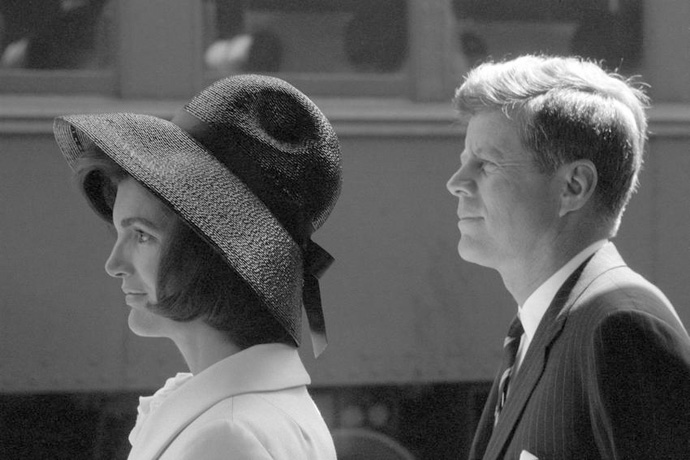 USA, 1963, Washington, John F. Kennedy and Jacqueline Bouvier Kennedy receive the Moroccan king Hassan II
© Max Scheler Estate, Hamburg Germany
USA, 1963, Washington, John F. Kennedy and Jacqueline Bouvier Kennedy receive the Moroccan king Hassan II
© Max Scheler Estate, Hamburg GermanyI remember Max Scheler with one of his beloved Davidoff cigarillos smoldering away nearby. He was an impressive character, with an elegant dryness that one would be tempted to account being Hamburgian, yet he was born a boy from Cologne. In his later years Max had dedicated his time entirely to taking care of the Herbert List estate – the iconic work of the photographer who shaped and mentored him. On one of my visits to the archives we went through folders and boxes of photographs and came so across prints of Max’ work for the first time, almost by accident. I had not been aware of his photography then, though i knew he had worked at Merian and founded the magazine GEO at Gruner & Jahr, introducing colour reportage to the wider audience.
I’ve talked with co-curator Olaf Richter, head of the estates of both Herbert List and Max Scheler about Max, his background and the relationship to Herbert List and the current exhibition
RENÉ HABERMACHER: How did this exhibition come together- and why right now?
PEER-OLAF RICHTER: The idea of this show was born in February 2003 – the month Max Scheler died. It took us about 6 years to finish this project. Why did it take so long? Max Scheler was humble if not neglecting his own work. He stopped working as a photographer in 1975 and since then had turned the tables. He rather worked to publish other photographers work, than his own.I took quite a bit of effort to rediscover what was going on in his life as a photographer. The negatives from the late 50s until the mid 70s were in a rough chronological order, but before that, the first 8 years, were all over the place. For us the first period was especially interesting, because it told us something of where he was coming from. He learnt photography from another photographer: Herbert List.
Herbert List printed the images that he considered important. The Estate had a rich base of vintage prints that covered all the projects he worked on in his life time. These prints were frequently titled on the back. The main books on List that had been on the market had all been made with these prints as a basis.
For Max Scheler things are very different. There is not that much vintage material, and it is hard to say if these old images reflect his personal choice or some editors preference. So we went back to the negative and contacts and researched there. Unfortunately the negative have only a rough labelling, and therefore it took a lot longer to make a selection, research locations and titles.
Max would always put Herbert’s work ahead of his own – which was something that I never understood. Why this hesitation?
I guess he felt that his work of that period, was the work of a pupil, while the work of his teacher, was really what was worth remembering. It is interesting how close the two worked together. After an initial year or two as an assistant on the road and in the darkroom, Scheler started getting his own assignments, gained some respect, moved from Munich to Paris, met Robert Capa and even became a junior member of Magnum.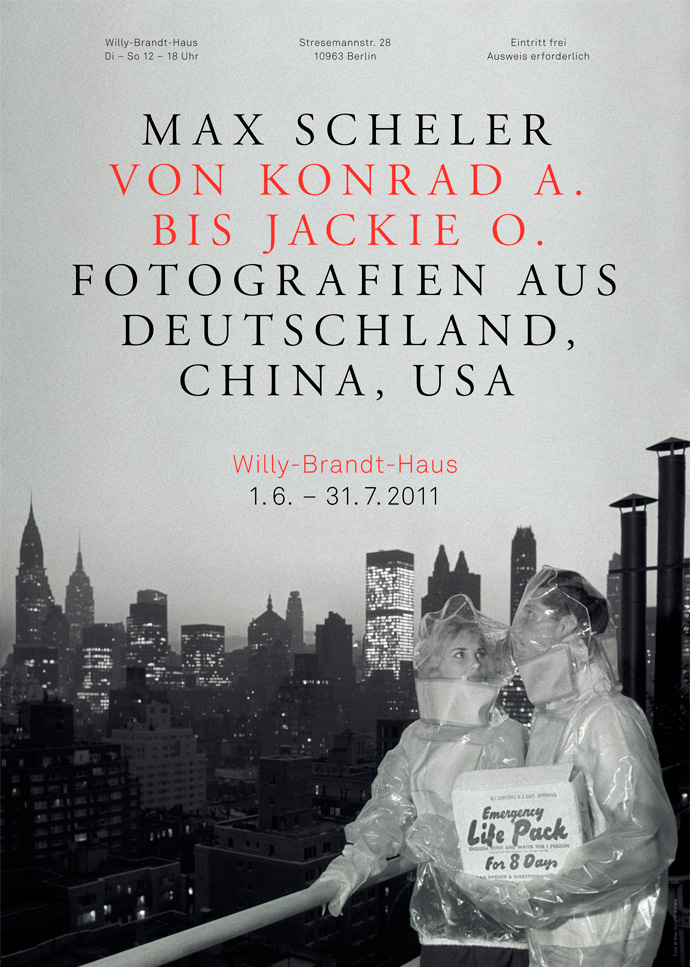
How did the relationship of the two evolve after the first meeting during war in Munich: personally and professionally? I am also asking that as I have a special interest in the idea of the “stimulating” mentor.
I guess stimulation needs at least to prerequisites. At first the receiver of the stimulus needs to be in a situation of wanting to open up, receive a certain change in her/his perception and possibly even her/his life. And the stimulus must also be desireable and fit the pattern of interest of the receiver. If the stimulus is too foreign or threatening it might be rejected. I think these things fell in place when Max Scheler met Herbert List.He was very young then- it must have been the shaping experience…
Max and his mother left Cologne in 1941, when Max was 13 or 14 years of age. Around the same time List left Athens, because Germany invaded Greece. He had tried to immigrate to the USA but failed and had to return to Germany. Max was raised without a father, since he died the year Max was born. The sudden presence of a male person of authority in the life of Max and his mother was quite welcome. Not to be misunderstood all three of them were very liberal, unconventional and forward thinking persons. None of them wanted to construct a classical family. It was more the realisation of his mother that this very sophisticated photographer in his forties did spark some certain interest and outlook in the young max’ life, that she possibly could not, because the was too close. She of course realized that he was gay and therefore no husband material. But she might have also understood that the conventional reaction of a mother to not allow her son to have contact to a 25 years-older gay man, would have been rather short-sighted.
So through the turmoil of the war they kept close contact.
The stimulation we talked about earlier, that caused Max Scheler to learn a craft, languages and a certain ‘savoir vivre’ from Herbert List, developed through that time.
And I think that it was manyfold. I am not sure if photography was really the most potent influence here. And I am not sure what was going on between the two of them emotionally. Did they fall in love? That is speculation, but I guess it safe to say that a certain amount of love and trust is necessary to allow oneself to be stimulated.
(more…) -

ERWIN BLUMENFELD: through the eyes of his son Henry.
-On the second day of the fashion and photography festival in Hyeres, I watched Henry Blumenfeld, elementary particle physicist and son of Erwin Blumenfeld, inconspicuously walking through the exhibit of his father’s work at the Villa Noailles. He was wearing a tan suit, sneakers and a baseball cap that was slightly crooked on his head. Before long, the spacious, bright room where the artist’s photographs and videos were being exhibited became empty and quiet. Only the slight hum of voices around the villa could be heard through the walls. Here, surrounded by a collection of stunning and rare examples of his father’s work — large-scale, restored prints — Henry sat down with us for an intimate conversation: Erwin Blumenfeld the artist, the father, the mentor and the man of perseverance.
by Lynsey Peisinger, Photography René Habermacher
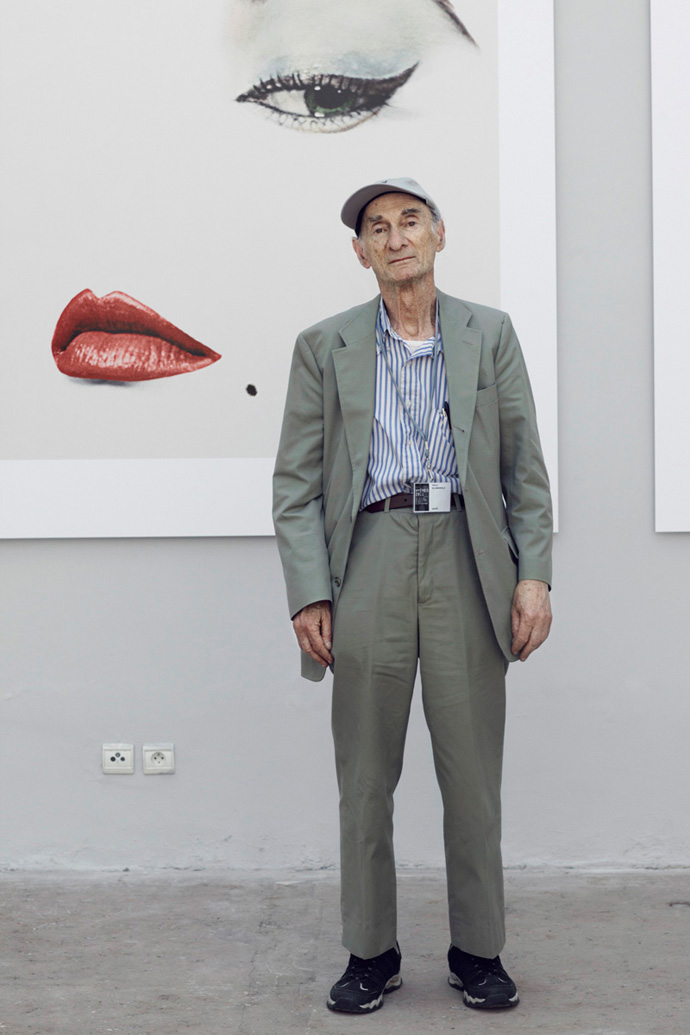 Son Henry Blumenfeld in front of his fathers DOE EYE with Jean Patchett for Vogue US 1950
Son Henry Blumenfeld in front of his fathers DOE EYE with Jean Patchett for Vogue US 1950LYNSEY PEISINGER: Where were you born?
HENRY BLUMENFELD: I was born in 1925 in Zandfoort near Amsterdam. My father had been an ambulance driver during the first World War. During the war, he had met my mother who was Dutch, Lena Citroen, who was a cousin of Pal Citroen, a German/Dutch artist. He grew up in Berlin with my father and they went to school together and they were very close friends. Through Pal, he met my mother and they corresponded during the war. My mother came to visit him in Germany when he was a soldier there. He tried to leave Germany, but he couldn’t. So, just after the war he came to Holland and then, a little bit later, married my mother in the early 20s. I guess, 1921. And because he was German and she was Dutch, she became German — that was the Dutch law at the time. I was born in Holland, but because I had a German father, I also became German.
LP: What was your father doing at that time?
HB: He was surviving. Leaving Germany at the end of the war, he tried to survive with the help of my mother and set up some kind of art dealing business with a friend, but that didn’t work very well. He was doing a lot of collage and kept in touch with other German Dadaists. After two years, he started to work as a clerk in a department store. Later, around the time I was born, he opened his own shop called the Fox Leather Company, selling ladies handbags and suitcases on the Kalvestraat. That went fairly well, but soon Hitler came to power and the business went badly and eventually bankrupt. That’s when he decided to become a photographer in 1934.
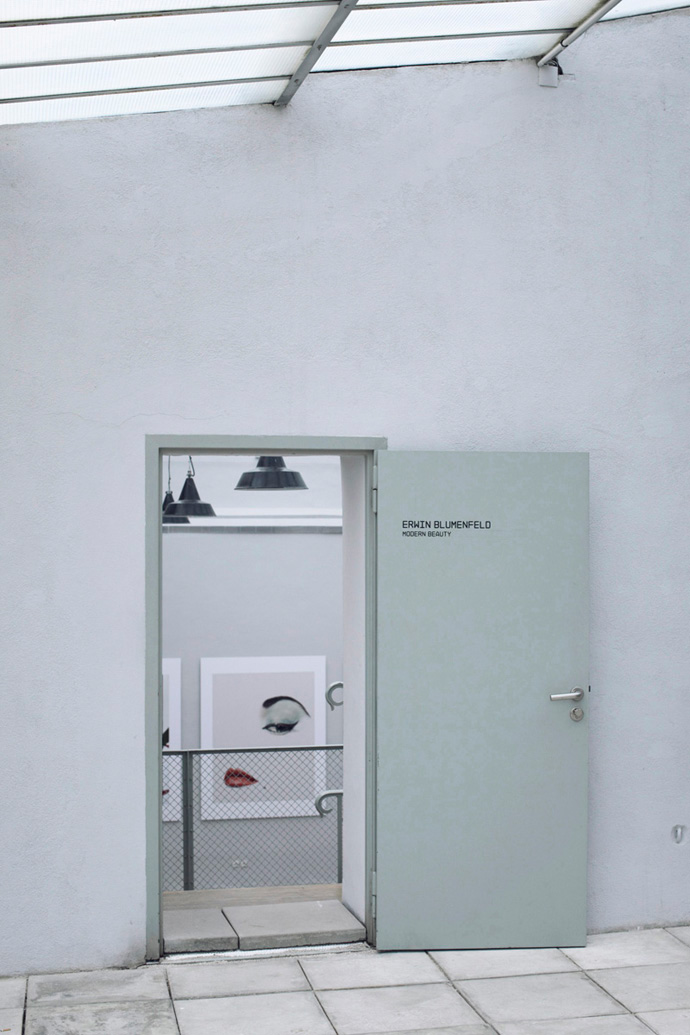
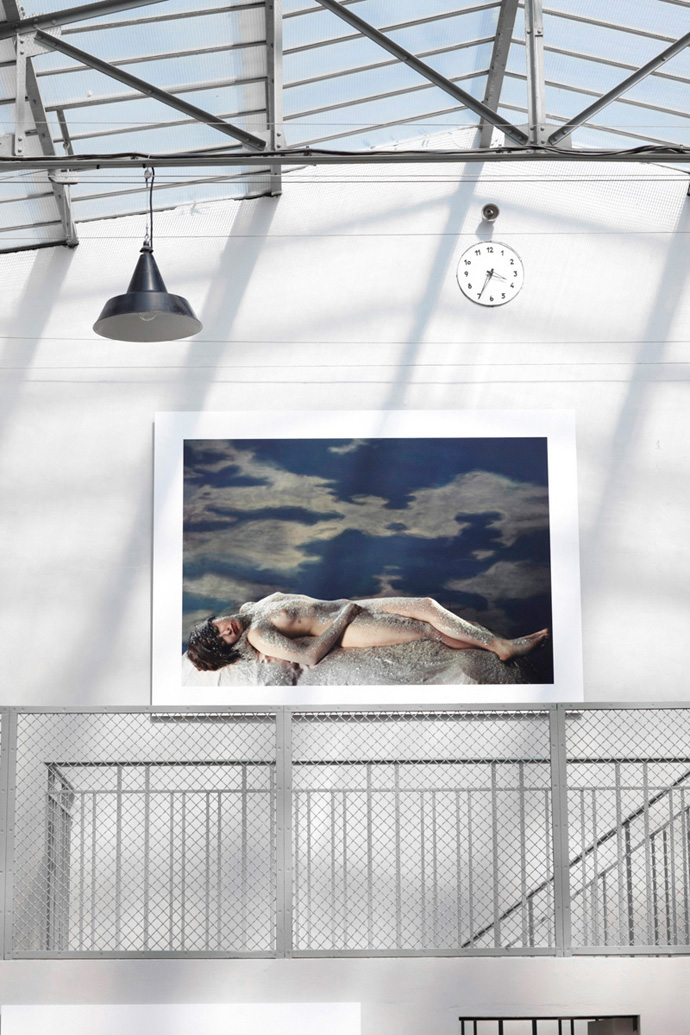 ERWIN BLUMENFELD Exhibition at the villa Noailles Squash Court. Right: Erwin Blumenfeld OPHELIA 1947
ERWIN BLUMENFELD Exhibition at the villa Noailles Squash Court. Right: Erwin Blumenfeld OPHELIA 1947RENE HABERMACHER: So your father’s first art oriented interest was collage and he was in the Dadaist movement?
HB: He was already interested in photography. He got his first camera when he was about 6 or 7. But his main interest was perhaps the theatre. That was something he was strongly attached to: the German language. His Dutch always remained a little bit feeble to say the least. He worked quite a lot, but with theatre in German language, he couldn’t make much of a living… With his collages he couldn’t make a living with that either but always kept in touch with the Germans — Grosz and Richard Huelsenbeck and other people of the Dadaist movement. Recently there was an exhibition in Berlin on this periods work of my father and a book has been published.
LP: Did he continue to do collage later on when he started doing photography?
HB: No. When he was doing collage, he was also painting — he was a Sunday painter: He did quite a bit of painting on Saturdays and Sundays. But he dropped doing his collage and the painting and started doing photography in Amsterdam. The business went rather poorly, he had health problems and more or less escaped to Paris around the 1st of January 1936. The first year it was very difficult for him to make a living. He got support from the family of his wife, of my mother. On his side he didn’t have much family left. His father had died before the first world war and his mother deceased shortly afterwards. He lost his brother in the war as a soldier in the German army and his sister died of Tuberculosis shortly after.
My father was friends with Walter Feilchenfeldt’s wife Marianne. He was a quite well known art dealer in Zurich. Mariane Feilchenfeldt helped him to rent his studio in Paris at 9 rue Delambre.
RH: So in Paris he got introduced to photography on a professional level?
HB: Already in Holland he was doing it on a professional level. He took many portraits and pictures there, but they didn’t sell much. He got in touch with some French people who came to Holland and they eventually supported him when he went to Paris — like Andre Girard the painter. Then, after about a year later, he started to sell photos to small photo magazines in the US and England, such as Lilliput. In 1937, he met british photographer Cecil Beaton who introduced him to Vogue. My father started to work for Paris Vogue in 1938.
When he was in Paris, he worked only in black and white. Color was not yet really developed for photography. It was very difficult for individuals to use color in their own studios, so he only did black and white while he was in Paris. I should mention that for his Paris period, his publications in Verve were very important. He had some of his striking black and white photos published in the first issues of that magazine. In the dark room, he experimented a lot, but only in black and white.
Then came the war and during the war, we were foreigners in france — we were not really refugees, but were without status, so it was quite difficult. In the beginning of the war, we were more or less exiled, we lived in a hotel in Vessely nine months, a sort of medieval town in Burgundy, France with a really nice cathedral. Then the Germans came and my father and sister were put in a camp. My mother and my brother and I, with the help of some Citroen cousins, managed to escape to the south of France. Our father was then in a rather horrible camp in France. We stayed in the Country until 1941, trying to get out. Then we managed to get a visa for the US — my father had been to the US already, in June of 1939. That was were, I think he took his first color photographs. He came back to France in July 1939 and he was stuck in France for two years. Then when we got to go to the US, he started working first with Harper’s Bazaar for two or three years, switched to Vogue and started doing color photography. At the time, he took his color pictures in the studio, using different color lights and so on — he was very experimental. But for the development and the printing, it was completely out of his hands. It was always done by Kodak. At the time, he couldn’t do anything in color on his own in the laboratory.
Most of these photos here were printed by Kodak. When I say printed, they weren’t really printed, they were large color transparencies. Like big negatives — 12 by 15 inches. I think that all of these photos here were taken in this large format and they were transparencies. The pictures were only printed for Vogue — working from the transparencies. Sometimes my father would give some direction on how they should be printed, but he was not generally involved in the printing itself. Only later, around 1956, they started to develop a new process called C-Prints. He bought the C-Print machine and he could start doing his own color. But C-Prints were very unstable as far as the color went — if they were exposed to light, in a few days they would essentially vanish. So all of his work in C-Print is essentially gone. Even the color transparencies that we have of his work have either faded or changed color a lot. Especially the reds, had faded. So, our doughtier Nadia has worked a lot with Olivier Berg at a laboratory in Lozère to try to restore the original colors. She is using the original publications because those prints have kept their color much better than the transparencies. So what you see in this exhibit is the result of the work that Olivier Berg and Nadia have done.
RH: Would you say that your father was somebody who was very progressive and pushing for new things in general?
HB: I don’t know about new things…. He was for the experimental, which is a little bit different. I don’t know if he was really striving for new things, but he tried to do do things differently and experimented. He was very much inspired by especially old painters like Goya and Renoir and much impressed by Picasso. I don’t know if he ever got to meet Picasso in Paris at the time. But he met quite a few artists as Dali and others.
 Erwin Blumenfeld advertising for PALL MALL circa 1957.
Erwin Blumenfeld advertising for PALL MALL circa 1957.RH: But he liked the experimental, so maybe that was something that remained with him from the Dadaist movement?
HB: Yes, that was important to him.
LP: I heard Michel Mallard talking earlier about how remarkable it is that there was no photoshop or digital editing at that time… this image, this one with the lips and the eye, DOE EYE, where the nose is missing and there is color separation, was this done in the retouching process?
HB: This was done in the process of retouching. It was an original black and white picture. It was colored afterwards by my father and by Vogue. They worked on it together. That was a special case because the others that you see were done in color and then reworked. This one did not originally have these colors.
RH: When your father was working, did you often witness his process and how he worked in his studio?
HB: No. When he was in Paris, working in black and white, I was somewhat present. But afterwards, in the States, I was not really present anymore. So I didn’t really witness him working in color.
RH: Was his approach as a photographer more controlled or more spontaneous?
HB: I think both. He was quite controlled — all of these pictures here were taken in a studio. But he also traveled quite a bit in America and in Europe and he took many 35 millimeter color slides. Incidentally, the color of those slides kept much better than the color on the transparencies. But, in the studio, he was very controlled and would take many pictures to get something specific in a sitting.
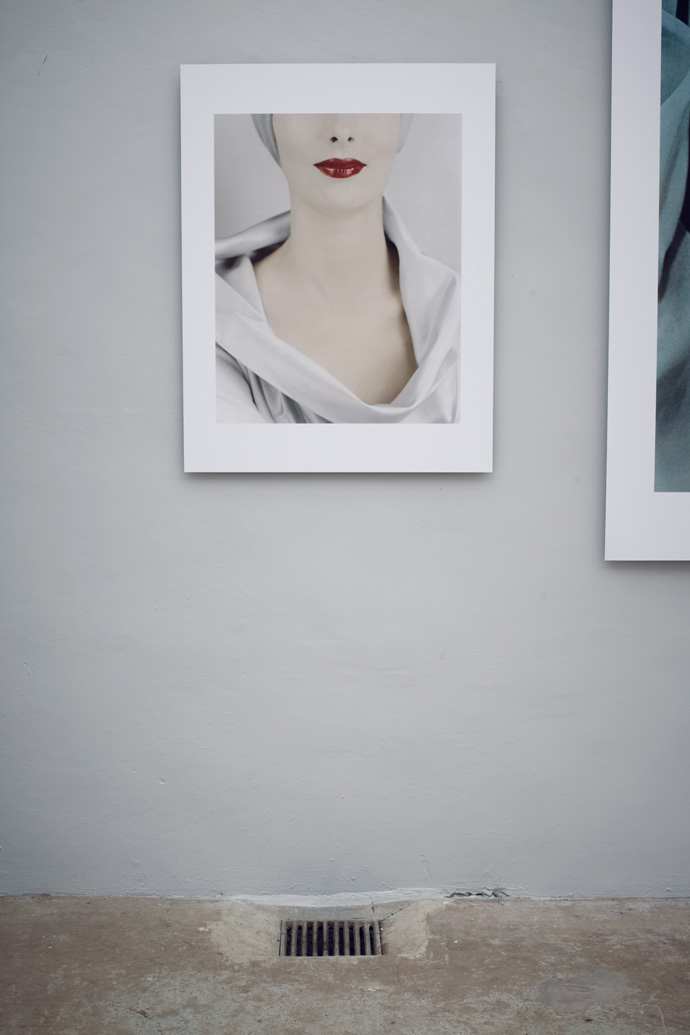
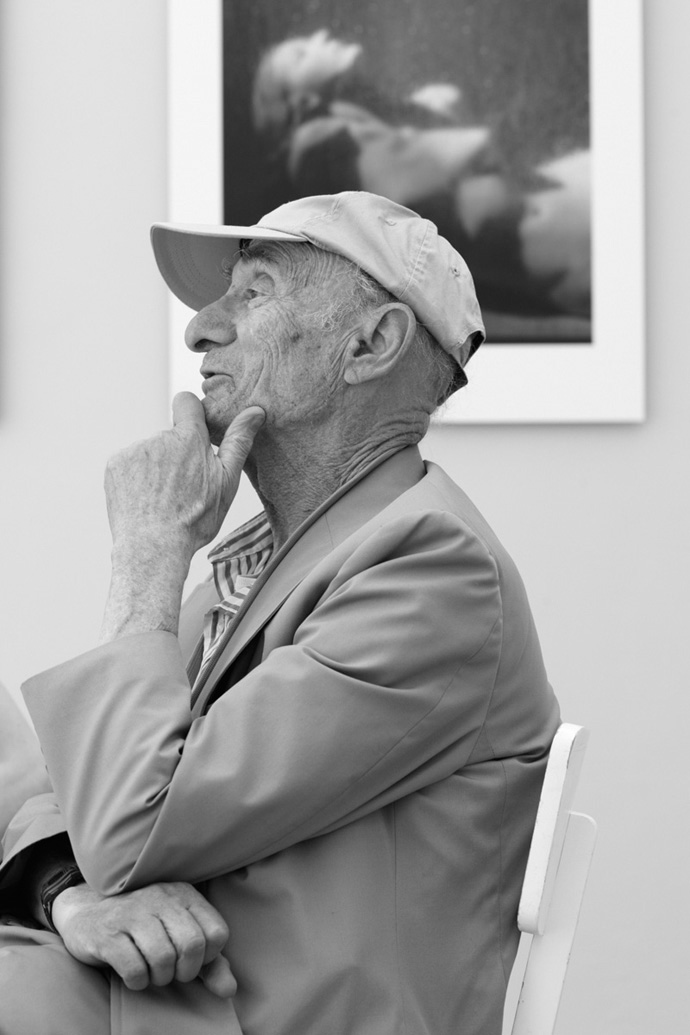 Left: Erwin Blumenfeld LE DECOLLETE 1952, RIGHT: Henry Blumenfeld in Conversation
Left: Erwin Blumenfeld LE DECOLLETE 1952, RIGHT: Henry Blumenfeld in ConversationLP: In Paris, were you present when he would shoot people in the studio?
HB: Sometimes, but not very often. I was more present when he was working in the dark room.
RH: I recently saw notes from Richard Avedon where he had a black and white print and he marked on it all of the places where he wanted the development to be darker or lighter using manipulation techniques in the dark room. Was your father working with these techniques too?
HB: Yes in the dark room, for black and white, he manipulated a lot. It would have been interesting to see what he would have done with color photography if he had been born fifty years later. At the time, the technology wasn’t there for him to do anything after a picture was taken in color.
RH: Where would your father have his intellectual and creative relationships — in other photography or painting etc?
HB: I would think painting. Very much painting, classical painting. Many of his photos were inspired by different painters. He was also inspired by modern life and by life in NY at the time, in the 40s and 50s. He liked jazz music very much, in the New Orleans style.
And he was quite interested in looking at television when it first came out. We got our first television set around 1950 or so. It was black and white at the time. I don’t think he ever saw color television. Maybe he saw it, but he never had one. He liked movies — but more for the content than for the photography. He liked Nanook of the North, about a Danish explorer. He was interested in movies — liked Erich Von Stroheim and he liked Sunset Boulevard and Billy WIlder.
RH: Was that love for cinema also what led to him making films?
HB: The filming was more in line with advertising. I think he was trying to see if he could use the filming for advertising, rather than to tell a story like in movies. Now you see everything mixed, advertising and movies. But at the time, it was an experiment.
RH: Do you think that your father really divided the things that he did for himself and the things that he was commissioned to do? The time after the war was quite commercial driven in America — was it easy for him to also do what he wanted to do?
HB: For one thing, the black and white and the color were two different things. In black and white, he could do what he wanted. In color, probably none of them were published in the exact way that they had been taken. They were made and developed specifically for Vogue. He did appreciate the possibility to work in color, but the whole fashion business and the way it worked was not very attractive for him. But still, when he had started out in Germany, he had started out working for a textile company and so, even then, he was interested in materials and fashion. Still, he didn’t really appreciate the fashion magazine business, but he knew that he could make his living there. So there were two sides to it for him — on one side, it was a place for him to make a living, on the other side, it gave him the opportunity to work in color, which he might not have had otherwise. He did have certain resentments, which is true for everyone in any job.
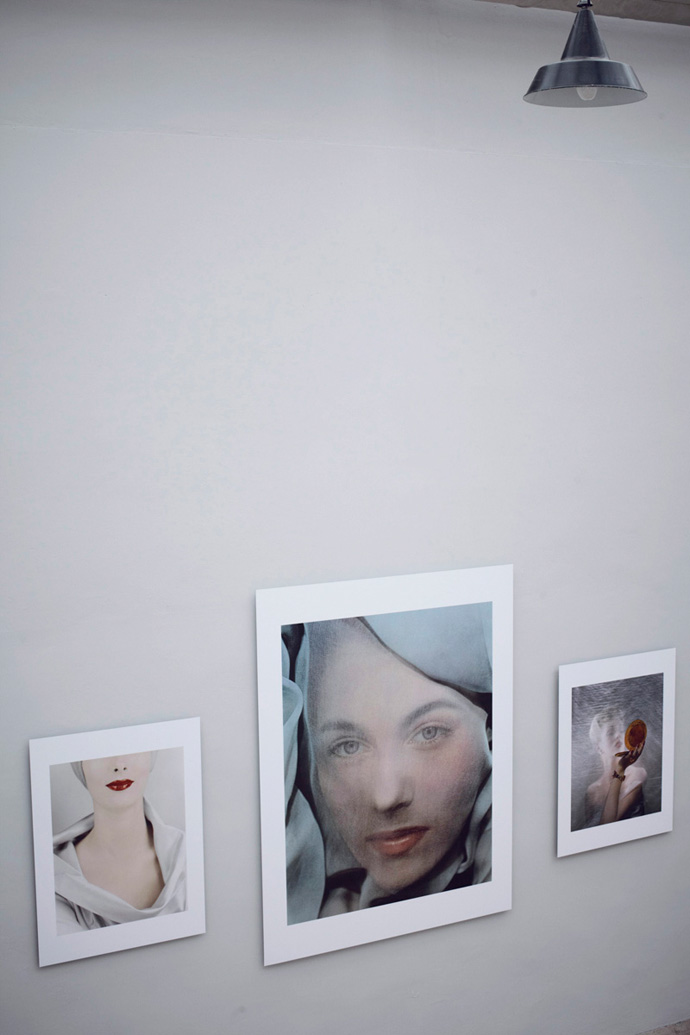 Erwin Blumenfeld DECOLLETEE and BLUE both 1952, and POWDER BOX 1944
Erwin Blumenfeld DECOLLETEE and BLUE both 1952, and POWDER BOX 1944RH: There are artists who suffer between the economical need to do something commercial and the desire to make the work that they are passionate about. They can feel torn…
HB: I don’t think that was his case. First of all, he did well financially in the 40s and 50s and he appreciated that. And then, because of that he was able to continue his work in black and white. You might have seen his book “My One Hundred Best Photos”. We have people comment on the fact that there is almost no fashion in that book–he did a little fashion photography in black and white for Vogue before the war, but later he didn’t do any fashion work in black and white. But, it gave him a lot of satisfaction to be able to do that book of his black and white work.
Still…he wasn’t always satisfied with everything. Becoming old for him was very difficult. It made him suffer a lot…some people accept it, but he accepted it quite badly.
LP: You said that he was experimental as a photographer. As a person and as a father, did he also have that type of attitude? And did he transmit that type of approach to his children?
HB: Well….I think he had his ups and downs. He was a very active father in many ways. He was involved with his children and either pleased or displeased with what they were doing. I don’t know….the children turned out very differently. I became an elementary particle physicist. My brother became a writer. He is not exactly politically minded… he is interested in art, sociology in many ways and in the way people behave. He was very rich in ideas my father, perhaps more so than his children.
LP: Did any of his children take an interest in photography?
HB: Interest yes, but not active in photography. Though, my wife became a photographer. She was born in Paris to an Algerian/Russian father and a British aristocratic mother. She survived the war in France — her father was Jewish, her mother was British, but anyway they would have liked to capture her. After the war she came to New York and worked for one year for the New York Times, one of the first women to work in a non-secretary position at the New York Times. Then she went back to France and when she came back to the States, the New York Times fired her because her vacation to France was more vacation than they were willing to give. Then she met the wife of Alex Liberman, the editor of Vogue, and became model editor at Vogue. Her job was to provide models for the photographers. Then she met my father and after a fews years, she started working for him. She started representing him. She never got any lessons from him in photography but she worked with him as an assistant– sending his photographs to different commercial companies. Then after we got married, she became a photographer herself and worked quite actively as a photographer. First a bit in Princeton where we lived. Then in Geneva for a few years. Then we came to Paris and she started working for Vogue and other magazines. She did mostly portraits of personalities and important political people and scientists etc. And other side projects, like children photography too. To a large extent inspired by my father. Of course, after we got married and had children, my father got another assistant, Marina Schinz. She became a photographer too — mostly garden photography and published a book on that.
LP: It is interesting that she worked with your father, who was doing a lot of fashion photography and then she became a garden photographer…
HB: She admired his work very much and when he died, she bought his studio on Central Park South. And she didn’t have a single photograph of his on the wall.
Both she and Kathleen, my wife, probably wouldn’t have become photographers without him. They were inspired by him, but they probably felt that they couldn’t really rival him, so they chose different styles.
LP: Do you think that he was a good teacher?
HB: He wasn’t really a teacher. But he was a big influence. My wife saw how he worked, but he never tried to give her lessons. Same with Marina Schinz.
When my father died, he let Marina handle his photographic inheritance. From the point of view of his will, it was never very clear…He left the photos with her and she tried to handle it the best possible way. So she divided all of the black and white photographs into four lots–one for each of his children and one for herself. Then she gave essentially all of the color transparencies to Nadia. Now Nadia has been quite active in promoting her grandfather’s work. She is now working on an exhibit for next year in Chalands sur Seine. There is a photography museum there and next year they will do an exhibit of my father’s work.
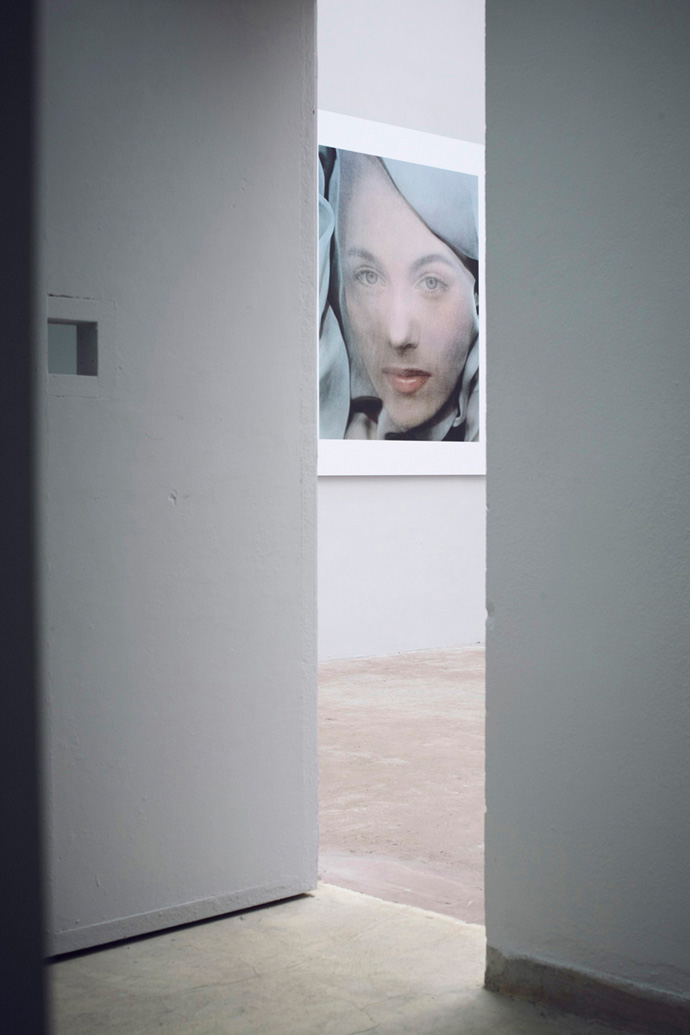
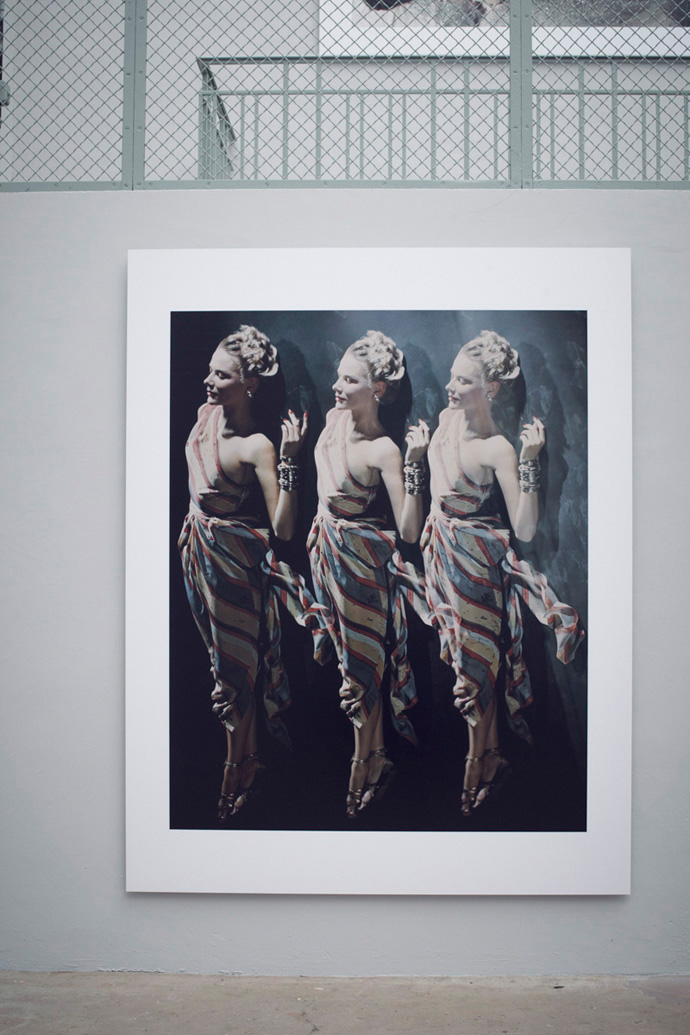 Left: Erwin Blumenfeld BLUE with model Leslie Redgate 1952. Right: Erwin Blumenfeld VARIATIONS, unpublished 1947
Left: Erwin Blumenfeld BLUE with model Leslie Redgate 1952. Right: Erwin Blumenfeld VARIATIONS, unpublished 1947LP: What is the last thing that stimulated you?
HB: What do you mean by stimulated? Something that affected me? Well, the thing that affected me is that my wife, Kathleen, died three months ago. Clearly that affected me. She had been sick, her brain didn’t work anymore. She was going downhill for ten years and in the last two years, she didn’t talk anymore. I don’t know what went on in her head. And three months ago, on the 9th of February, she died next to me…That is the thing that affected me. Also, what affected me was, she died very peacefully next to me. I didn’t realize that she was dead until I felt her and she was still warm and the kin came and said “votre femme est morte”. The morning afterwards, I got the announcement that a second great grandchild had been born. That also affected me. The day afterwards was the funeral and that was quite a moving event–we had five of the grandchildren and they made speeches and my children made speeches and I made a speech. One of the granddaughters filmed it and I now have it on dvd. So, that too affected me. I could tell you more, but maybe that’s enough for the moment.
Kathleen had been very close to my father and she admired him very much. Over the last ten years, she slowly went out of this world.
Thanks to our daughter Nadia, Kathleen had two double page spreads in Match in the last year. Nadia had given the pictures of Kathleen to Roger Viollet and he organized the spread.
RH: What is your work?
HB: I am an elementary particle physicist, experimental! Which is quite different. But I worked first with Cloud Chambers and then with Bubble Chambers and so I surely took more pictures than my father did. Of particles. Millions of pictures.
-

SAVE TOKYO CREATION
-This week, under the helm of curator Takafumi Kawasaki, 18 hot Japanese fashion brands and 10 photographers team up in Tokyo for SAVE TOKYO CREATION. As the official Tokyo fashion week was cancelled due to the recent events, stylist Takafumi Kawasaki initiated this show to give young designers an opportunity showing their collections from May 27th to 29th at EYE OF GYRE, Omotesando, Tokyo. Accompanying the show, artworks by Tokyo Posse ENLIGHTMENT will be on display, and a fanzine produced.
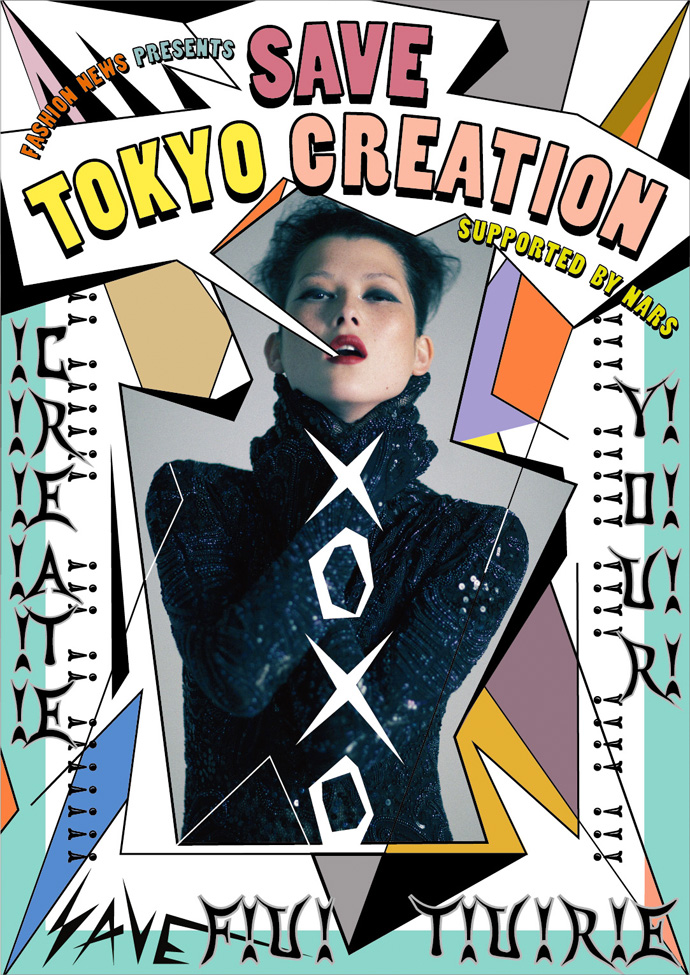
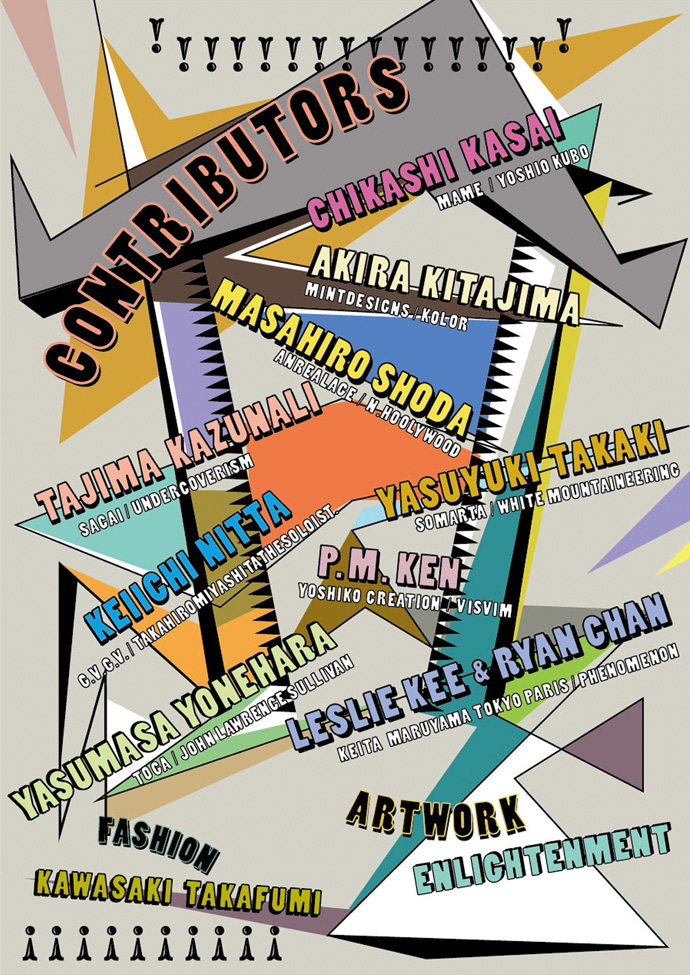 Poster of SAVE TOKYO CREATION by ENLIGHTMENT. Photography by Yasuyuki Takaki
Poster of SAVE TOKYO CREATION by ENLIGHTMENT. Photography by Yasuyuki TakakiThe 18 designers produced special pieces for the project to be auctioned for donation. Among the designers showing, is much beloved Jun Takahashi for UNDERCOVER, YOSHIKO CREATION, famous for her unique pieces to Lady Gaga, TOGA, N.HOOLYWOOD and emerging designer JOHN LAWRENCE SULLIVAN, among others as ANREALAGE, G.V.G.V., KEITA MARUYAMA TOKYO PARIS, MAME, MINTDESIGNS, SACAI, SOMARTA, KOLOR, PHENOMENON, TAKAHIROMIYASHITATHESOLOIST, ISVIM, WHITE MOUNTAINEERING and YOSHIO KUBO.
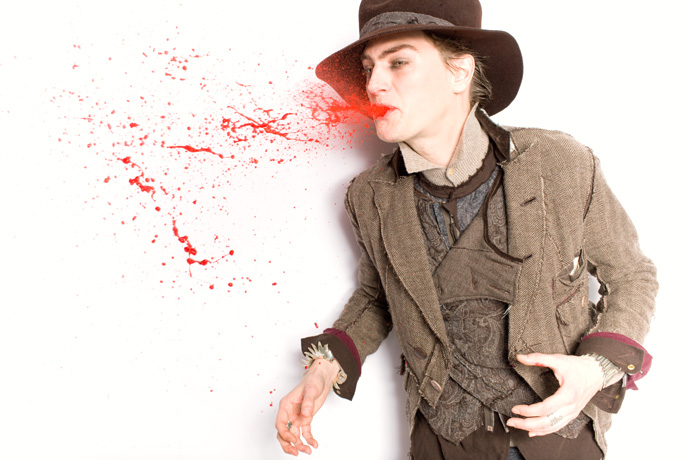 SAVE TOKYO CREATION Photography by Keiichi Nitta
SAVE TOKYO CREATION Photography by Keiichi NittaThe designers AW 2010 designs were picked up by Photographers and lensed especially for that show: Akira Kitajima, Chikashi Kasai, Tajima Kazunali, Keiichi Nitta, Leslie Kee & Ryan Chan, Masahiro Shoda, By P.M. Ken, Yasumasa Yonehara and Yasuyuki Takaki.
The Stimuleye spoke with Takafumi Kawasaki
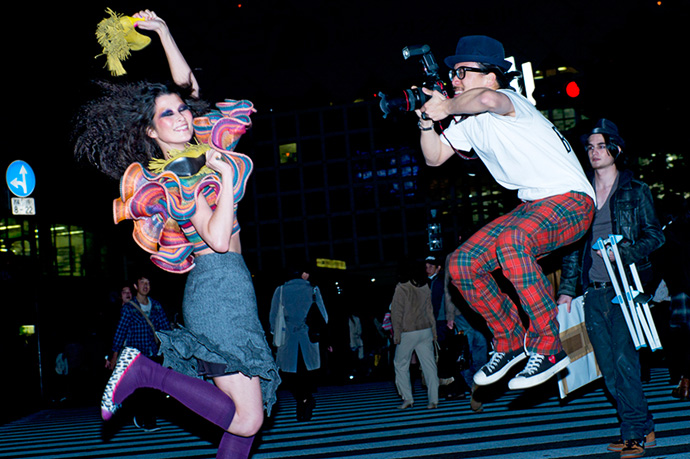 SAVE TOKYO CREATION Photography by Leslie Kee & Ryan Chan
SAVE TOKYO CREATION Photography by Leslie Kee & Ryan ChanRENÉ HABERMACHER: What was your intention with this exhibit?
TAKAFUMI KAWASAKI: SAVE TOKYO CREATION supported by NARS is a big feature of Japanese fashion designers, most of whom lost a chance to exhibit their 2011AW collection because of the earthquake impact.
It’s a charity but not a money-donated oriented.
I wanted to provide Japanese fashion designers a chance to show their 2011AW collection that could not be shown on catwalk because of the earthquake.
As a fashion director & stylist, I believe it is a form of charity that only I can produce to provide those designers with the opportunity to present their creation in public.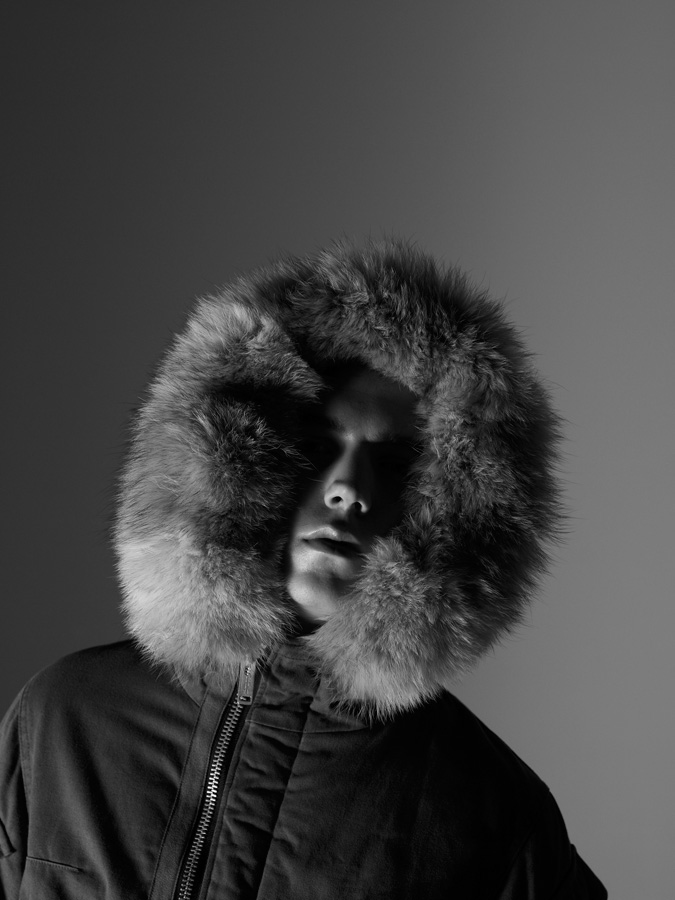
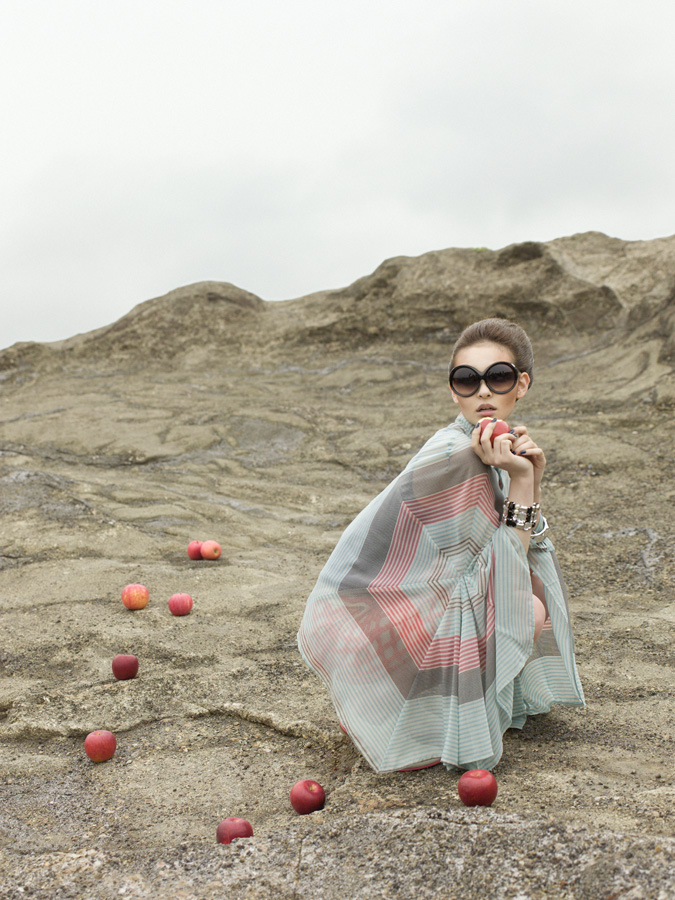 SAVE TOKYO CREATION Left: Photography by Kazunali Tajima. Right: Akira Kitajimat
SAVE TOKYO CREATION Left: Photography by Kazunali Tajima. Right: Akira KitajimatHow did the earthquake and its aftermath affect you personally?
The earthquake made me find the huge scepticism about Japanese government and the power of citizens. I would say I feel my approach to fashion and my styling works became more clearer and straight forward.
It may sound a little funny but I became more optimistic about the life. What already happened, happened, even if it’s a massive tragedy, there is no way to change or dismiss it. I feel there is no point to keep crying over that. But what we should do now, is to step forward.
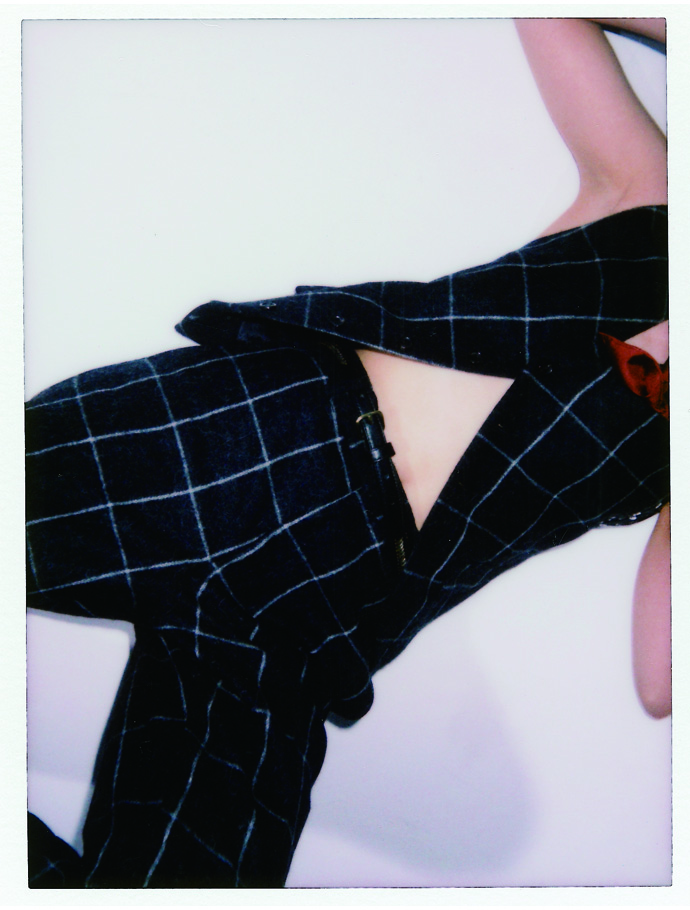
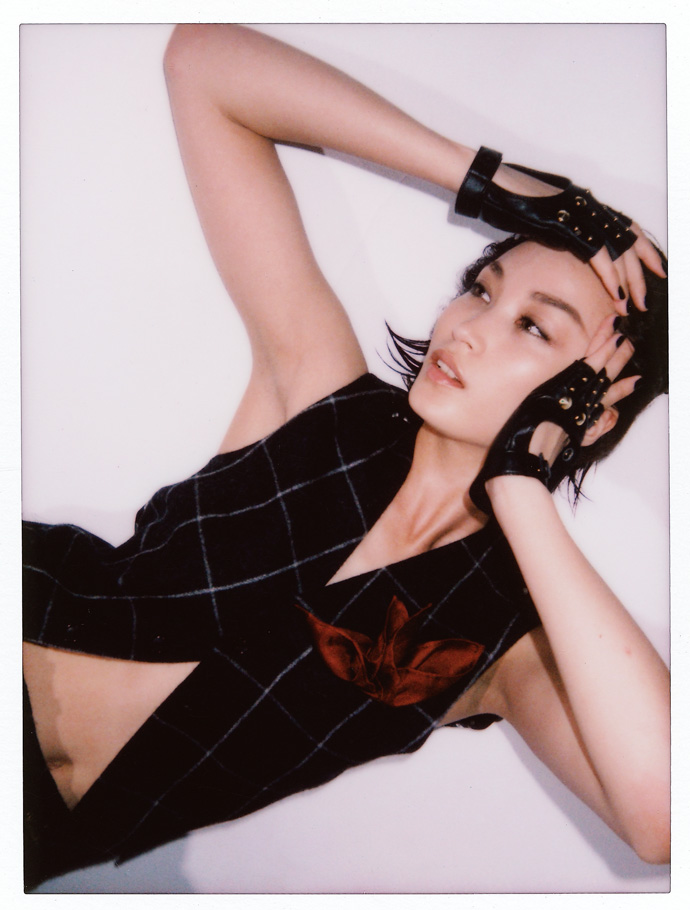 SAVE TOKYO CREATION Photography by Yasumasa Yonehara
SAVE TOKYO CREATION Photography by Yasumasa YoneharaDo you feel there is a different mood now among japanese society? I am asking as Japanese people expressing in the past to feeling alienated to their fellow countrymen…
Yes, “alienation” is a serious issue after the quake. Japanese people appear to be longing for the tightly-bound feeling.
Not only real communication and society, but also they are keen to make bonds with others in virtual community, such as Facebook, Twitter and other numerous social media networks. Some people are obsessed about that too much.Generally speaking, however, I think the Japanese people have found what is important and what is less in life. I believe this is a great chance to reform the typical Japanese convenience-oriented life.They appear to have started making their lives a little slower and calmer, too.
It’s really a big shift of the country.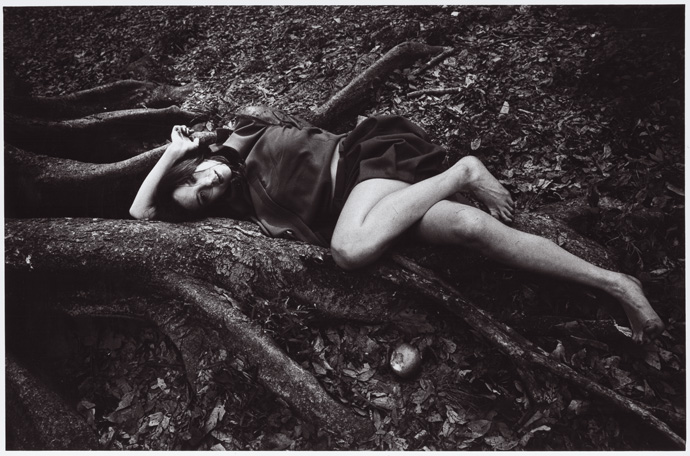 SAVE TOKYO CREATION Photography by Chikashi Kasai
SAVE TOKYO CREATION Photography by Chikashi KasaiWhat is the last thing that stimulated you?
I would say THE EARTHQUAKE in Japan.The exhibition is held from May 27th to 29th at EYE OF GYRE, Omotesando, Tokyo.
 SAVE TOKYO CREATION Photography by Masahiro Shoda
SAVE TOKYO CREATION Photography by Masahiro Shoda -

ATHI-PATRA RUGA: tales of bugchasers, watussi faghags and the afro-womble
-The ascension of young South African artist Athi-Patra Ruga came fast under radar of International attention.
His work, that is often characterized by a dislocated humor, is transcending the divides between fashion, performance and photography and interrogates the body in relation to society, ideology and politics, subverting the western ‘art library’ as he calls it.
The Stimuleye talks to charming Athi-Patra, who was recently featured in the Phaidon book ‘Younger Than Jesus’, a directory of the world’s best artists under the age of 33, about his work and influences.
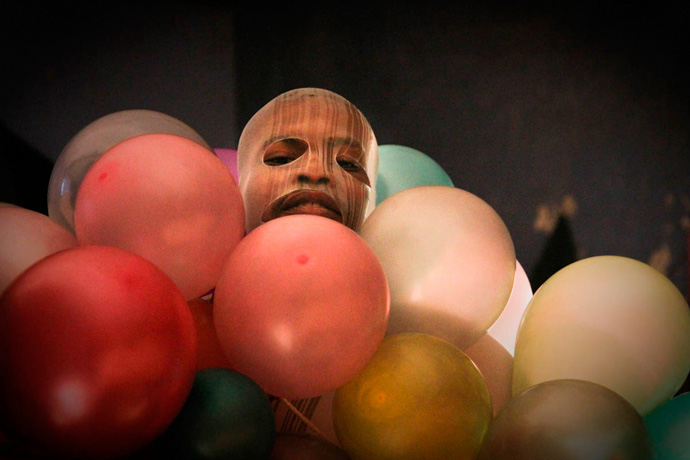 Athi Patra Ruga’s intervention for the X-Homes Hillbrow project with the character of ILUWANE.
Photography by Nadine Hutton
Athi Patra Ruga’s intervention for the X-Homes Hillbrow project with the character of ILUWANE.
Photography by Nadine HuttonRENÉ HABERMACHER: Where are you right now?
ATHI-PATRA RUGA: I’m in my Cape Town studio editing my latest tapestry series and fighting my cats… simultaneously. [laughs] I’m big on cat competitions… my two Russian blues Azange and Shadofax will be taking part so we have been grooming them like crazy… with a few scratches to prove it… hehe.
You’ve just came back from a break – have you got an idea already on what to work on?
At the moment I will be spending the next year creating quietly an extensive body of work revolving around a series of portraits that I will be rendering in tapestry. I have been doing a lot of sittings with various people and doing preliminary sketches. I am editing those now to get started in the next month. I was thinking of titles to name this body or the final exhibition etc: What do you think of :…the do’s and dont’s of bodyworship [laughs]
I am very interested in the power-relations involved in portraiture… especially in response to the ethnographic history involved. I am always concerned with who or what element in the image takes more precedents/importance… the technique or the seater or the artists ego. That argument in my head leads to some lovely renderings.
Your work is known to straddle the divides between fashion, performance and many more disciplines. What is your ultimate goal?
Transcending all boundaries that have been put on who and what one should create.
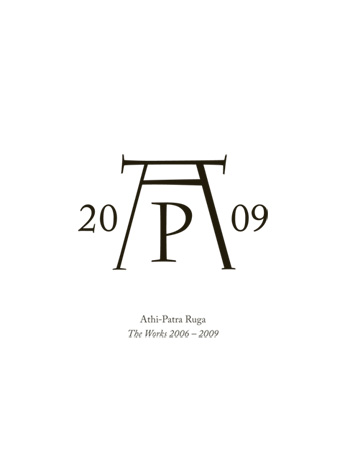
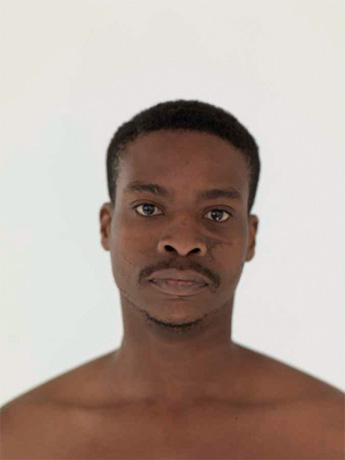 Athi-Patra Ruga's monogram and portrait photographed by Ant Strack
Athi-Patra Ruga's monogram and portrait photographed by Ant StrackThe monogram you use ‘AP’, seems to be derived from Albrecht Dürer?
Nice spotting, yes Dürer is the reference. A big part of the work is appropriation and ultimately subverting the “western art library”. In this case I am always interested in this “I am the one and only”, self-centric way of creating or rather I am totally disturbed by it. The logo is for Athi-Patra Ruga and studios cc. The name of my company and studio. The “and studio” part alludes to the idea that collaboration forms a big part of my practice. I would like to continue with this point.
Does Athi-Patra mean anything specific?
No, it’s a brand like others. And a brand is the highest promise of good quality and superior concept.
It’s two nicknames of my birth name. I’ve been called those names all my life really. It’s as old as I can remember.
So where does the “evil little boy”, as you called yourself come from?
Well I don’t know… I embrace my evils and vices I suppose. As to where it comes from, let’s just say there are a lot of boys and girls think so… at some points I tend to believe it. [laughs]
I was born in a Bantustan, which is a puppet state created by the apartheid government, a dictatorship. In March 1984, on my 13th birthday, Biggie Smalls died. My mom was a midwife, my dad a sports journalist. My parents were gone for long stretches of time and I had to defend myself. It seemed natural, it was one big ball of trauma. I grew up in the townships and during the strikes and boycotts. Many kids [or rather young adults] used to brutalise us for going to suburban/private schools. I spent most of my time indoors as many kids could not cope with me: I was violent in a violent time. Both at home and outside, the country was going through a revolution.
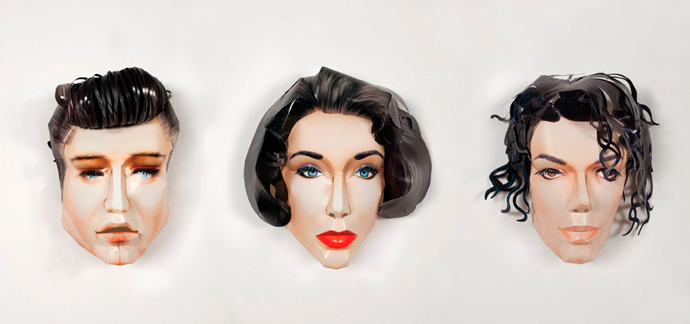 Athi-Patra Ruga: "Idol Death Mask Series" 2009, Modeled Paper, Approx. 27cm x 23cm each
Image courtesy of the artist and whatiftheworld gallery
Athi-Patra Ruga: "Idol Death Mask Series" 2009, Modeled Paper, Approx. 27cm x 23cm each
Image courtesy of the artist and whatiftheworld gallery -

MARIPOL
-Riding the Hoods with Maripol
Maripol, a Polaroid artist photographer for many decades, will show some of her work titled ‘Riding the Hoods With Maripol’ in her hometown New York. Maripol, the fashion stylist and designer, is best known for creating Madonna’s unforgettable material girl look. She also had an influence on the styles of many other artists of the time, including Grace Jones and Deborah Harry. Maripol moved to New York from France in 1976, where she became a part of the New York clubbing and music scene. In the early 1980s, Maripol was the art director for hip Italian boutique Fiorucci and later opened her own boutique, Maripolitan, in the NoHo area of New York. She directed the documentary film ‘Crack is whack’ on artist Keith Haring and worked as a producer on films such as ‘Downtown 81’ starring Jean-Michel Basquiat and featuring Blondie lead singer Deborah Harry.
Riding the Hoods With Maripol – Polaroid Exhibition. Opening on Wednesday, May 18 from 6-8pm at Clic Gallery, 424 Broome Street, New York. Maripol will sign copies of her books Maripolarama and Little Red Riding Hood at the opening.
-

HYERES ARE THE DESIGNERS
-Below our office window in the mythical Villa Noailles, people sprawl in the gardens, visit exhibits and discover new designers and photographers. Creative stimulation everywhere. The yearly invasion of Hyères, a sleepy town in the Côte d’Azur, is at its peak, with this micro-festival gaining even more attention by the international press.
On the secluded terrasse in front of us, Raf Simons, the President of this year’s jury, sits in the shade of an umbrella having conversations with numerous journalists, while simultaneously the crowds gather and mingle: headhunters, designers, buyers…
Christopher Kane is here, teamed up with Carla Sozzani of Vogue Italia, Jack and Lazaro of Proenza Schouler came in from NY to have a look at the 10 designers’ work.Its Hyères-storic.
All Photographs by René Habermacher
ODA PAUSMA
Netherlands“It’s very much about contrast: My work is always focused around the vulnerability of women. I play with it, I try to hide it or extend, to show it or protect it. This collection is really about my most vulnerable moment because I ended love after nine years of relationship. I thought I should speak about this in my own language which is fashion. In the beginning it was all black. But later on in the process I was getting better and was seeing the good things about my situation:
Life goes on and there is so much in the world, so I said to myself don’t worry so much! The world is sad enough, so bring some light!
So I brought that into the collection by using white and Swarovski elements and my favorite materials silks and leathers, to work the contrast between fluidity and the protective. The silhouette is very tall from the waist on, so it looks a little surreal and dramatic.”
“The last thing that stimulated me was just my surroundings I guess. I am having a lot of fun lately and I am really enjoying this festival: it gives me energy and I want to move on and work and do something with this feeling of being selected and being a little proud to be so. It’s a good feeling, so why not do something with it.”
JULIETTE ALLEAUME & MARIE VIAL
France“We always help each other on our own collections, but this is our first official collaboration.
We met in high school while studying for our baccalaureate in applied arts. After that we pursued fashion design in different schools–I was at Duperre and Juliette was at Chardon Savard. We lived one year apart and then moved in together in order work together. In fact, the collection that we are presenting in Hyères, is a collection that we made during the time that we shared an apartment.
As for the collection…our starting point was a scarecrow. Using the image of the scarecrow we started to explore the feminine silhouette. Eventually we turned this silhouette upside-down and reworked all of the different facets of it. We were also inspired by cubism so, in the collection, there is the idea of a double body–like one body superimposed on another. For example the shoulders have large proportions and are backwards, the skirts are divided in two and are skewed –so all of the body parts are somehow decontextualized. And we see the real body underneath or in the back, usually highlighted with bright colors. All of this creates disproportional, unhinged silhouettes. Plus, the wooden shoes for the collection create a strange walk”.
“The last thing that stimulated us — Well…the festival! And getting the chance to show our first collaboration. Since we were at different schools, we never had the chance to realize a project together and it is the energy of our duo that motivated us”.
www.artifactcollection.tumblr.com
MADS DINESEN
Denmark“I try to make a spirit army with no nations and no faces. My collection is a lot about shame and pride and the feeling of guilt.
It’s also about how to use the past in the present and the future and learn from it. This is my graduation collection. At the university in Berlin we do one each semester but this is the biggest one and the first with so many pieces. Though it’s a men’s collection, I showed it on women as well in the past.”
“The last thing that stimulated me was the film HOLY MOUNTAIN. That’s one of my favorite films. But right now I am looking a lot at Easter bunnies because I saw DONNIE DARKO. I use a lot of film and music in my work and literature.
Holy Mountain was part of the inspiration for this collection but mostly the colonial history of my home country Denmark. Because when I moved to Germany I found out I didn’t know anything about it, so the research for the collection started in Iceland. I went for a residency to Reykjavik and collected pieces of each culture that was under Denmark. It’s more like a typology of cultural pieces that I tried to put together.”
LEA PECKRE
France“The collection that I am presenting is the collection that I presented for my graduation at Lacambre last year. It’s called CEMETERIES ARE FIELDS OF FLOWERS. I am using a lot elements from cemeteries that interest me like wood, tombstones, mausoleums, bouquets of flowers, the contrast between wrought iron structures and the landscape. These elements, reworked in the materials used for the collection, provided me with really organic shapes–somewhat like trees that climb stones in the cemetery for example. There is a lot of embroidery in the collection as well.
Here in Hyères the defilés are much more structured then at Lacambre. But actually, my show at Lacambre was one of the more simple, subdued shows, so the Hyères show fits really well for me. I like when it is rather simple.”
“The last thing that stimulated me last: I want to finish my collection for Hyères! I am developing new pieces reworking some of the existing pieces and I think it will add a lot to the collection and that it will be better.”
-

25 Hyères + POP
-Less than one week before the launch of the 26th edition of the Hyères International Fashion & Photography Festival, The Stimuleye brings you “25 Hyères” covering the 2010 edition – including interviews of Dries Van Noten, Walter Pfeiffer, Olivier Lalanne, Théo Mercier and many others.
“25 Hyères” premiered on POP, where you can also read an exclusive interview.
THE STIMULEYE presents
25 Hyères
2010 Hyères International Fashion + Photography FestivalVideo and interview on THE POP.COM
A film by Antoine Asseraf
Music by
Lori SchonbergVoice-over by
Géraldine Frainais
James DeenyFilmed by
Antoine Asseraf
Jason Last
Yoann LemoineEdited by
Antoine Asseraf
NEUE / Axelle Zecevic
Yoann LemoineInterviews by
Antoine Asseraf
Jason Last
Diane Pernet -

everything you need to know about hyères in 2’6″
-One of our favorite events here at The Stimuleye is the Hyères Fashion & Photography Festival, held yearly at the Villa Noailles. Since 2007, each year the festival asks me to make a teaser to give a glimpse of the upcoming festivities.
There are always so many things happening simultaneously at the festival, that it’s hard to follow it all. This year shouldn’t be any different, with the addition of a new, long-in-the-making permanent exhibit about Charles and Marie-Laure de Noailles, the Villa’s inhabitants and art patrons.
So, because I thought it would be good to start at the beginning, go through the middle, and stop at the end, here’s everything you need to know about Hyères in 2 minutes 6 seconds to be ready for the 26th edition.
The Stimuleye crew will be going to Hyères…more to come soon. See you there ?
Hyères Fashion & Photography Festival,
April 29 – May 2, 2011
Villa Noailles, Hyères
Exhibits until May 29th. -

Out of the box: LEIGH BOWERY
-The other day i was going through boxes of photographs between sheltering sheets of cellophane. I came across a reminiscence from a time when I was obsessed with polaroids: a series of shots that I had taken from artist Leigh Bowery, in what was probably one of his last performances in late May 1994.
Leigh Bowery performing at the RoXY Amsterdam on May 17 1994. Polaroid by René Habermacher.
It was a party at the legendary RoXY club Amsterdam, with Boy George and Robert Owens on the turntables and leading clubbers Sheila Tequila and Stella Stein appearing, to the bemusement of the crowd, nude with pubic wigs only.
That Night Leigh Bowery presented his classc “Birth Show” together with Nicola Bateman-Bowery, whom he had married just 3 days before.As usual for Leigh, the performance, an homage to John Waters “Female Trouble”, would attack the spectators sensitivities- which even worked for the notorious Roxy audience: Leigh would appear to enter the stage in what seemed a rather conservative flower dress to sing with his band Minty, but toward the middle of the song birthed his partner Nicola, who was held under his costume upside down using a specially-designed harness. Nicola then appeared as a very large baby covered in placenta.Leigh died later that year on New Year’s Eve from an AIDS-related illness. A death bed pronouncement by “Modern Art on legs”, as Boy George commented, was: “Tell them I’ve gone pig farming in Bolivia”.
Leigh Bowery and his wife Nicola Bateman-Bowery, then freshly wed. Polaroids by René Habermacher.
It was one of these Spectacles that made the RoXY’s infamous reputation. Not only a club, the RoXY was an Institution. A playground and battlefield for artists. While mingling among the glitterati and club kids of the time I recall seeing there first time the work of Inez Van Laamsweerde and Vinoodh Matadin on a flyer- or a toilet exhibition of Erwin Olafs photographs, an explicit series that was was by far outreached by what was going on in these restrooms…
Founder Pieter Giele’s Motto AB IGNE IGNEM CAPERE (one fire ignites another) came true some years later. The Club that operated from 1987 in a splendid old theatre on Prinsengracht went up in flames the day of Pieter Giele’s Funeral in 1999 and burned down to the ground.
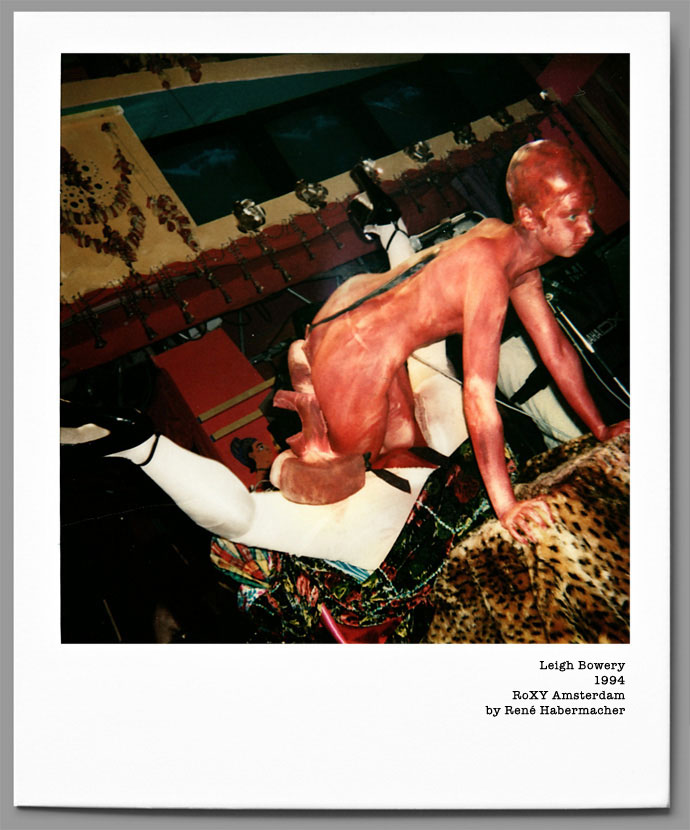
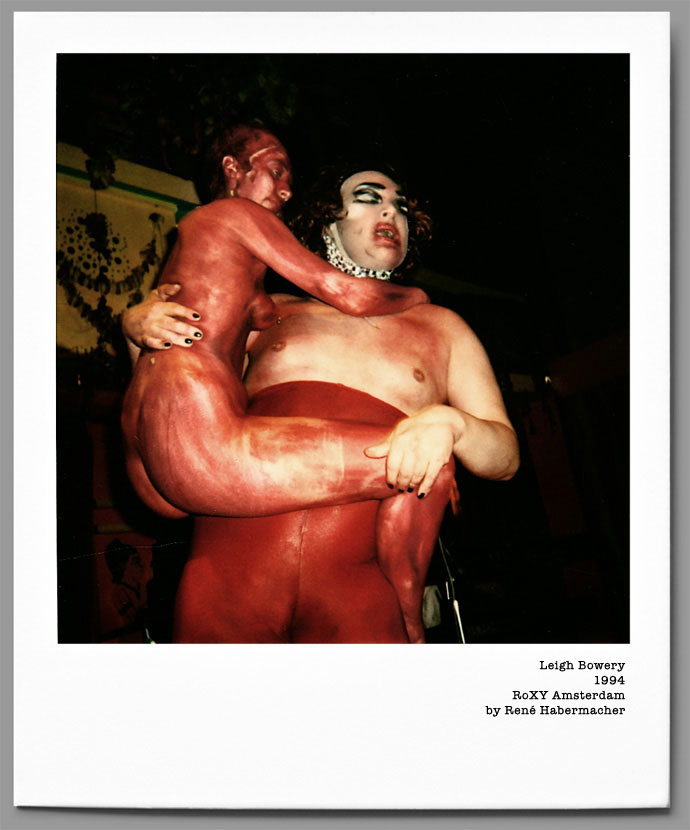
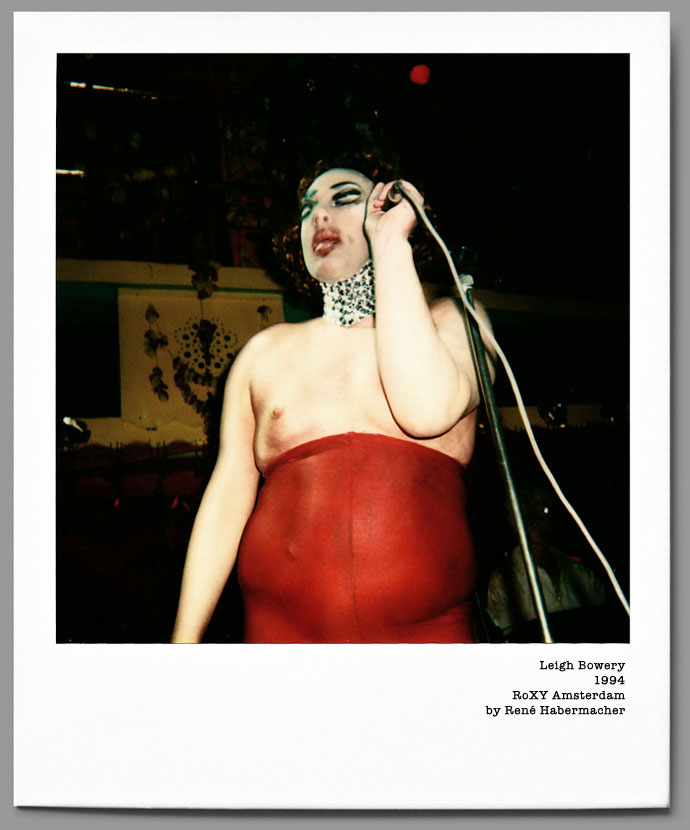
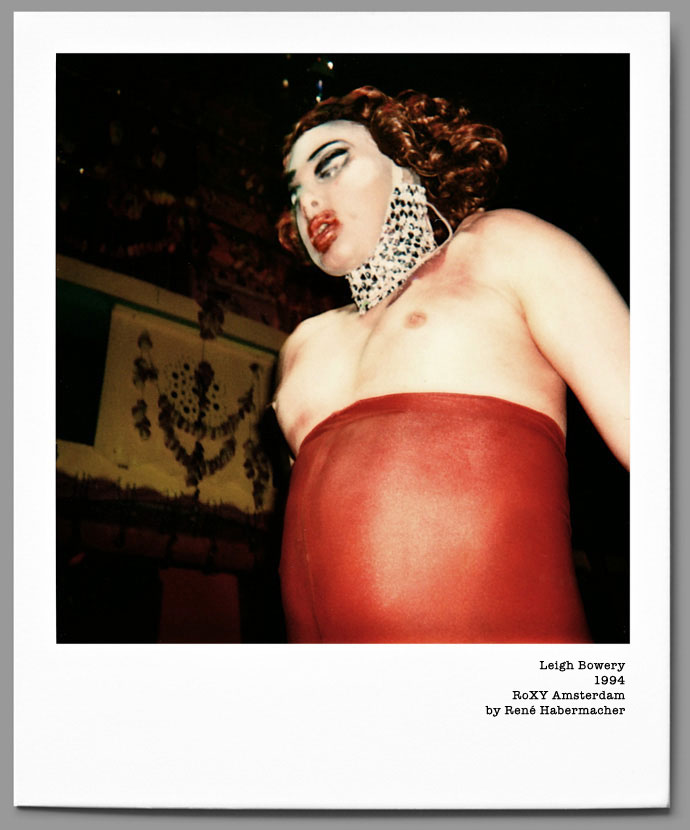
Leigh Bowery on stage with the MINTY. Polaroids by René Habermacher.An exhibition of photos by the club’s photographer Cleo Campert will be on show later this summer at the LUX Photo Gallery Amsterdam from 18 June – 18 July: The RoXY Years / De RoXY Jaren
Cleo Campert: “In this show I emphasize the open sexuality and the indecent exposure which reigned in the famous night club RoXY in Amsterdam in the early nineties.” -

NEW EYE : Marc Turlan
-The Stimuleye is proud to announce its new eye, created by artist Marc Turlan.
Preview of 25 HYÈRES film, directed by Antoine Asseraf.
I had the pleasure of meeting Marc Turlan in his atelier in 2007 when making the first teaser for the Hyères fashion and photography festival.
For what was to be his first solo exhibition, MANQUE (“lack”), Marc had prepared a series of sculptures based on magazines partially hidden under resin-masks. The result was very Friday the 13th.Then in 2008, Marc made a limited series of sculpted magazines, TORN MAG.
He carved magazines, as objects, blindly, until their substance was exposed. Since then, his work has evolved to ink drawing, laser cutting, metal beading… on magazines.Full view of the TORN MAG piece. 2008, courtesy of Gallerie Anne de Villepoix.
Last year, Marc returned to Hyères with a new exhibit inside a custom-made wooden bunker, SUMMER HOUSE, which is featured in the upcoming film “25 Hyères”.
Marc is now planning a book for May with Rue 89, and his first solo show at Anne de Villepoix in September 2011…
-

-

Lori Pauli | Behind the 19th-Century British Photographs.
-Lori Pauli is the Associate Curator of Photographs at the National Gallery of Canada, home to more than 25,000 photographs in a collection that started in 1967.
She has recently put together the exhibition 19th-Century British Photographs; the third in a series of five exhibitions of selected masterpieces of the collection of the National Gallery. This exhibition traces the development of photography in Britain over the course of the Victorian era; from early, salted paper prints, to daguerreotypes, to magnificent turn-of-the-century platinum prints.
I met Lori at a guided tour of the exhibition. Ann Thomas, also a curator at the National Gallery, whom I had met in one of the events I organized introduced me to her and we briefly talked about meeting up to chat about Mexican artists included in the collection amongst other things.
Not too long after we met and talked about astrophotography, the Moderna Museet in Stockholm, Ron Mueck, her twin sister and some of the cultural differences I have noticed while in Canada.
For my first contribution to The Stimuleye, I will be sharing some of the questions I had for her on the exhibition.
Miguel Batel: How did the idea for this exhibition came together?
Lori Pauli: Basically, with our drawings collection we started a series of exhibitions based on our holdings, so we decided for photographs we would do the same thing. The first one was modern photographs from the collection, then we did 19th-Century French, and after this it will be American Photography from 1900 to 1950.
The fifth probably will be either American 1950 to the present, or possibly our holdings of Canadian photography.
Will this exhibition be travelling?
It will, I’m not sure exactly where it’s travelling, we have had interest from across the country, and we are just deciding where its going to end up.
How many photographs did you have to go through, and how many are currently exhibited?
There are about 112 photographs in the show, and I think I went through 2,000 in terms of 19th-Century photographs from the collection, so there was quite a bit to choose from, which was great.
The exhibition features some of the earliest photographic techniques. Which are some of the photographs you would consider to be the most important?
Well, of course some of the earliest would be the daguerreotypes, and we have a really great daguerreotype, that is quite large format; I don’t know if you remember it, but its of a man called John Berret Nelson and its around 8” by 10”, its fairly large compared to what normal daguerreotype sizes are. It’s called a mammoth plate, its beautifully created – masterfully crafted- and it comes with its original frame as well, so that is a real gem in the collection.
In terms of British we have a lot of salted paper prints by William Henry Fox Talbot, so those are other also really important pieces, because that’s the inventor of paper photography, it’s really great to have those.
Are there any borrowed items?
No, it is all from the collection.
You acquired some photographs for this exhibition, any specially difficult one to get?
One of them was the piece of armour, we think its by a woman called Jane Clifford. She was married to Charles Clifford, who was the most important photographer working in Spain. He made a lot of use of Queen Isabelle II construction projects and he did use of her armoury and her treasures. We recently acquired that.
-

25 Hyères preview : Walter Pfeiffer
-The 26th edition of the Hyères International Fashion & Photography Festival is fast approaching, and soon our film on the 25th edition will be out. Here’s a quick preview, featuring a visit of Walter Pfeiffer’s exhibition by Michel Mallard…
Excerpt of upcoming film "25 Hyères". by Antoine Asseraf
Dries Van Noten, Steven Klein, Oliviero Toscani, Theo Mercier and much more in the full documentary.
26th Hyères Fashion & Photography Festival, April 29th – May 2nd 2011.
-

MATTHIAS VRIENS McGRATH EXPLAINS TO FILEP MOTWARY EVERYTHING ABOUT BL33N, HIS NEW PROJECT ALONG WITH HIS HUSBAND DONOVAN
-Its been almost a decade since Dutch magazine closed down and almost six years since my last official conversation with Matthias Vriens. In between and later, many emails regarding our personal news, ideas and hopes took place.
Matthias recently married to Donovan and since then, they both sign as Vriens-McGrath. For a while now I was informed about a new project they have been preparing, BL33N, but finally the mystery is solved, since our last night’s conversation..
BL33N (pronounced BLEEN) is a project by Donovan and Matthias which will oficially launch in May 2011. Since yesterday a rather tantalizingly sexy trailer hit the web in order to prepare us for what’s coming. Bl33n will be an online magazine experience, where all material shot by Donovan and Matthias as a team will support the t-shirts that they sell.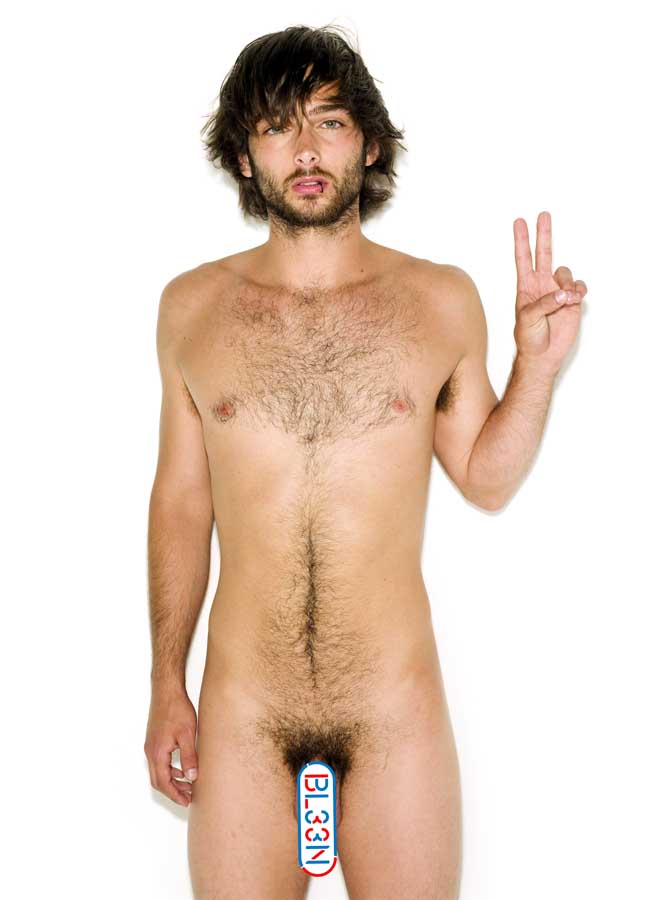 By Matthias Vriens-McGrath.
By Matthias Vriens-McGrath.The first collection is inspired by the body. Its design placed inside the shirt, when turned upside down will become a mask when worn over the face while others will include hair prints on shoulders and back that look like heavy metal or jewelry printed in mirror silver and latex. Printing technics will include latex, glitter. Their aim is to open up to a world wide collaboration of people connecting globally and will include a lot of world travel with the brand, while promoting freedom for all.
“Filep, free, freedom is something we take for granted and not available to all of us. Such an abstract, intellectual property, yet essential for all. We would like to promote freedom for all and with bl33n we intend to do just that. Part of our profit will go to promote freedom.”
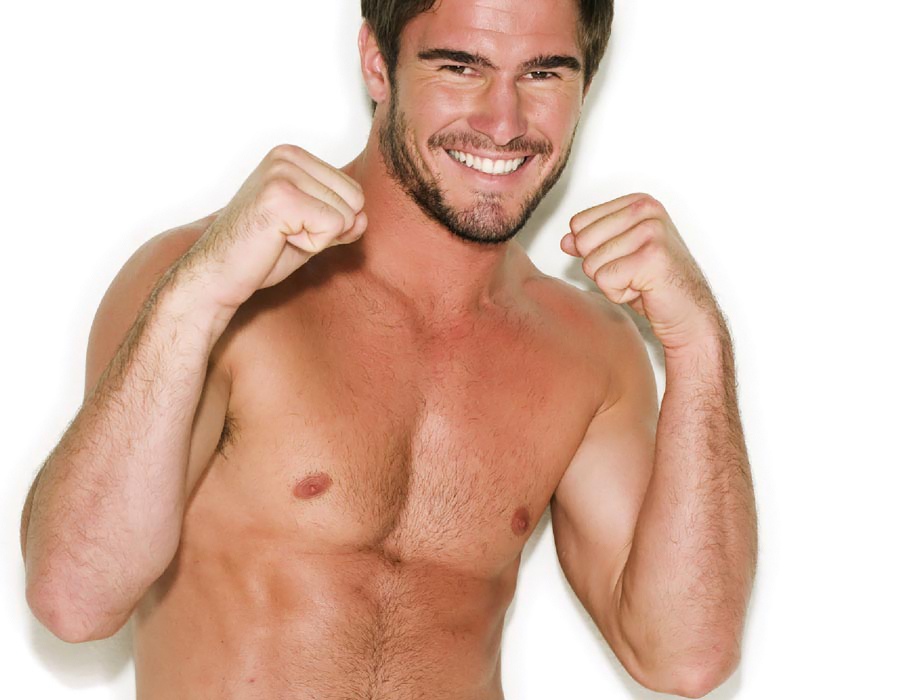
FILEP MOTWARY: So Matthias,how did you come up with the idea of BL33N?MATTHIAS VRIENS-MCGRATH: By accident via google, we found bleen, then bought intellectual property of bl33n.
You were one of the founders of published bible DUTCH MAGAZINE back in the late 90’s and early 00’s. How do you see yourself creating a web-platform?
We are just doing it… and take it from there. As we both have never been one to over-think or over intellectualize matters.
Whats the web’s real power today regarding fashion?
I believe pretty strong, information is scattered around in seconds, no where to hide. As horrid as it can be, once embraced it’s pretty cool and exciting.
Your new project along with your huspand surrounds a variety of actions including orthologic actions like promoting ideas like “freedom for all”. What do you really mean with this?
Our believes are visual delights and as simple as that might seem, the human body in all of it’s glory remains a struggle. Nudity as a metaphor for freedom and its something we all have, yet not available to all of us. Seems simple no…?
I would like to know more about the t-shirt collection you are preparing?
The first collection relates -again- to the body. Monster faces, printed upside down, inside out, become masks when pulled over your head. hair prints draped over back and shoulders printed in latex become ornamental, sculptural jewelry. There will be several collages-shirts that connect to the contemporary art world, while others are printed with the BL33N logo placed on parts of the body that become ‘questionable’
Are you thinking or extent it to a complete collection in the coming future?
Yes, both Donovan and feel strongly about underwear for example, but all in time…
-

kate moss as the night porter, take 1.
-Marc Jacobs’ tour-de-force ending for Paris Fashion Week, featuring handcuffs, elevators, and some obsessive ladies, almost made everyone forget about the Galliano debacle. The image now engraved in everyone’s mind is that of Kate Moss closing the Night Porter-style show, cigarette in mouth. But however powerful it was to see it live, somehow this image had already been floating in collective consciousness…
“Kate” by René Habermacher for Numéro Paris, Make-up by Linda Cantello.
Before he became a photographer, René Habermacher was as an illustrator — who was already a bit of a photographer. Numéro Paris, under the helm of Babeth Djian and Thomas Lenthal, frequently commissioned him fashion and beauty series made up entirely of photorealistic illustrations, “unreal” photos.
“Unreal” because there was no shooting, no camera. Only René, an idea, dozens of image references, hundreds of hours of drawing and airbrushing, and in this case, the advice of master make-up artist Linda Cantello, of Roxy Music fame.
So for this 2003 beauty series, René imagined Kate Moss as heir to Charlotte Rampling’s SS-cap-wearing and cigarette-smoking character from the 1974 film The Night Porter.
Where it gets interesting is that these images then found their way into the work of Terry Richardson (NSFW below), who thought that Kate was missing something else in her mouth…
(more…)
